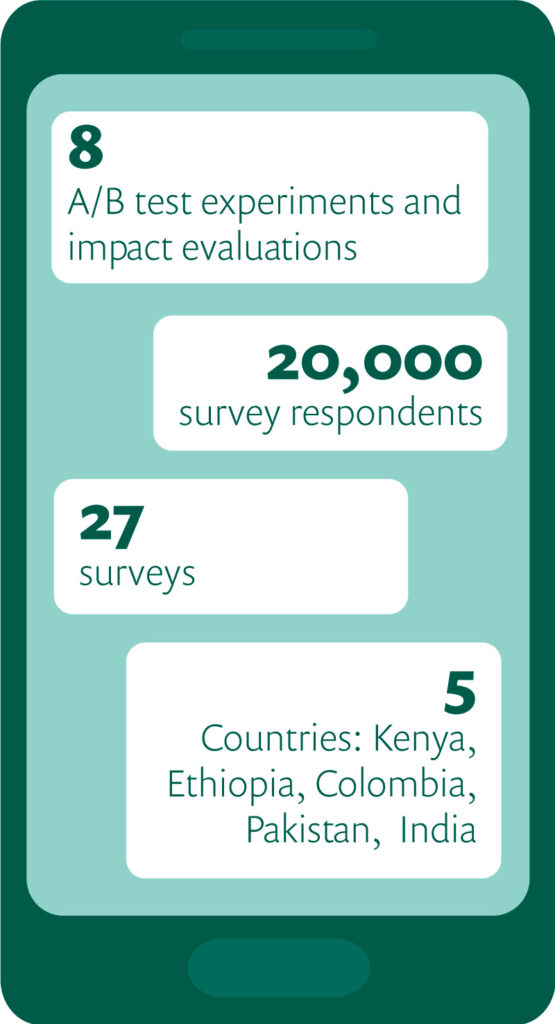
2022 was a tremendous leap forward for research at PxD. Our research and operations teams completed a total of eight A/B test experiments and impact evaluations. We collected data in person and over the phone from approximately 20,000 survey respondents in 27 distinct surveys that took place in Kenya, Ethiopia, Colombia, Pakistan, and three states in India.
We generated new insights to build future programming such as an SMS agro-dealer directory to reduce input market information frictions, built evidence-based proofs of concepts for innovative service design such as WhatsApp-based crowdsourcing chatbot and learned to leverage research partnerships for scalability with dairy cooperatives. We used research insights to shift and refine our approach and we are excited about further impact evidence from forthcoming analysis in 2023.
Devastating events in 2022 from drought in the Horn of Africa to the 100-year flood in Pakistan emphasize that climate change is one of the most urgent challenges facing our users. As such, we have intensified our research efforts to identify interventions that can improve smallholder livelihoods whilst incorporating climate adaptation and mitigation efforts into our existing services. We’ll continue this innovation research agenda in the coming year to explore high-value innovations to supplement our core digital agricultural advisory.
New insights to build future programming
Across a diverse portfolio of research projects, we have demonstrated the value of PxD’s services and contributed to an expanded knowledge base on digital agricultural extension. A particularly promising finding is establishing that digital tools can be effective in improving in-person extension services.
Performance goal reminders sent via SMS messages could increase extension volunteers’ performance: Through a large-scale randomized evaluation in Rwanda, we demonstrated that performance goal reminders sent via SMS messages – particularly goals that were ambitious but attainable – could improve community extension volunteers’ (known as Farmer Promoters – FPs) performance and therefore generate positive impacts on farmers’ outcomes. Sending goal reminders to FPs significantly increased the number of farmers trained by 3.1 percent, led to a significant 4.3 percent more training sessions being delivered, and increased farmers’ registration for subsidized inputs by 1.9 percent (statistically insignificant) over FPs who did not receive goal reminders. Given that the unit cost for each SMS is $0.006 and the average number of farmers assigned to each of the ~14,000 FPs across Rwanda is 190, the effect sizes of these messages are likely to be highly cost-effective.
The results of the Rwanda project support the expansion and replication of extension agent interventions in other settings targeting different populations in the future. In addition, these results point to areas for future research and development that could enhance the effectiveness of extension agent services. For example, we are interested in exploring how digital tools can be used to help extension agents set performance-increasing goals, direct them to farmers most in need, and extend information access to farmer populations that may not benefit from direct digital advisory services.
A digital directory of agro-dealers has the potential to increase the adoption of recommended inputs: In Kenya, we found evidence that farmers can benefit from the provision of an SMS agro-dealer directory by reducing input market information frictions. Our preliminary empirical findings suggest that – particularly for a directory that includes stock and price information about agro-dealers – access to this tool prompts farmers to refine their choice of agro-dealers before an in-person visit. Farmers in the treatment arm who had access to the agro-dealer directory and stock information contacted 21 percent more agro-dealers, but visited 4 percent fewer agro-dealers relative to the control group which did not have access to the tool. This suggests that farmers in this treatment arm used the contact information to call more agro-dealers before spending time and money to travel to the shops themselves.
Farmers given access to the agro-dealer directory were more likely to purchase PxD-recommended inputs and experienced fewer stockouts than those who didn’t have access to the directory. When pooling the two treatment arms, we observe that consistent with PxD’s advisory recommendations, treated farmers were 6 percent more likely than control farmers to use hermetic bags to store maize – a practice shown in rigorous studies like Ndegwa et al. (2016) to prevent post-harvest losses from pests. Farmers in the treatment arm with access to the directory but not stock info appeared to contact and visit agro-dealers at the same rate as the control group but then were 22 percent less likely than the control group to report facing an input shortage when they shopped (meaning they were more likely to find and purchase the product they were looking for).
Building on these promising findings, we hope to identify opportunities to further develop a scalable digital agro-dealer directory tool. Specifically, we are interested in exploring ways to onboard a large number of agro-dealers and update the stock information at a low cost.
Building proofs of concepts
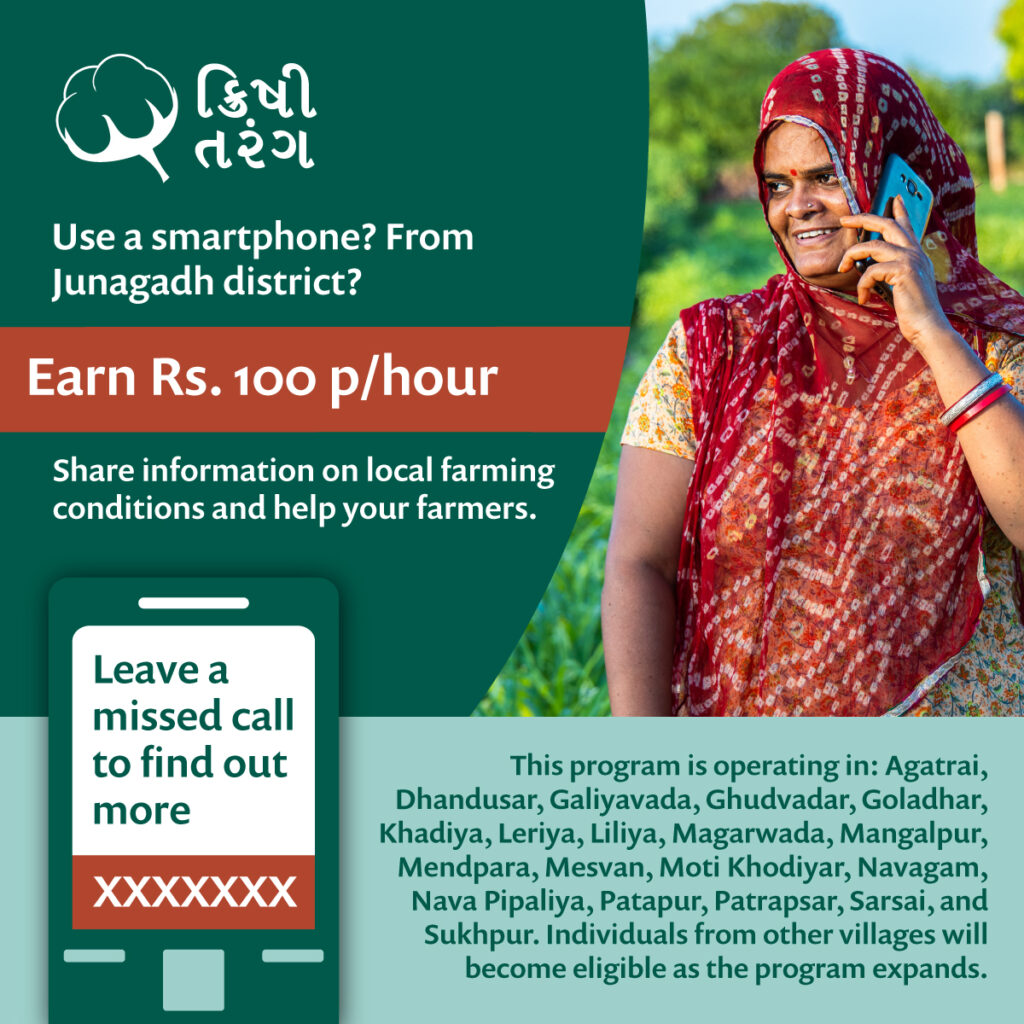
Digital peer groups increase farmer interactions and potentially increase the adoption of recommended practices, but we need creative ways to form groups at a low cost: Various research projects aimed to demonstrate proof of concept for novel interventions that PxD was exploring for the first time. For example, we now have empirical evidence that an intervention in Kenya to organize farmers into groups and send them SMS nudges to communicate with each other was effective at increasing both engagement with PxD’s service and communication between group members. Treatment farmers who were organized into digital peer groups had higher interaction levels than their control group counterparts and were 43 percent more likely to meet with their group members on a farm than control farmers. Interacting with one’s group members on a farm was also associated with increased adoption and knowledge of recommended practices.
A gig-worker model for crowdsourcing agricultural field photos has the potential to generate real-time data on field conditions: We acquired institutional knowledge, both technical and regulatory, to build and operationalize crowdsourcing platforms to demonstrate the feasibility of crowdsourcing information from agro-dealers and farmers in Gujarat. In a pilot, we set up a WhatsApp chatbot, integrating a WhatsApp Business Account with our in-house user communications platform, Paddy, to guide users through a systematic inspection of a field for crop health issues and send reports back to PxD with their findings.
Eighteen of our recruited farmer agents consistently engaged with the program over 10 weeks, with a median of nine crop health reports per agent. The quality of field reports was high – approximately 94 percent of reports are usable. In total, we received 220 field reports with accurate GPS locations and usable photographs. Each of these reports costs INR 125 (USD 1.67), which is substantially below the cost of a 15-minute phone survey. This suggests that crowdsourced data could be a cost-effective method of collecting local data.
PxD aims to further build this knowledge to crowdsource various types of information and use it to improve future service offerings by customizing advisory to be more locally relevant and actionable.
Working with smallholder farmers in the fight against climate change
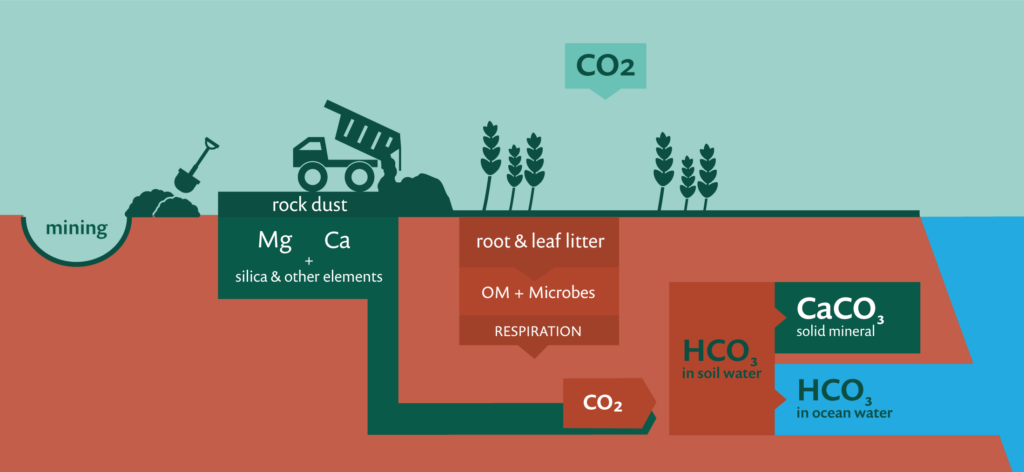
We are intensifying our efforts to provide information to smallholder farmers that will allow them to make informed decisions to reduce the risks that climate change presents to their livelihoods and to consider adopting practices that can actively reduce greenhouse gas emissions. We approach this work with the guiding principle of farmer welfare first: smallholder farmers cannot be expected to pay the price for climate change mitigation. Climate change-related advisory should directly support livelihood gains via improved agricultural output or renumeration .
PxD, in collaboration with the Institute for Governance and Sustainable Development (IGSD), worked to assess opportunities to benefit poor farming communities through their participation in climate mitigation activities and to direct tangible returns to participating smallholder communities.
The PxD-IGSD collaboration has focused on exploring four mitigation areas with most promise in agriculture: Carbon dioxide sequestration through enhanced rock weathering; Carbon dioxide sequestration with organic carbon storage in soils and plant biomass; Nitrous oxide mitigation through precision nutrient management; and Methane mitigation in dairy through improved livestock feeding practices.
- Enhanced rock weathering (ERW), an emerging technology that permanently draws down carbon from the atmosphere and has the potential for agricultural co-benefits makes it an attractive mitigation strategy in the smallholder farmer context.
- There is evidence that conservation agriculture practices that many farmers are already familiar with – such as reduced tillage, the use of cover crops, and intercropping – promote the sequestration of organic carbon in soils.
- In terms of nitrous oxide emissions, simple decision support tools following the Site Specific Nutrient Management approach, i.e. Leaf Color Charts (LCC), have been shown to reduce nitrous oxide emissions from nitrogen fertilizer use as well as improve farmer outcomes.
- For methane, improving feeding practices that increase milk production and closing the dairy yield gap in the Global South per cow can lower the methane intensity of production and contribute to methane mitigation, as well as improving farmer livelihoods.
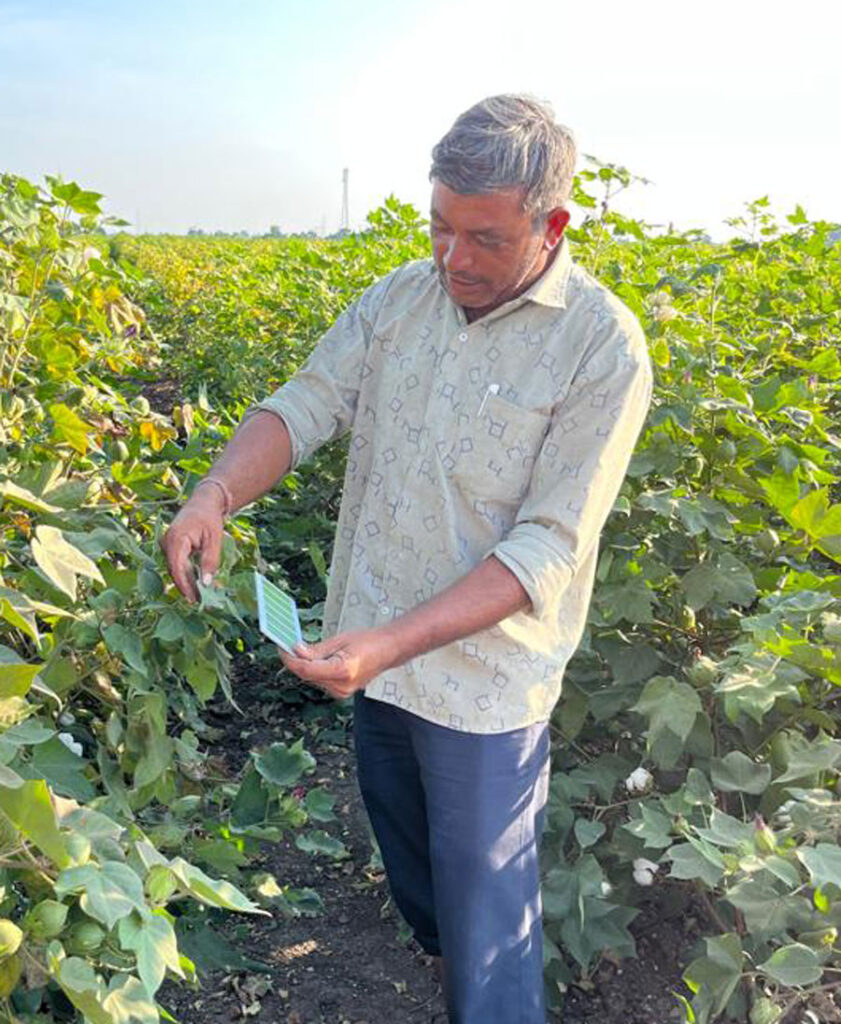
We’re excited to be on the cutting edge of exploring the potential of these climate change mitigation opportunities- like scoping a digital version of Leaf Color Charts to enable the tool to reach a wider scale and Advanced Market Commitments to incentivize R&D for enhanced rock weathering. Our research initiative with IGSD has enabled PxD to identify future activities within each opportunity area to advance climate change mitigation in the smallholder farmer context and we are actively pursuing partnership and funding opportunities to advance these activities.
Learning to leverage research partnerships for scalability
Partnerships have proven to be a critical pathway to increasing impact and scaling evidence-based programs across our project portfolio.
By collaboratively identifying and developing high-impact opportunities with dairy cooperatives in Kenya, PxD has identified a new partnership model in which PxD serves as a technical and analytical partner for innovating and testing service offerings for cooperatives, and builds cooperatives’ capabilities for generating greater impact at scale. We kicked off the partnerships with Lessos Dairy and Sirikwa Dairy by adapting an asset-collateralized loan product for water tanks which has been shown to dramatically increase access to water tanks among dairy farmers in a research study (Jack et al, 2022) and setting up an evaluation to measure its impact on economic and household outcomes.
In Gujarat, India we surmise that identifying low-cost and scalable approaches to crowdsource pest information will require leveraging local organizations and existing social networks for cost-efficient recruitment and training of agents.
To further explore opportunities to support women farmers in Gujarat, we successfully established partnerships that allow us to better understand the constraints women farmers face in engaging in economic activities and their access to information and other services. These partnerships allow us to design and implement group-based digital services to address those specific constraints.
Insights to shift and refine our approach
Our scoping activities allowed us to identify when a change in approach was needed or when interventions did not turn out to be as promising as we had hoped.
In the dairy sector in Kenya, we learned that existing market and coordination failures, such as credit constraints, need to be addressed to create an environment in which digital advisory can effectively improve smallholder dairy productivity.
In testing social learning mechanisms in Kenya, we did not find evidence that the designed intervention increased farmers’ knowledge or the likelihood of adopting recommended practices, despite finding that peer learning was effective at increasing both engagement with PxD’s service and communication between group members.
While subsequent qualitative interviews suggest that some farmers visited the farm fields of their peers and experimented with the recommended practices in a small portion of their plot, developing the digital peer group advisory further is likely to require a substantial investment in basic research to understand farmers’ social learning process and identify creative ways to reduce the relatively high costs associated with forming peer groups.
Finally, we learned to exercise caution in working with established women’s groups in Gujarat in a way that does not exacerbate local power dynamics within communities to ensure PxD’s services are designed in a sensitive way to promote the inclusion of marginalized groups that may face particularly challenging digital access gaps.
Looking forward to continue building our evidence base
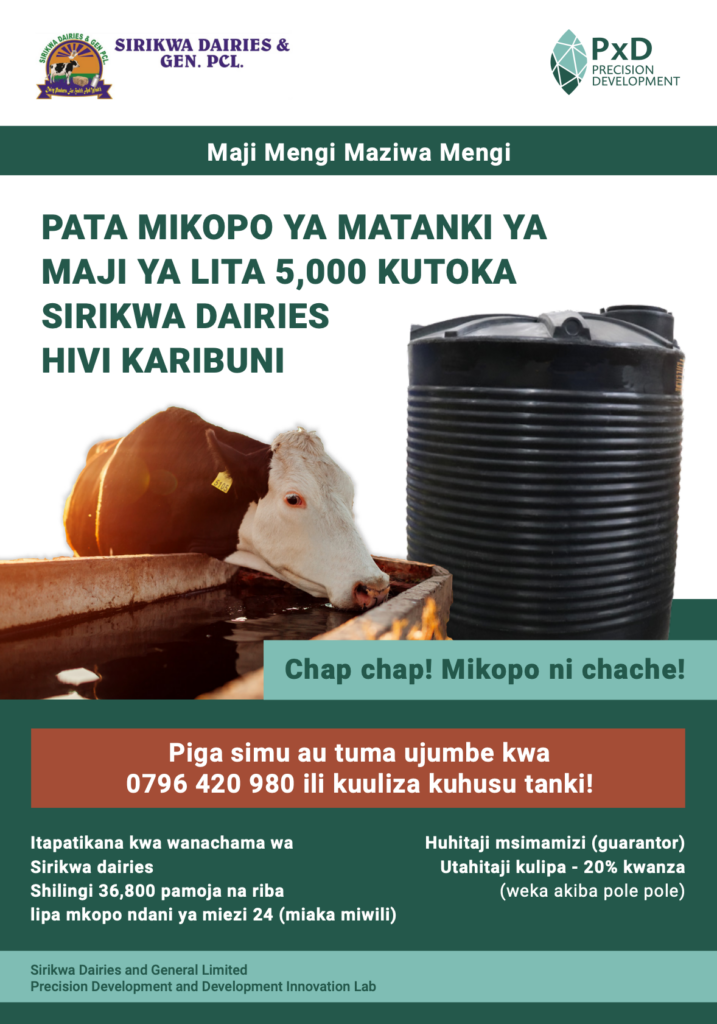
In the coming year we are looking forward to continuing to build our evidence base with forthcoming insights on PxD’s impact on farmer welfare from several large-scale RCTs in India, Uganda, and Kenya.
For the impact evaluation of our largest service offered to date for rice farmers in India, endline data collection and analysis are expected following the second season of implementation in 2023. In addition to outcome data on farmers yields and profits, we’re excited to generate additional insights on scalable measurement options for detecting yield changes among rice farmers using remote sensing data.
In Uganda, our work with coffee farmers enabled PxD to explore several dimensions of digital advisory, including comparing a stand-alone digital advisory service to the provision of digital advisory as a complement to in-person training and studying social spillovers from our advisory services. An endline analysis of the effects of this program will be forthcoming in 2023.
We are also excited to generate initial insights on the impact of asset-collateralized loans for water tanks on economic and household outcomes among dairy farmers in Kenya. Using frequent administrative data from dairy cooperatives on milk production, we’ll be able to understand how improved access to water tanks helps farmers mitigate productivity shocks and domestic water shortages as farmers adapt to more dry spells from a changing climate.
In addition to evaluation research with rigorous RCTs, we look forward to building out our research innovation agenda in the coming year. We are exploring a variety of new, evidence-based high-value product innovations that can build on our agricultural impact for smallholder farmers, such as interventions to facilitate market linkages and access complementary financial services. We are committed to using rigorous evidence and deep user research to identify and prioritize which ideas to pursue.
We look forward to sharing new insights with you throughout 2023! If you’d like to learn more or partner with PxD on specific areas highlighted please get in touch!
Paying people for actions that contribute to climate change mitigation, known as payment for ecosystem services (PES), has the potential to address both environmental and poverty alleviation goals. For example, there is a strong history of PES programs to reverse and slow deforestation in communities in the Global South. Emerging evidence of PES in the agricultural context also shows incentivizing smallholder farmers monetarily can be effective in encouraging behavior change for climate change mitigation.
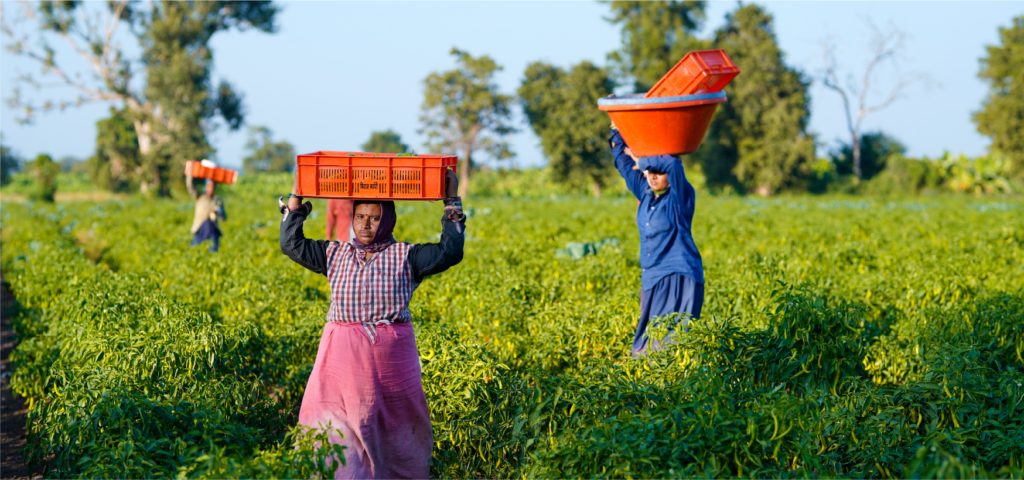
One way to finance PES programs gaining increasing interest from both the public and private sector is the voluntary carbon market, expected to be worth $50 billion by 2030. Connecting farmers to the amount of climate financing potentially available in the voluntary carbon credit market may help facilitate a sustainable agriculture transformation. However, a key variable still poorly understood is what the value of carbon credit prices should be to appropriately compensate farmers while also achieving carbon removal goals. The low and volatile prices of current nature-based carbon sequestration projects, ranging from $5–$15/ton of carbon from 2021 to 2022, can exacerbate the equity challenges PES programs face, especially in smallholder farmer contexts where ensuring procedural fairness and safeguarding the rights of smallholder farmer communities are critical.
There is currently little transparency into how prices for voluntary carbon market projects are determined, as well as the percentage farmers ultimately receive. As there is no standard system for carbon credit pricing, most pricing is determined between individual buyers and the specific project developer. If the buyer is a corporation that has set an internal carbon price, then there can be a degree of transparency in the price that the buyer is willing to offer for carbon credit projects. However, as the World Bank stated in a report on carbon pricing:
The market for credits from independent crediting mechanisms is heterogeneous, with buyers placing a range of values on characteristics such as the sector (e.g., type of activity), geography, age/vintage, and co-benefits of credits. While recent years have seen some moves toward offering standardized contracts…prices vary widely, with trading platforms offering contracts representing credits from different sectors.
There are also few voluntary carbon market projects available right now which involve smallholder farmers, which makes assessing the true price potential of these types of projects difficult.
Yet, the market is developing rapidly and the long-term vision for the sector will be to ensure standard processes (i.e. contracts, measurement, reporting, and verification (MRV) of climate change mitigation outcomes, etc) exist so buyers are certain of the carbon removals they are purchasing and the supply of carbon credit projects consists primarily of those for which carbon removals can be verified. The combination of the two will help ensure higher voluntary carbon credit credits in the future and any smallholder farming communities involved are appropriately compensated. A Bloomberg report estimates in a scenario where only verified carbon removals are allowed in the carbon market supply, “prices shoot up to $224/ton” by 2029.
There is another side to having prices this high, as the same report states that under this high price scenario, carbon credits may be seen as too expensive and be regarded as a “niche, luxury product” that few buyers can afford. However, while we may not want to be in a world where carbon credit prices are in the hundreds of dollars, it is clear there are fixable market failures in the current voluntary carbon market – information costs and transaction costs – which prevent smallholder farmers from getting full value for emissions reductions.
The Science Based Targets Initiative and the Voluntary Carbon Markets Integrity Initiative are examples of organizations working to advance rigor, transparency, and standardization in the voluntary carbon credit market. Higher and more stable prices will strengthen the power of the voluntary carbon credit market to provide equitable payments for ecosystem services programs for smallholder farmer behavior change.
Achieving such prices will require investment in the standard market process mentioned above which will improve the credibility and verifiability of carbon credit projects as well as make the voluntary carbon market a realistic pathway for smallholder farmers to increase their incomes by participating in carbon removals.
PxD published an analysis of the opportunities for smallholder farmers to drawdown of carbon which discusses both the evidence for such strategies (including conservation agriculture practices, agroforestry, and biochar) and the barriers to widespread implementation. We aim to leverage our scale – PxD services reached over seven million farmers in nine geographies last year – to continue to explore ways for farmers to engage in voluntary carbon credit markets and push for market developments which facilitate their participation. We welcome connections with organizations and funders who are also interested in such work so we may work together to improve both livelihoods and protect our planet.
PxD is collaborating with the Institute for Governance and Sustainable Development (IGSD) to identify opportunities to benefit poor farming communities through their participation in climate mitigation activities.
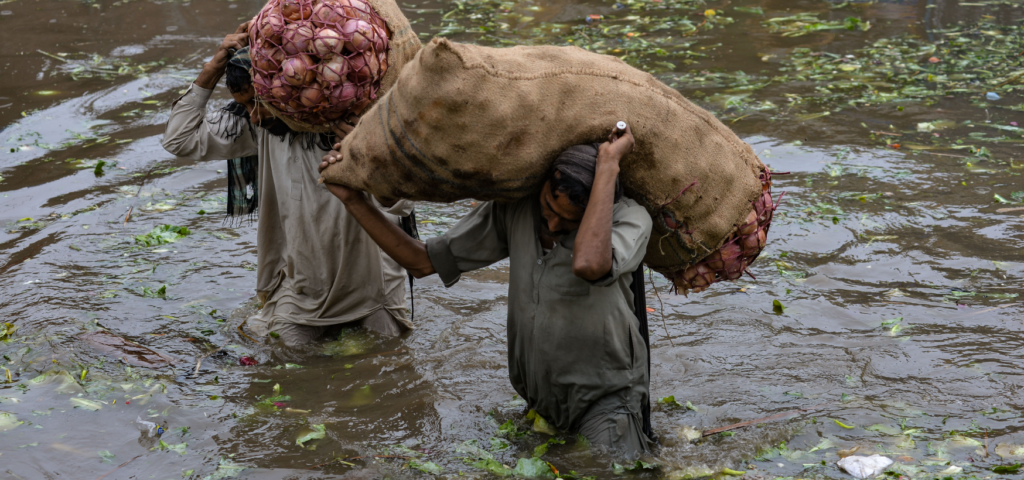
The 27th Conference of the Parties (COP 27) to the United Nations Framework Convention on Climate Change, is currently taking place in Sharm El-Sheikh, Egypt. COP27 has been dubbed the “African COP” due to its location as well as its strong focus on food systems and agriculture, both of which present pressing climate-related challenges for the continent and many other Global South geographies.
The adoption of improved inputs, new technologies, and practices enabled the agriculture sector to build many ladders for smallholder farmers to climb out of poverty, particularly following the Green Revolution. As yields have increased and farmers produce more than their families consume, selling surplus production has progressively increased farming families’ incomes, reduced the incidence of famine, and improved global food security.
Yet, from drought in the Horn of Africa to the 100-year flood in Pakistan, climate change is devastating smallholder livelihoods. Among its many pernicious effects, a warming climate will accelerate desertification and the incidence of drought, expose farming families and their animals to extended and escalated levels of heat stress, increase the incidence of catastrophic weather events, further erode the viability of marginal land worked by poor farmers, and contribute to the migration of new pests and disease, as well as the intensification of existing sources of blight and infestation in smallholders’ fields.
The impacts of climate change on agriculture are complicated by the fact that the agricultural sector is a significant emitter of Greenhouse Gases (GHGs), particularly methane – associated with livestock and rice production – and nitrous oxide – associated with nitrogen-rich fertilizers and animal waste. Recent estimates suggest that food production accounts for approximately one-third of global GHG emissions associated with human activities.
The effects of climate change, and agriculture’s role in generating GHG emissions, will undermine agriculture’s historic role as a critical engine for economic growth and lifting people from poverty. It is critical that we develop innovative solutions to combat climate change while assisting those who bear disproportionate effects. Marginal livelihoods will need to be further supported to adapt to a changing climate to mitigate the risk of deepening poverty. Concurrently, it is critical that we identify opportunities for poor farmers in low- and middle-income countries to contribute to emissions reduction to secure and advance their livelihoods.
In partnership with the Institute for Governance and Sustainable Development (IGSD), Precision Development is investigating opportunities that equip smallholders as agents of climate change mitigation and direct tangible returns, whether through payments for their environmental services or private agronomic benefits, to participating smallholder communities.
This work is guided by the following principles:
- Farmer benefit first: Smallholder farmers can not be expected to pay the price for climate mitigation. Climate-related advisory should support livelihoods and if it is difficult to understand a priori how a specific agricultural practice or technology might impact yields or income, we commit to exploring ways to compensate early adopters as payment for the broader social benefit.
- Consider the cost-benefit ratio: We aim to determine smallholders farmers’ private returns to the adoption of new technologies or agricultural practices, as well as the societal return of such adoption, as measured through the impact of these innovations on our main outcomes of interest in the climate mitigation space (i.e., GHG emissions).
- Replicate and Scale: We aim to deliver impact at scale. We are particularly interested in feasible low-cost innovations with a high potential for impact at scale that can be customized to local contexts.
The results of our investigations will be published as several analytical reports in the coming months. In advance of those publications, this post collates an overview of our findings about practices that are most likely to meet these criteria.
Carbon Dioxide Mitigation through Enhanced Rock Weathering (ERW)
Enhanced rock weathering is a new technology to draw down carbon that leverages the natural weathering process of certain types of rocks. Finely ground rocks are applied to soils to drive chemical reactions which capture atmospheric carbon and convert it into stable forms. This stable carbon then flows through groundwater into the oceans, where it can be stored for thousands of years. The application of ERW has significant potential for scale, and permanent carbon drawdown, particularly on agricultural land. However, the implementation of ERW technologies has been limited largely to study environments in high-income countries. Even in these contexts, market, scientific, and technical mechanisms for its successful deployment require further development (i.e. carbon crediting methodology). There is significant interest from climate financing organizations. For example, Frontier – an entity with significant backing from the tech industry – is pursuing an advanced market commitment to fund carbon removal through ERW. However, given the current focus of ERW development in Global North geographies in the absence of a concerted parallel effort in the Global South, it is likely that any future economic benefits accruing to farmers from ERW in the form of carbon offset payments will disproportionately benefit farmers in rich countries. Our research aims to shift some of these actions and benefits to include poor smallholder farmers in low- and middle-income countries.
Carbon Mitigation through Organic Carbon Strategies (e.g. Soil Organic Carbon (SOC) sequestration)
There is evidence that conservation agriculture practices – such as reduced tillage, the use of cover crops, and intercropping – promote the sequestration of carbon in soils. However, the outcomes of SOC sequestration as a mitigation strategy and the exact amount of carbon stored by different types of soil and under different climatic conditions are still being investigated. For example, because the carbon and nitrogen cycles of soils are closely intertwined, increasing SOC requires sufficient nitrogen. However, increasing nitrogen in soils can create conditions for the leakage of nitrous oxide, which could offset SOC gains.
Conservation agriculture practices such as SOC sequestration do not facilitate permanent carbon drawdown and must be implemented continuously to sustain carbon sequestration, an important consideration when assessing SOC’s potential for persistently increasing carbon drawdown over time. Due to these constraints, there is a growing scientific consensus to emphasize the soil health benefits (i.e. bulk density, improved water retention, etc) and farmer outcomes (i.e. yields, profits) associated with these conservation agricultural practices, rather than solely their carbon sequestration potential. The productivity gains associated with improved soil health can be significant, especially for balancing climate change mitigation goals with global food security needs.
Another potential benefit of SOC sequestration interventions is the connection to nature-based carbon credit projects which can provide smallholder farmers with payment for their mitigation efforts. However, while many SOC-sequestration-based voluntary credit market projects exist (for example, Indigo Ag), the absence of standardized measurement, reporting, and verification (MRV) protocols for climate outcomes (like the amount of carbon stored), remains a challenge. This absence of MRV protocols makes it difficult to compare and evaluate the efficacy of SOC-based mitigation interventions, and – as a consequence – complicates efforts to create high-quality credits with higher prices for optimal farmer payout. Moreover, accurately measuring SOC sequestration is likely to require soil sampling, an expensive enterprise with negative implications for the cost-effectiveness of SOC sequestration projects. Concurrently, prices for nature-based projects in voluntary carbon market regimes are low and volatile which may limit the effectiveness of payouts to farmers.
Ensuring that organic carbon strategies, such as SOC sequestration, meaningfully contribute to mitigation, will require coordination and mutual investment in MRV protocols and pathways and careful consideration of the ways in which carbon mitigation projects impact small farmers’ bottom lines.
Nitrous Oxide Mitigation through Precision Nutrient Management
Emissions of nitrous oxide from human activities are primarily driven by inefficient nitrogen fertilizer use in agriculture, particularly overuse. One mitigation strategy with proven potential for reducing nitrous oxide emissions as well as improving farmer outcomes is Site Specific Nutrient Management (SSNM), mainly through decision-support tools like Leaf Color Charts (LCCs). These tools enable farmers to make more informed decisions about the management of nitrogen fertilizer applications based on site-specific needs and their own environment, reducing the overuse or underuse of N-based fertilizers. There are notable considerations to address in scaling and operationalizing these tools, including their calibration across value chains and agroecological conditions, instruments distribution channels, and user experience. PxD gained first-hand experience deploying LCCs on the ground during the implementation of a pilot project to test their effectiveness in Gujarat, India. We are working to find innovative solutions, such as creating a digital LCC, that can reach farmers at scale. Further experimentation and farmer-led innovation will help to address these challenges and increase the use, and subsequent impact, of SSNM decision support tools which have proven potential for nitrous oxide emissions reduction.
Methane Mitigation in Dairy through Improved Livestock Feeding Practices
Milk yields in low- and middle-income countries are significantly lower than their potential, resulting in high methane emissions per liter of milk. A key mitigation strategy to curb methane emissions in livestock farming, particularly for large ruminants like dairy cows, is to improve feeding practices that increase milk production per cow and lower the methane intensity of production. Coupled with a decrease in herd sizes, an increase in milk productivity can decrease net methane emissions in the dairy sector and relieve the overall land pressure of livestock, which can further mitigate GHG emissions. Studies examining the mitigation potential of various livestock interventions underscore the significant potential of improved feeding and digestibility compared to other strategies like manure management, rangeland rehabilitation, and the use of feed additives. For example, in India, the world’s largest producer of milk, improving livestock feeds for local cattle breeds can double current milk yields. Findings from PxD research with smallholder farmers in Kenya suggest that there are significant knowledge gaps about ways to improve livestock feeds, including available methods, some of which are already implemented by peers (i.e. feeding cows sweet potato vines, napier grass, etc). Coupling the optimization of feeds for dairy cows with a parallel effort on market development will not only provide farmers with the tools to intensify production, and thereby mitigate methane emissions, but also generate incentives to do so.
Future Work on Climate Mitigation at PxD
Poor smallholder farmers should have the same opportunities as farmers in high-income countries to be rewarded for contributing to climate change mitigation. PxD is working to identify high-impact opportunities for climate change mitigation that leverage local knowledge in low- and middle-income countries as well as our expertise to combine at-scale product development, behavioral science, and human-centered design with robust experimentation. We are particularly interested in exploring climate financing mechanisms and MRV protocols that bridge the environmental efforts of smallholder farmers and global climate finance.
In the past year, systems built and developed by PxD serviced over seven million farmers in nine geographies. We aim to leverage our scale to generate sizable impacts to reduce GHG emissions associated with smallholder economies. As we do so, we aim to benefit farmers working in the service of mitigation, be it in the form of private returns or payments for environmental services. In pursuing these goals we will need to partner with nonprofits and research institutions to develop robust mitigation programs. We welcome connections with organizations and funders who believe – like we do – that there are opportunities for smallholder farmers to actively mitigate climate change, and that by activating these opportunities, we can add new agrarian ladders out of poverty to those that have come in decades and centuries past.
**this text was amended to include new information on 22 November 2022
Accurate, medium-range weather forecasting information can help mitigate smallholder farmers’ exposure to climate-related risks. PxD is in the process of launching new products to assist smallholder farmers to make more informed and timely decisions based on weather information. In this post, we outline the contours of our exploratory research to integrate weather forecasts into Coffee Krishi Taranga (CKT), our existing digital advisory service for small coffee farmers in India.
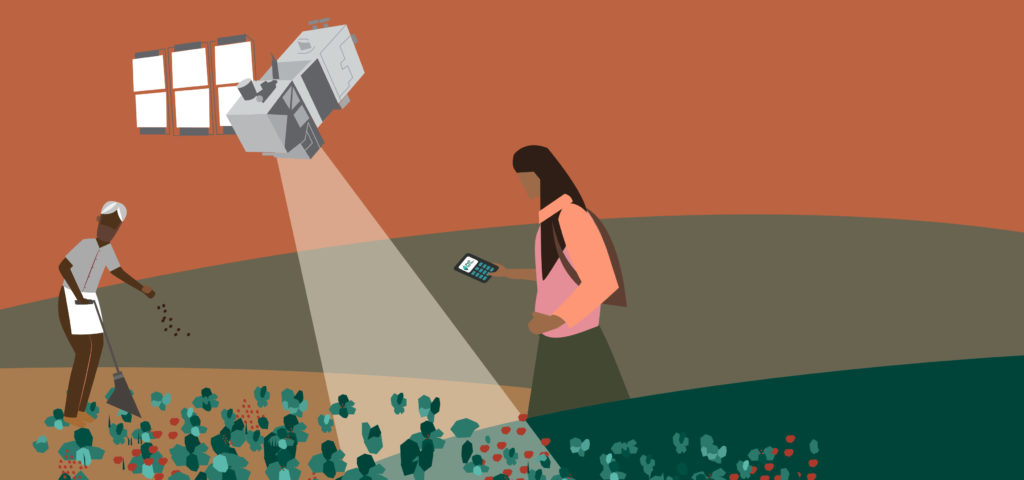
Coffee is a notoriously fickle crop. For example, heavy rainfall can damage crops, result in premature fruit-drop, increase the incidence of pests, and wash away fertilizer with negative implications for plant nutrient levels. Increasing weather variability and the incidence of extreme weather events associated with climate change will have significant negative effects on coffee producers. Given the sensitivity of the crop — and yields — to fluctuations in the weather, coffee farmers are likely to derive meaningful benefits from accurate and timely weather forecasts. Insights from our CKT learning agenda will be used to inform the design of a larger evaluation of the weather-integrated service and to scale an enhanced service to over 150,000 coffee farmers across four Indian states (Karnataka, Kerala, Tamil Nadu, and Andhra Pradesh – an expansion state).
The motivation
PxD delivers CKT in partnership with the Coffee Board of India and with support from the Walmart Foundation. Since 2018, CKT has delivered a two-way interactive voice response (IVR) service with two principal components: an outgoing push call service that provides regular advisory to coffee growers via their mobile phones, and an inbound hotline that farmers can call to access free information services. In April 2022, CKT reached just over 70,000 smallholder coffee farmers in Karnataka, Kerala, and Tamil Nadu.
More accurate information about medium-term rainfall — with a lead time of up to 15 days — will enable farmers to make informed decisions about applying nitrogen fertilizer and increase the likelihood that they apply this input during dry spells to reduce run-off and leaching. Similarly, if farmers are alerted to impending heavy rain, they can leverage this information to alter harvesting times or take other precautionary measures to protect crops and insulate yields.
Speaking to farmers to inform design and process
In interviews conducted with coffee growers in August 20211 Described further in an earlier blog post that outlined findings from the landscape analysis of coffee production in Karnataka and Andhra Pradesh relating to sustainability, market linkages, and gender., only 16% of respondents reported accessing forecasts (N=73). Integrating weather information into CKT’s existing services will broadcast weather forecasts to farmers tailored to their specific contexts and complement these forecasts with agronomist-designed advice. Exploratory and pilot research will be implemented between May and December 2022 in three important coffee-growing districts in Karnataka: Chikmagalur, Hassan, and Kodagu.
Studies conducted in other contexts find that farmers form subjective expectations about upcoming weather events based on various factors, including their past experiences, local rules of thumb, existing forecast information, the costs and benefits of acquiring such information, and perceptions about how relevant weather-related risk is to their incomes2As demonstrated in Giné, X., Townsend, R.M., & Vickery, J. (2015). “Forecasting When it Matters: Evidence from Semi-Arid India.” Working Paper.. These expectations inform behavior over the course of the coffee crop cycle as farmers make decisions relating to input and investment choices, the timing of activities, and so on. The sum of these decisions, in turn, influences outcomes that farmers (as well as researchers and practitioners) are interested in – notably plant health, yields, costs, and profits. The goal of this research is to understand each of these elements through measurement and service pilots, A/B tests, qualitative interviews, and in-person workshops with farmers, agronomists, and extension agents.
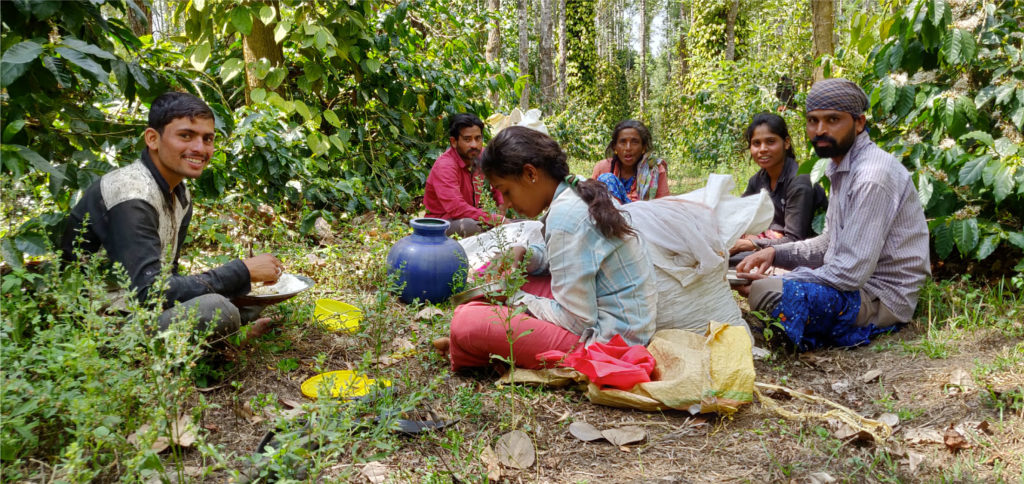
Coffee laborers having lunch on a coffee farm.
Iterating relevant service design and a weather service at scale
Commencing in May 2022, we will conduct multiple rounds of in-depth qualitative interviews with men and women coffee farmers. The sample will include farmers working a range of landholding sizes and will include both smartphone and feature-phone owners. The objective of the first set of interviews is to better understand how coffee farmers make decisions relating to the timing of agronomist-identified, weather-dependent coffee activities: fertilizer and lime application, coffee pruning, shade regulation, and harvesting. We hope to identify how weather fits into these decisions and what other factors influence the timing of these activities. If other limiting factors (such as the availability of an input) impact timing to a greater extent than the weather, forecast information with short lead times may not help farmers optimally time their practices without access to complementary inputs or information. These interviews will also help us identify how farmers interpret weather forecasts they already have access to, what impact incorrect forecasts have on their activities and on their trust in forecasts and the extent to which farmers discuss their expectations of upcoming weather with other members of their communities.
As detailed in previous blog posts about our weather-related work, PxD is partnering with leading private forecast provider CFAN (Climate Forecast Applications Network) to develop calibrated custom forecasts. Using weather forecasts from CFAN provides access to a continuous stream of information, which includes the numerical quantity of a rainfall event being forecast, numerical probabilities associated with a forecasted weather event, and error margins on the quantity of rainfall forecast for each of the upcoming 15 days3Read more about our collaboration in this previous blog post. Building on the first set of qualitative interviews, we plan to assess (1) whether farmers comprehend and have an appetite for probabilistic and uncertain information; (2) whether specific forecast attributes or lead times meaningfully change farmers’ expectations of upcoming weather; and (3) which combinations of attributes and lead times aid decision-making for each weather-dependent activity. We plan to gauge farmers’ understanding of probabilities and uncertainty in a second set of in-person interviews to whittle down the forecast formats that will be most useful in this context.
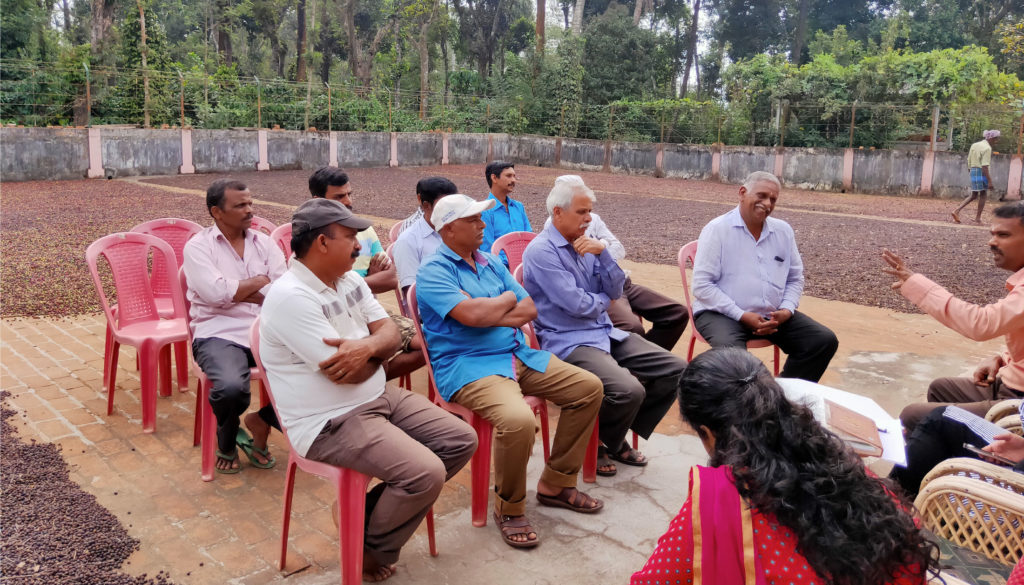
PxD facilitated Interviews with coffee growers.
Coffee farmers in a subset of villages in our three study districts will then be invited to participate in in-person workshops, where they will interact with different forecasting formats. The workshop will be in the form of a ‘lab-in-the-field experiment’, where participants engage with an interactive platform that presents weather forecasts together with incentivized agricultural decision-making scenarios. Utilizing participants’ decisions on the platform, an ‘in-scenario’ weather ‘realization’ will be simulated, allowing participants to accrue a higher payoff for a ‘better’ decision. The best-performing forecast will accrue the highest cumulative payoff across participants and will inform our understanding of which forecast formats most effectively aid decision-making. The ‘best-performing’ customized-to-context weather forecast will then be piloted in the field among a sample of existing CKT users to evaluate whether it improves decision-making in a real-world setting.
Delivering an effective weather-based advisory service via mobile phone also requires that we ensure that users engage with and use the information being delivered. To this end, we plan to run A/B tests to optimize the frequency with which weather forecasts are delivered, the length of messages, and other service features.
We are optimistic about the utility of weather forecasting information and its potential impact on smallholder farmers — and their productivity — as they make what we hope will be more informed decisions. We are excited to deploy this information and make it actionable for smallholder coffee producers on our CKT service. Watch this space!

Precision Development (PxD) has completed a landscape analysis to more systematically understand the challenges faced by users of the Coffee Krishi Taranga (CKT) service, with a focus on three core areas, namely, sustainability, market linkages, and gender. This work was funded by a grant from the Walmart Foundation.
As part of the landscape analysis, we conducted multiple rounds of farmer interviews, an extensive review of the literature, an analysis of our existing farmer database, and interviews with sectoral experts. In this blog, we share some key findings and information about what we’re looking to do next.
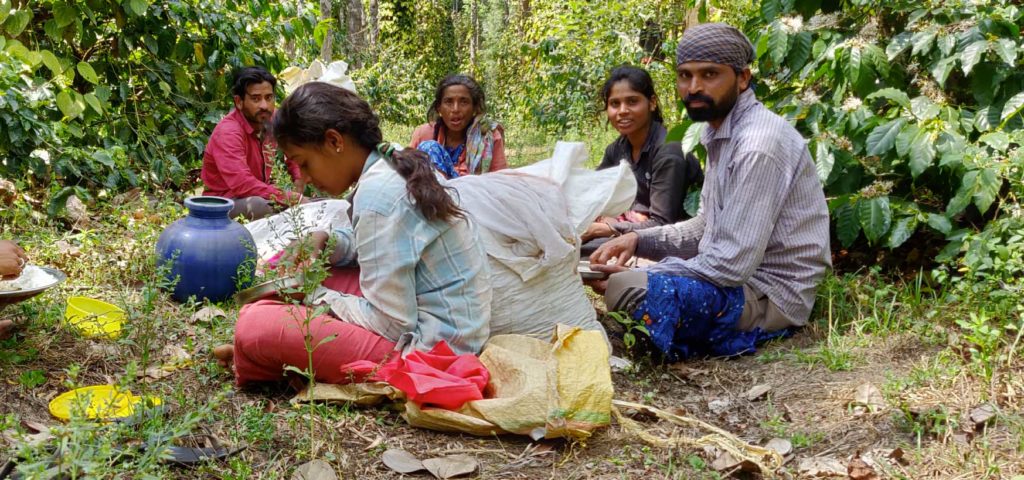
Coffee Krishi Taranga
Since August 2018, PxD has partnered with the Coffee Board of India to provide the CKT service to coffee growers. The CKT service is modeled on PxD’s flagship two-way Interactive Voice Response (IVR) service, which comprises an outgoing service that provides regular advisory to growers on their mobile phones and an inbound hotline that farmers can call to access free information services, including market-related information, and leave messages to be answered by agronomists. As of April 2022, the CKT services approximately 74,000 coffee growers across the states of Karnataka, Tamil Nadu, and Kerala. The team plans to expand the reach of the service to growers in Andhra Pradesh soon.
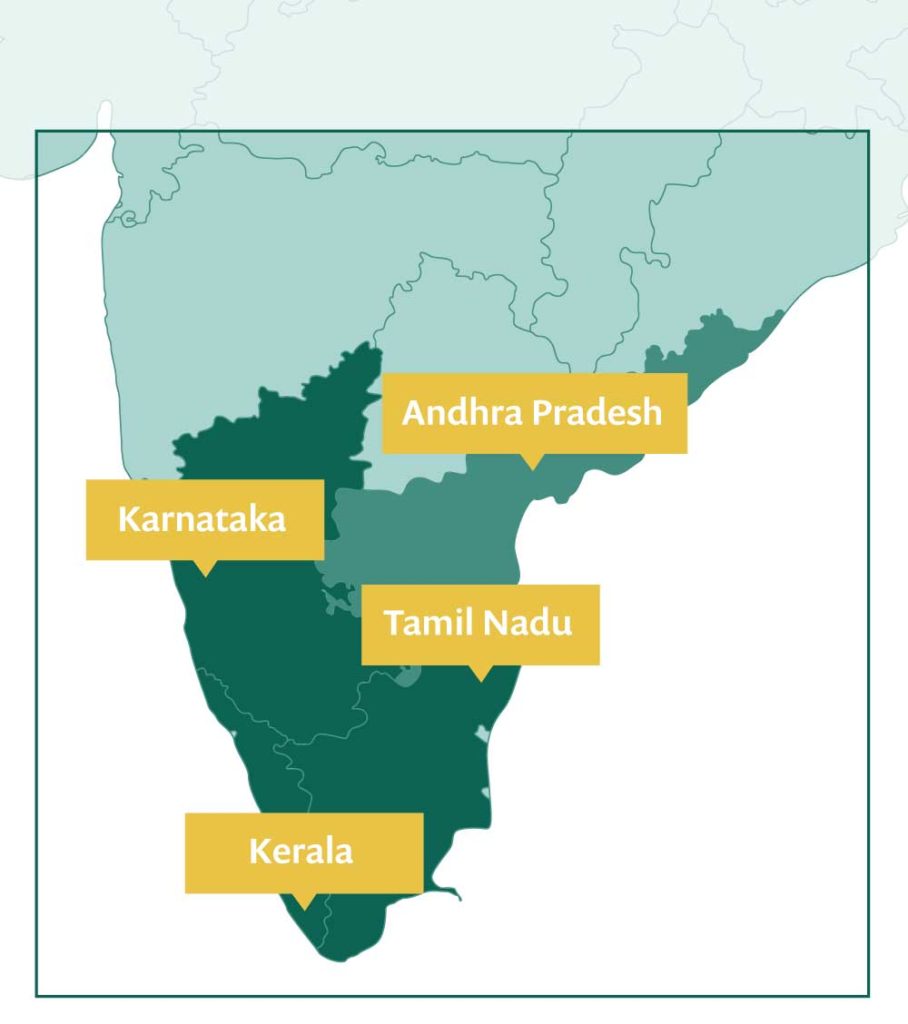
Key findings
Sustainability
Coffee growers in India face multiple risks linked to weather unpredictability, a challenge that has been exacerbated by climate change. Coffee is a sensitive crop, and heat and rainfall are widely considered to be the two most important factors for coffee growth1Haggar, J. and Schepp, K. (2012). Coffee and Climate Change Impacts and options for adaptation in Brazil, Guatemala, Tanzania and Vietnam. National Resources Institute Working Paper Series: Climate Change, Agriculture and Natural Resources, [online] No. 4, pp.1–50. Available at: https://www.nri.org/publications/working-paper-series/4-coffee-and-climate-change/file [Accessed 14 Sep. 2021].. In farmer interviews conducted in September 2021, 92% of farmers (N=83) said they had faced a weather-related challenge in the past year2Haggar, J. and Schepp, K. (2012). Coffee and Climate Change Impacts and options for adaptation in Brazil, Guatemala, Tanzania and Vietnam. National Resources Institute Working Paper Series: Climate Change, Agriculture and Natural Resources, [online] No. 4, pp.1–50. Available at: https://www.nri.org/publications/working-paper-series/4-coffee-and-climate-change/file [Accessed 14 Sep. 2021].. Weather can negatively impact the cultivation of coffee in a variety of ways, including crop damage at sensitive times such as blooming3Pokiya, T. (2021). Interview: Agronomist, PxD. 16 Jun. , increased incidence of pests and disease, increased soil erosion, and more.
What are we doing?
One obvious solution to mitigate the risks of weather variability is weather forecasts, in particular providing customized weather forecasts or real-time weather information, potentially coupled with relevant agronomic recommendations. However, access to high-quality forecasts is limited. In our farmer interviews, only 16% (N=73) said they have access to forecasts4 Krishi Taranga coffee growers (2021). Qualitative farmer surveys: Round 5. 24 Sep.. Our team is currently in the process of putting together a pilot to test the impact of providing customized weather forecasts on key agricultural practices (if you’re interested in learning more about PxD’s weather-related learnings, check out this recent series of blogs).
“The weather imbalance leads to severe black rot and we cannot use spray at the right time.”
Interview with D.S. Sathish, Basrikatte, Chikmagalur
The increase in average temperature and erratic rainfall also exacerbates risks associated with certain pests5 Watts, C. (2016). A Brewing Storm: The climate change risks to coffee. [online] The Climate Institute, pp.1–14. Available at: https://www.juntospelaagua.com.br/wp-content/uploads/2016/09/Pesquisa-sobre-caf—The-Climate-Institute.pdf [Accessed 14 Sep. 2021].. The impact of climate change on pests varies, but overall heavy rain and warmer temperatures are likely to increase the conditions in which several pests thrive. These pests can cause varying levels of damage — some can be devastating, resulting in crop losses of up to 70% if not treated timeously and effectively.6Machenahalli, S., Ranjini, A. P., Madhu S., Giri, Sudha M., Daivasikamani, S. and Surya Prakash Rao N. (2019). Disease of Coffee during monsoon season and their management. [online] Planter’s World, May, pp.4–7. Available at: https://krishi.icar.gov.in/jspui/bitstream/123456789/23682/1/coffee%20disease%20during%20monsoon.pdf [Accessed 14 Sep. 2021].
To explore ways to provide more targeted and actionable recommendations for pest management, we ran an A/B test in November 2021 that looked at the impact of sending multiple reminders on farmers’ knowledge and adoption of high impact practices. We focused on the treatment of white stem borer, an increasingly common pest for coffee growers in India. The results from this test will be shared shortly!
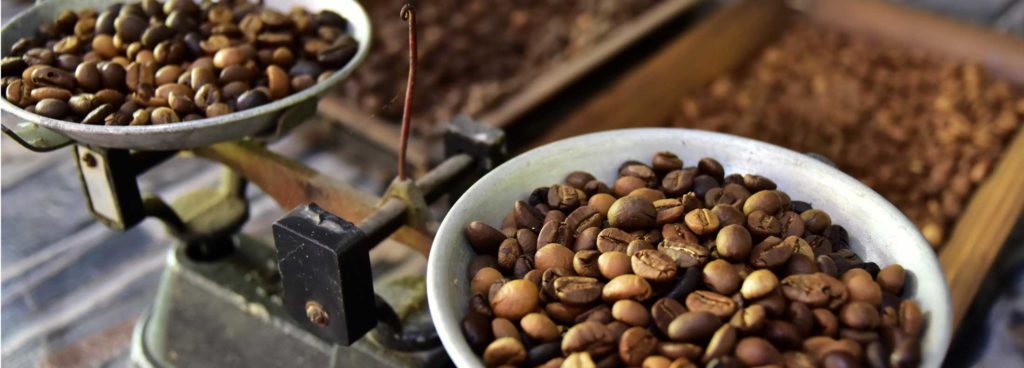
Markets
Smallholder coffee growers sell their produce in fragmented and exploitative local markets. A survey from Chikmagalur and Hassan districts (Karnataka) found that over 90% of growers sold their produce at the farm gate7 Babu, P. (2019). Value Chain Upgrading Strategies for Integration of Indian Small Coffee Growers in Global Coffee Value Chain. Economic Affairs, 64(4).. In our interviews, we found approximately 50% of farmers (N=140) sell their coffee to local traders or markets8Krishi Taranga coffee growers (2021). Qualitative farmer surveys: Round 1. 6 Jul.. There are several reasons why these selling conditions are less than ideal. This includes a lack of infrastructure: smallholders, who deal with relatively small amounts of coffee, usually sell directly to a local trader or agent who pays them on the spot and bears the costs of transporting the coffee to the curing agent. This is where smallholders often lose value on their coffee as local traders set the price for the farmers’ produce.
Another concern is high price variability and lack of transparency. Local traders set coffee prices according to international coffee trends. When buying from farmers on the ground, this price is adjusted based on the quality of the product, which is measured by moisture and out-turn tests. However, the degree to which prices are adjusted based on these metrics is not always clear, leaving farmers feeling frustrated.
“Traders will not buy coffee at existing coffee prices. When traders provide information about prices [they say] it will be more, but [when it comes to] selling the coffee, traders fix a certain [lower] rate and give the unnecessary reason that the moisture content is not good.”
Interview with A.G Nannaiah, Virajpete, near Madikeri
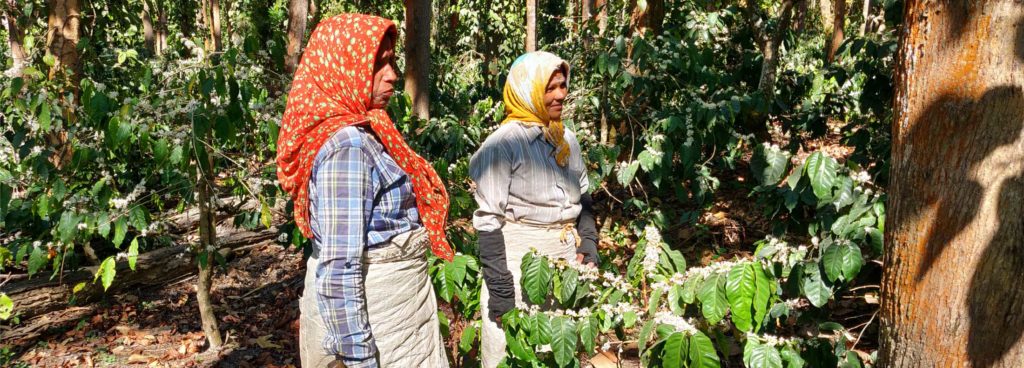
What are we doing?
As part of the CKT hotline, we offer a free price feature which farmers access to listen to daily local and international price information. This is our most used feature, indicating interest in price information. However, overall usage of the hotline is low. We are currently exploring alternative ways of delivering price information to our farmer base, in the hope of reducing frictions and increasing the use of market price tools and information. Lines of relevant inquiry include exploring the use of WhatsApp and SMS to provide price alerts.
To explore ways of reducing price variability, which contributes to income volatility and uncertainty, the PxD team is running a market linkages pilot with the Sustainable Trade Initiative (IDH) in Karnataka. IDH will facilitate contracts between interested buyers and smallholder growers, in which buyers commit to purchasing produce (granted it meets certain quality conditions) at a fixed price. PxD will support growers in meeting these conditions by disseminating relevant agricultural information.
Gender
“My wife visits the estate whenever it is necessary, for example if I am away from the station she looks after things, and after the harvest and the coffee is dried, she weighs it and keeps a record of the quantity of coffee available after it has dried.”
Interview with Virajpete Madhayya, Madikeri
As per India’s Census 2011, coffee plantations were major employers of women workers in Karnataka; out of a total of 480,000 average daily workers employed in coffee plantations, 62% were women. Women appear to be employed for specific activities such as coffee picking, weed management, and applying manure and chemical fertilizers 9Joy, C.V. (2004). Small Coffee Growers of Sulthan Bathery, Wayanad Kerala Research Programme on Local Level Development Centre for Development Studies Thiruvananthapuram. [online] Centre for Development Studies, Kerala, India: Centre for Development Studies, pp.1–43. Available at: http://www.cds.ac.in/krpcds/publication/downloads/83.pdf [Accessed 29 Oct. 2021].. In our interviews with women, we found that women are heavily involved in specific coffee-related activities, including weeding and coffee picking. While women are generally not primary decision-makers for most activities, they appear to be included in the decision-making process. We also learned that women are often part of community groups including self-help groups like “Swasahaya Sangha” (for more information, see our blog post on women’s groups).
What are we doing?
We would like to explore the role of women’s groups and whether these can be leveraged to increase engagement with, and provide relevant support to, female farmers. Evidence from our other programs and the literature suggests that women can increase their collective knowledge and engagement through participating in community groups. The fact that many women in our service are generally involved in day-to-day decision-making suggests that there is room to cater specifically to the areas in which women work. This includes exploring value chains adjacent to coffee cultivation where women may have more involvement, for example, intercrops like spices.
Looking forward
The landscape analysis helped our team gain a broader understanding of the range of challenges and opportunities that exist within the coffee sector in Southern India. In doing so, we have been able to strategize and set evidence-based priorities. This includes focusing on addressing weather-related risks through a pilot to test the impact of providing customized weather forecasts to coffee growers, and a market-focused pilot with IDH.
At the same time, we are also scaling our program with the support of the Walmart Foundation. This includes expanding to another coffee-growing state, Andhra Pradesh. Coffee growers in Andhra Pradesh are different from those in Karnataka, as they are primarily based in tribal regions and practice more traditional farming. We are excited to learn more about coffee growers in this region and adapt our existing service to address their unique information needs.

PxD is building a free weather forecast product for cotton farmers in Pakistan’s Punjab Province to be launched in March, ahead of Kharif – South Asia’s summer planting season. The service will be launched in phases and will ultimately serve 490,000 smallholder cotton farmers across the province.
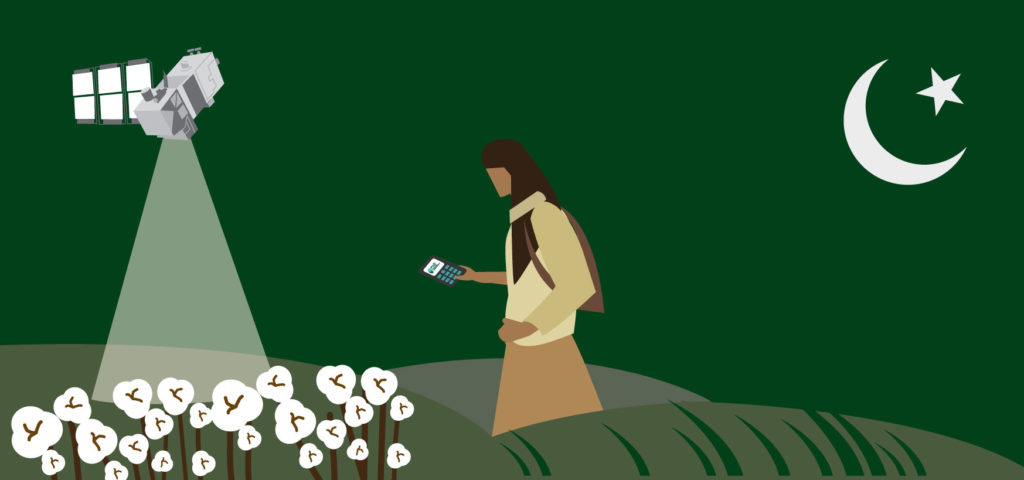
We are excited by the pioneering potential of this product for distributing weather information to inform decision-making on the part of poor, rural farmers in Pakistan’s cotton belt. Moreover, we have been excited to engage in an intentional process of product design from which we have learned a great deal, and which we anticipate will inform the further iteration and development of weather programming and forecast provision across PxD’s geographies, and beyond.
As we have iterated this new product, we have grappled with wide-ranging design possibilities that could increase usefulness and impact. Guiding questions include: Is it more valuable for farmers to receive good weather information – as is typically offered – or is it more valuable to complement forecast information with digital agronomic recommendations (a core PxD competence)? During what stages of the crop cycle, and for which key decision-points, is weather advisory most valued and impactful? At what frequency should advisory be given? How does one communicate probabilities in a way that is accessible and practical for farmers? How does a farmers’ relationship with the weather – and informational needs – differ based on whether their crops are irrigated or rain-fed?
To guide more informed product design decisions, in November the Pakistan team commenced with a set of end-user interviews with 55 cotton and wheat farmers. While 71% of wheat farmers cited access to weather forecasting information, only 45% of cotton farmers surveyed reported access to weather information. When asked if weather information “helped in planning”, 88 and 86% of cotton and wheat respondents respectively responded in the affirmative. This finding buttresses an earlier survey of wheat farmers users in Pakistan where, in response to the question “What agriculture-related information do you need for your wheat crop during the next month?”, 18.5% of respondents cited weather. When canvassing end-users in November, farmer users were asked to “Please list the types of weather challenges you have experienced” in the three years prior to being surveyed. Forty-three percent of respondents who reported experiencing weather-related challenges cited heavy rainfall and 30% reported high winds.
These types of weather incidents can be very costly for smallholder farmers with limited resources. Inundation washes away expensive inputs, creates mud that blocks sprouting crops, and creates conditions conducive to disease, while wind can destroy or severely damage crops throughout the cropping cycle. Further, when prompted to answer “Out of these weather challenges, which three have the largest impact on your crop costs and yields”, pest management was reported as the most common answer. Many pests and diseases thrive in particular weather conditions and can proliferate quickly if conditions are optimal. This suggests that a combination of advisory and weather forecasting information alerting farmers to be on the lookout for pests and to initiate pesticide application decisions sooner could be valuable as a means for reducing pest damage.
To test certain features of our Kharif forecasting products in practice, the PxD Pakistan team took advantage of the ongoing Rabi wheat season (winter planting cycle) to launch two minimum viable products (MVPs) as an AB test. This round of product development was delivered to roughly 2,000 wheat farmers, with each pilot product servicing approximately 1,000 farmers, respectively. The first treatment entailed a simple 48-hour weather-only forecast delivered via SMS and robocall. The second treatment issued an equivalent 48-hour weather forecast to 1,500 wheat farmers, complemented by recommendations on how to adjust one’s irrigation accordingly.
In February, when users have been exposed to the MVP services for two months, they will be surveyed to obtain richer feedback. This survey will aim to answer the fundamental question about whether farmers value weather-linked advisory over weather-only messages. If weather-only is the clear preference, this may suggest that farmers are generally able to connect actions to relevant weather. In the event that farmers do not explicitly need advisory as a complement to forecasting information, this would greatly simplify product development. Secondary questions source farmers’ views on the frequency and relevance of distributed messages. Lastly, under the hypothesis that farmers will prefer advisory linked to weather information, in-field focus groups will be conducted in March to expose farmers to an array of pre-recorded agronomic recommendations and message framings. Feedback from farmers will be used to inform the iteration of advisory scripts and message framing as we work to maximize comprehension, particularly relating to the communication of uncertainties and probabilities, and address potential barriers to adoption.
Another core challenge in developing this product is the quality of the weather forecasts themselves. The existing forecast services in Punjab tend not to be designed with the end user’s needs in mind. Three services in Punjab, Pakistan exemplify usability issues: the first requires user-initiated, user-paid inbound calls; the second requires internet access; and the third is only available to subscribers of a particular telecoms company.
To overcome these types of challenges, PxD is partnering with the private forecast provider CFAN (Climate Forecast Applications Network) to develop calibrated custom forecasts. CFAN is a leading forecast provider, with temperature, cyclone, and severe weather products across North America, Central America, and Asia, and extensive experience in forecasting South Asia weather dynamics. In addition to giving PxD the flexibility to adapt CFAN’s data streams according to our users’ needs, we are using this partnership to transparently assess the magnitude of upfront costs required to build a forecast system.
Learnings from these research activities, coupled with insights generated by our collaboration with CFAN, will inform the final design of our Kharif weather forecasting product for cotton farmers. Once this product is up and running, the focus will shift to impact evaluation, including pick-up rates, behavior changes, and forecast accuracy. Pending a review of such impact outcomes, and funding considerations, the product will be further developed to cover the Rabi season and potentially scaled to additional countries.
This Kharif season, we are thrilled at the prospect of hundreds of thousands of Punjabi smallholder cotton farmers witnessing less fertilizer – and by implication, fewer resources – washed away or harvests inundated by unexpected rains, deploying more effective irrigation tailored to the forecast, and incurring fewer crop losses due to heavy rains and winds. When we asked our PxD Pakistan agronomist about the potential impact of this product, she said: “This product will reduce farming risks and expenses, and increase what is usually a farmer’s sole source of income – allowing for more investment into farming or money for personal expenses”. We are also excited about the potential for this product to serve as a template for iterative product and design process management, and proof of concept, which others may learn from and implement in other settings.
Mark Tamming is an Associate in the London Office of Oliver Wyman, a management consulting firm. Oliver Wyman generously sponsored Mark in joining PxD as an ‘extern’ for three months on PxD’s product team. Shams Sadiq is a Research Associate on the PxD Pakistan team. We thank Khushbakht Jamal, Mahroz Haider, Jagori Chatterjee, Fatima Fida, Adeel Shafqat, Omer Qasim, Hannah Timmis, and the broader PxD Pakistan team who offered valuable contributions to this post and the product development that sits behind it.
Accurate weather forecasts would reduce uncertainty for farmers, yet they are under-supplied and under-studied in developing countries. Government and market failures reduce the quality and reach of weather information in rural regions, reducing its value for households. To address these gaps, Precision Development (PxD) is piloting the provision of improved forecasts to farmers in India and Pakistan. The pilot will investigate how farmers interpret and use weather information, including the cognitive and informational barriers that constrain adoption.
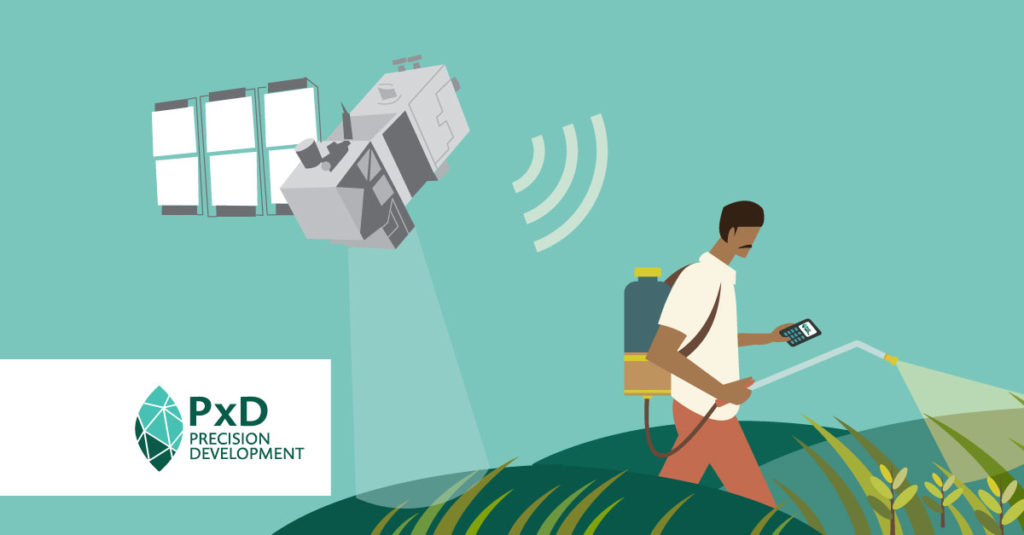
The costs of weather uncertainty
Smallholder farmers live with copious amounts of risk, leaving them vulnerable to income variability and losses. Weather uncertainty is a major source of this risk. A survey of farmers in poor, southern districts of India, for example, found that 73% of respondents had abandoned their crop at least once, in the ten years prior to being surveyed, after misjudging the onset of the monsoon; and one quarter had replanted (Giné et al., 2015). These activities are costly: the authors rank farmers by the accuracy of their monsoon predictions and show that the gross agricultural income of those in the 25th percentile is 8-9% lower than those in the 75th percentile. Other research documents how farmers respond to weather uncertainty by reducing investments in technologies or complementary inputs, which lowers their average profits (Zimmerman and Carter, 2003; Rosenzweig and Binswanger, 1993).
Because weather variability can be disastrous for poor households and is increasing with climate change, economists have dedicated much attention to products that mitigate its consequences, including index insurance and climate-resilient crop varieties. While effective in increasing farmers’ investments and profits, many of these innovations incur high distribution costs that limit their scalability (Cole & Xiong, 2017). PxD is therefore exploring an alternative solution for farmers that face increasing climate risk: accurate, phone-based weather forecasts.
Forecasts have a high potential for cost-effectiveness and scale. By reducing uncertainty over future conditions, they allow farmers to make better production decisions throughout the season. Long-range forecasts of conditions over one to three months can enable farmers to make more informed decisions about how much to invest or which crops to grow, while shorter-range products can be used to determine the best time to conduct activities like fertilizer application. These decisions have the potential to generate meaningful yield impacts; PxD’s agronomy team in India estimates that transplanting rice seedlings from the nursery to the field at the right time can generate yield increases of up to 10%, relative to transplanting too late. Moreover, the marginal cost of delivering phone-based forecasts is low relative to other products that reduce risk, meaning that the returns to their provision would increase with scale.
Currently, however, rigorous evidence on weather forecasts’ effects on farmer outcomes is sparse. Part of the reason may be the limited availability of accurate, useful forecasts in many developing countries. Producing high-quality weather predictions is costly and complex: state-of-the-art observation infrastructure, rapid data transmission systems, high-performance computing, and specialist staff are all required (Rogers et al., 2019). Cash-strapped public providers often lack this capacity, while the private sector has few incentives to serve poor consumers. As a result, the forecasts that smallholders can access are typically well behind the technology frontier.
The limited evidence base suggests that these quality shortfalls reduce forecasts’ value for farmers. For example, an observational study in India found that state-provided seasonal forecasts do increase agricultural profits, but only in the few areas where forecasts happen to be accurate (Rosenzweig and Udry, 2019). Additionally, in Ghana, preliminary results from an experimental evaluation of 48-hour, SMS-based forecasts, found effects on farmer behavior but not on profits (Fosu et al., 2018). Short lead times and a lack of complimentary advice may explain the lack of impact: a review of farmer-focused forecasts in developed countries finds that these factors reduce take-up and usefulness (Mase and Prokopy, 2014).
Unlocking the potential of weather forecasts
PxD’s new pilot aims to build the evidence on the benefits of improved forecasts for smallholders. We have partnered with the Climate Forecast Applications Network (CFAN), a private provider with expertise in developing innovative weather information tools in South Asia, to deliver hyper-local forecasts and related advisory to smallholders in India and Pakistan. CFAN’s products are anticipated to improve on existing forecasts in the region in terms of accuracy, lead times, and precision. Importantly, they can also be calibrated to predict weather phenomena that are particularly relevant for agricultural decision-making, such as prolonged dry spells suitable for fertilizer application or monsoon onset dates.
PxD’s pilot activities will test the efficacy of different intervention designs in both contexts, laying the groundwork for a large-scale randomized evaluation of weather forecasts’ effects on agricultural outcomes that we hope to implement in 2023. Some of the questions we will explore during this preliminary phase include:
- To what extent do farmers update their subjective weather expectations in response to different forecasts? What role do informational, cognitive, trust or other barriers play?
- How do farmers interpret probabilistic weather information? Do forecasts with a numeric probability of a weather event and a qualitative likelihood of the same event affect their beliefs differently?
- For which agricultural decisions could improved forecasts generate the greatest returns?
- Does improved weather information spread among farmers within and across villages?
The findings of the pilot and subsequent evaluation will have policy implications at PxD and beyond. For example, improved understanding of the returns to information products that reduce agricultural risk will inform PxD’s prioritization of new services, such as pest prediction models. The project will also seek to provide policymakers with evidence and incentives to increase funding to improve forecasts in regions that are under-served by governments and markets.
Many thanks to Sam Carter, Jonathan Faull and Yifan Powers for their excellent comments and suggestions on an earlier iteration of this post
Precision Development’s goal is to generate large aggregate impacts for the poor. Research plays a central role in advancing that objective. In a collaborative post, our Research Team surveys their work in 2021 and outlines an exciting portfolio of activities planned for 2022.
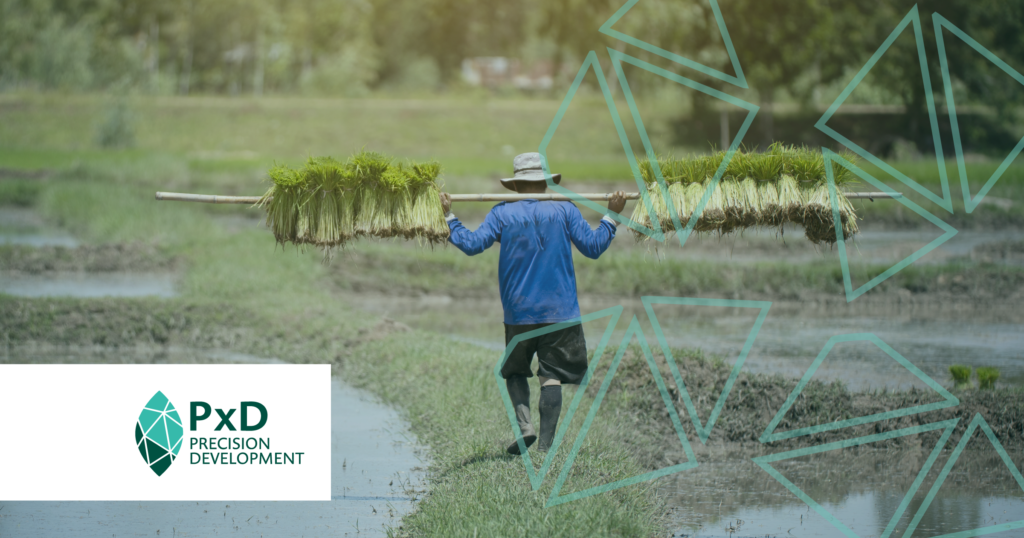
As a recent video produced by our colleagues at J-PAL recounts, Precision Development would not exist were it not for the practical application of research in the world. By intentionally deploying experiments and other methods, we continue to use research to inform the design of our services (innovation research) and to evaluate our impact (evaluation research), and these two types of research often overlap. PxD’s research practice aims to integrate with service design and delivery, and we leverage research to iterate our theory of change, identify learning objectives, and gather insights in every program and initiative.
Needless to say, in 2021 we were busy! Our research and operations teams have collaborated on 26 experiments, of which 14 are completed and 12 are ongoing.
Evaluation Research
At the end of 2021, PxD has three ongoing randomized controlled trials (RCTs) to rigorously evaluate the impact of our services on downstream user outcomes, such as the adoption of improved farming practices, improved agricultural yields, or impacts on learning. In addition to these three evaluations of our own services, we are collaborating with One Acre Fund (OAF) to evaluate aspects of their work with Farmer Promoters.
Excitingly, PxD is running a large-scale RCT with nearly 15,000 rice farmers in India to estimate the impact of the Ama Krushi service on farmers’ practices and yields, and how the magnitude of these impacts vary by farmer characteristics. Data on production costs and revenues will be collected from a subset of farmers for a back-of-the-envelope calculation on the service’s benefit-cost ratio. This RCT also aims to test the effectiveness of using satellite-based imagery to detect yield changes in GPS-measured smallholder rice plots and to compare these to self-reported farmer yields. Early in 2022, we will conduct the midline survey and process satellite images to assess the impact in the first season. We are eager to share our initial findings!
In western Uganda, PxD is collaborating with the International Food Policy Research Institute (IFPRI), the Hanns R, Neumann Stiftung (HRNS), and Technoserve to measure the stand-alone impact of PxD’s two-way voice-based advisory service and the complementary impact of digital reminders implemented by PxD as part of the Uganda Coffee Agronomy Training (UCAT) program. This RCT plans to integrate the use of machine learning to identify agricultural practices that have the highest impact on improving coffee yields and to identify farmer characteristics that are most closely associated with the increased adoption of such practices. The COVID-19 pandemic pushed back the initial implementation schedule for UCAT and we now plan to collect endline data for approximately 4,000 farmers in 2022.
In the education sector, Innovations for Poverty Action (IPA) and PxD have concluded data collection for a randomized evaluation to assess the impact of our two-way SMS math education service, ElimuLeo, on learning and knowledge. Implementation of the RCT has now concluded and we have extended access to the platform to children in the control group. We have recently surpassed the milestone of over 500,000 problems solved on the platform!
Since 2018, PxD has partnered with One Acre Fund (OAF) to test low-cost incentives to enhance the performance of approximately 11,000 Rwandan volunteer extension agents, commonly known as Farmer Promoters (FPs). With one FP in each of Rwanda’s 14,500 villages, PxD’s collaborative intervention targets a majority of FPs in the country. Importantly, FPs do not receive monetary compensation for their service, but rather receive in-kind benefits such as free inputs. Throughout 2021, PxD and OAF have been conducting an RCT to examine whether motivational SMS messages improve FPs’ performance, and to test whether motivational messages designed to appeal to the FP’s specific personality traits lead to improved FP performance and farmer outcomes. This evaluation includes three main interventions: a subsidized input promotion campaign, a demonstration plot and farmer training campaign, and an agroforestry tree planting campaign. We aim to launch endline surveys in early 2022.
Service Design and Innovation Research
As part of our efforts to leverage research to improve service design and delivery, we often conduct rapid hypothesis testing. We are also exploring ways of increasing engagement with our Ama Krushi push call service. In 2021 we deployed an A/B test that experimented with sending “heads up” SMS messages at different times to alert farmer users of an impending IVR call from the Ama Krushi service. Results are very promising: sending an SMS reminder 10 minutes before a service call increases pick-up rates by 5.9 pp (a 17% increase from the control mean pick-up rate of 34%). Conditional on picking up, the 10-minute SMS reminder also increases average listening rates by 4 pp (a 25% increase over a control mean of 15.4%). Considering both the success of the 10-minute reminders and the relatively high costs of sending SMS messages via the Ama Krushi service, one implication of this experiment would be to send short SMS reminders to farmers who are at risk of becoming inactive on the service to nudge engagement for a limited period and to promote recommendations that have particularly high-impact or are time-sensitive.
Reminders also play an important role in nudging farmers to take action on optimal planting dates. Planting at the optimal time is positively correlated with yields, yet misconceptions, lack of knowledge, or limited resources often result in farmers planting at a later date. In the 2021 Long Rains season in Kenya, we tested whether sending SMS messages recommending optimal planting times would nudge adoption. This experiment targeted a sample of approximately 15,000 OAF farmers and included additional treatments such as messages addressing misconceptions on planting times and direct endorsements from Field Officers. We found that SMS recommendations for optimal planting times are effective in nudging average self-reported planting dates closer to the optimal date. This effect is larger for late planters. Late planters in treatment groups reported planting, on average, four days closer to the optimal date relative to the late planters in the control groups. These results are valuable for improving service delivery in Kenya and for nudging farmers toward more timely planting. We are keen to conduct further research on the mechanisms underlying planting time decisions.
A/B tests deployed by PxD have shown that a narrator’s voice can impact user engagement in various contexts. In 2021 we completed a first A/B test on our nascent program in Nigeria to measure the effect of the narrator’s gender on pick-up and listening rates for PxD’s push call platform. Over the course of a seven-week period in the Wet Season, a sample of over 45,000 farmers was randomly allocated into two groups, receiving weekly audio content narrated either by a female or male voice, respectively. We found that female farmers have systematically lower pick-up rates than male farmers, yet this gap is slightly mitigated when the narrator is female. In addition, we found that all farmers (both male and female) when listening to content voiced by a female narrator were 1.4 pp more likely to listen to the full push call, given a mean completion rate of 51.8% of the audio content. Going forward, our service in Nigeria will primarily use female narrators when recording audio content for push calls. Nevertheless, we will benefit from further research to generate evidence on the long-term effect of this action on user engagement.
Our nascent research agenda in our newest program in Colombia is leveraging past experimentation on human contact and direct endorsements, particularly when it comes to increasing user engagement in the early stages of service delivery when name recognition and trust levels are limited. We have recently concluded profiling surveys and are analyzing how user engagement with PxD’s Un Mensaje por El Campo platform varies before and after farmers receive the profiling survey. SMS messages are not broadly used by smallholders in the Meta region of Colombia and many farmers need to be guided on how to access and navigate their SMS inbox to realize that they have been receiving messages from our service. Surveys and direct contact with surveyors from our team provide an opportunity to mitigate low digital literacy and improve trust in our service.
Moreover, we continue to explore ways to support farmer access to recommended agricultural inputs. In Kenya, we are building a proof-of-concept digital tool to improve linkages between farmers and agro-dealers by providing local agro-dealer contact information on our MoA-INFO platform. This digital Agro-dealer Contact Directory (ACD tool) will help us gather insights on the perceived value of reducing search costs among farmers and agro-dealers, as well as potential effects on farmers’ input search behavior and input access. Using these insights, we can then determine if there are other low-touch, scalable engagements with agro-dealers that will help us to improve farmers’ welfare. Drawing on the evidence from the literature on digital phone books, we have launched a two-way agro-dealer pilot with over 33,000 MoA-INFO farmers and 142 agro-dealers. This pilot aims to elicit feedback from farmers and convey information about their input demand to agro-dealers, mitigating informational barriers that prevent agro-dealers from consistently stocking inventory. Farmers are often uncertain about which inputs are in stock and agro-dealers are uncertain about quantities of inputs demanded by farmers, with many reporting being out-of-stock during peak times of the year. Stock-outs raise uncertainty and search costs for farmers and can lower adoption rates for improved inputs, especially if farmers have to travel far to other markets. Experimentation with the ACD tool aims to reduce search costs and improve access to recommended inputs.
Crowdsourcing local information from farmers and other actors along the agricultural value chain holds many potential advantages for our services. The key is to identify scalable ways to crowdsource sufficiently granular information to improve the quality of our advisory content. In Gujarat, we are generating insights on the operational feasibility and scalability of collecting accurate and timely information on crop health issues from locally recruited gig workers and tracking the volume and quality of data submitted by these workers via a tailored WhatsApp chatbot.
Finally, sourcing and providing information on pest prevention and management continues to be one of our research priorities. We are particularly excited about an ongoing pilot in Karnataka, India, which is reinforcing good management practices for white stem borer, a major coffee pest. In a recent round of qualitative surveys, we found that a majority of respondents had experienced white stem borer infestation in the previous coffee season, and many farmers reported using antiquated corrective measures that are no longer recommended by the Indian Coffee Board, or even practices that have been banned. Research undertaken in 2021 on Fall Armyworm infestation in Kenya and Zambia, provides some indicative evidence that our advisory increases knowledge and adoption of recommended pest prevention and management practices, and that sending reminders for priority practices may result in higher knowledge and adoption. Building on this evidence, we are partnering with J-PAL to test whether repeating key advisory messages on white stem borer and using different types of reminders and nudges, lead to higher rates of adoption for recommended practices among a sample of 2,400 coffee farmers. This experiment is ongoing and we aim to share results by mid-2022.
Looking forward to exciting research opportunities in 2022
Throughout 2021, PxD expanded dairy and livestock advisory services in Kenya, Ethiopia, Pakistan, and India. In Kenya, we are partnering with three dairy cooperatives to iterate and build a two-way SMS advisory service for dairy farmers. Building on the results of a gender survey to assess the gendered division of labor within dairy-producing smallholder households, we are excited to commence an RCT of the service in early 2022, ahead of the Long Rains seasons. We aim to rigorously evaluate the impact of the service on milk production (both in terms of quality and quantity) and sales for a random sample of 5,000 dairy farmers using administrative data made available from our dairy cooperative partners.
Finally, we are excited about our nascent climate research agenda, which includes both adaptation and mitigation efforts, and aim to continue scoping opportunities within our services and geographies to strengthen smallholders’ climate resilience, generate scalable low-cost climate mitigation innovations, and, above all, to improve smallholders’ agricultural productivity and income. We are excited to launch new products integrating granular weather forecasting with actionable advisory in Punjab, Pakistan, and Karnataka, India. Our weather pilots aim to incorporate innovation research to understand how to communicate uncertainty and probabilistic events in low-literacy settings, as well as the value of forecasting versus tracking advisory. Moreover, after recently securing new climate mitigation funding, we are eager to conceptualize research pilots to measure low-cost scalable innovations and rigorously measure changes in both farmer and climate outcomes. We intend to establish a proof of concept for our environmental theory of change and seek further validation of the applicability of PxD’s communication for behavior change model on new research areas, such as the potential for cash payments to farmers for activities that sequester soil carbon and contribute to climate change mitigation efforts.
At PxD our decision-making draws on existing evidence and scientific knowledge; understanding about how humans, institutions, firms, and markets behave and function; contextual information and knowledge about targeted users and local conditions; and our prior experience (as well as resource envelopes and other pesky exogenous factors). Research and inquiry are critical to generating insights and uncovering new information across all of these categories of knowledge. We are privileged to work with colleagues who rigorously generate and leverage evidence to guide our work and decision-making as we develop, iterate, and scale innovations that impact poverty at scale.
We look forward to sharing new insights with you throughout 2022!
The Abdul Latif Jameel Poverty Action Lab’s (J-PAL) has showcased PxD as an organization that leveraged the value of randomized evaluations to launch more effective approaches to reducing poverty on a global scale.
The video was produced as part of J-PAL’s “Evidence to Policy” series which was envisaged as a vehicle to highlight the use of rigorous testing to inform policy and scale effective change.
The producers interviewed Shawn Cole, PxD co-founder, Chair of our Board and a J-PAL affiliated professor, Tomoko Harigaya, Chief Economist, and Niriksha Shetty, India Country Director, discuss how evidence from rigorous evaluations catalyzed the scale-up of a low-cost, mobile phone-based agricultural information delivery system to support smallholder farmers.
We thank J-PAL for this rather excellent production!
Last week delegates convened in Glasgow at the 26th Conference of the Parties (COP26) to the United Nations Framework Convention on Climate Change to engage in the difficult task of negotiating an offramp to climate catastrophe. The vast majority of PxD’s 5.2 million users are poor farmers who confront myriad – and reinforcing – challenges linked to climate change, food security, and poverty. We are excited to have secured new funding to pursue research opportunities for climate mitigation innovations to benefit smallholder farmers.
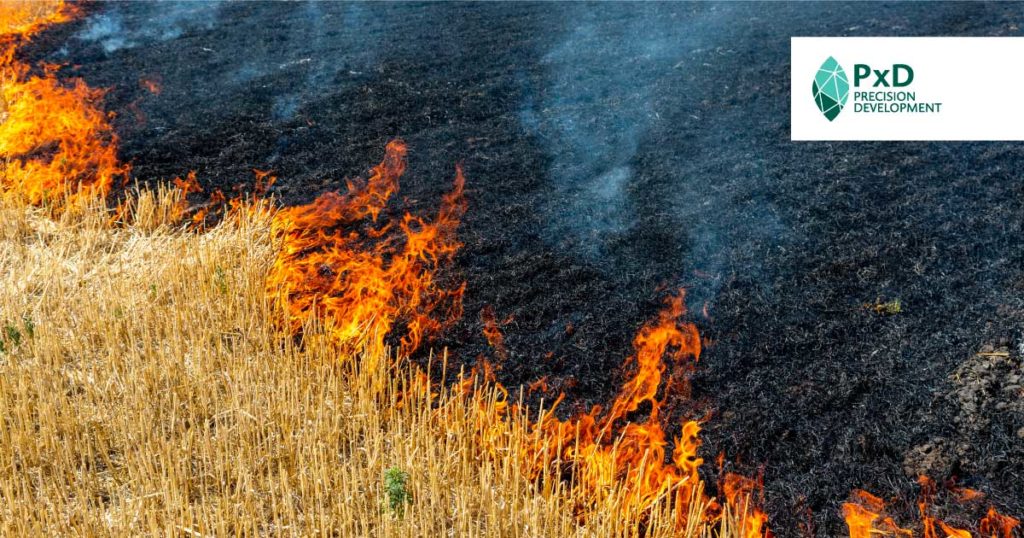
In this post Dina Rodrigues, Global Research Support Associate, Caitlin McKee, Assistant Director of Research, and Tomoko Harigaya, Chief Economist and Director of Research, present how PxD thinks about the complementarity of research, service design, service delivery, the evaluation of impact, and development practice. We assess how our programming can promote behavior change to advance climate-related goals, and we lay out opportunities for new research.
As we work to enhance our service offerings and research activities, to identify new opportunities for climate innovation, and to assist our users to lead more productive and resilient lives, we are guided by the following principles:
- User benefit first – Smallholder farmers cannot be expected to pay the price for climate mitigation. All climate-friendly advice to smallholder farmers from PxD should support livelihoods and not compromise agricultural yields or smallholders’ income. If there are evidence gaps on farmer benefit, we will explore ways for farmers to be favorably compensated for adopting those practices as an additional source of income.
- Adapt and mitigate – Our ambition is to promote both climate change adaptation (reducing potential damage) and mitigation (tackling the causes) activities.
- Replicate and scale – To fully leverage the advantages of scale, we work to ensure that our advisory services can be replicated across multiple contexts and with a diversity of partners.
The role of research at PxD
PxD’s systems are designed to scale the delivery of customized digital information to individuals and households so that they can act on it to improve their well-being and reduce exposure to risks and disasters such as floods and droughts. Our systems are designed to be scaled; as they scale, average costs fall and we improve the cost-effectiveness of our delivery.
Research is integral to this work. We deploy experiments and other research methods to inform the design of our services (innovation research) and to evaluate our impact (evaluation research). We generate evidence and insights based on a range of activities, from large randomized controlled trials to small-scale pilots. We learn from experiments that show statistically significant results and null experimental results, as well as through the analysis of descriptive and qualitative data.
PxD’s goal is to generate large aggregate impacts for the poor, and the role of research at PxD is to draw insights from empirical data, existing evidence, scientific knowledge, and theories to:
- Contribute to the development of PxD by identifying impact opportunities through the generation of insights into technological change, partnerships, scenario planning, and strategic choice, etc.
- Inform the design of programs and PxD’s investment decisions.
- Rigorously test and iterate ideas and assumptions.
- Evaluate and quantify the impact of our programs.
- Increase our understanding of the link between what we can observe and the ultimate outcomes we care about.
- Contribute to a broader knowledge base for practitioners, policymakers, and researchers.
In this way, our researchers support and collaborate with teams across the organization to enable efficient and effective learning through rigorous research to advance PxD’s goals.
Meeting the challenge of the age
We are intensifying our efforts to provide information to smallholder farmers that will allow them to make informed decisions to reduce the risks that climate change presents to their livelihoods and to enjoin their farming and land management activities in the fight against climate change. PxD is focusing on identifying interventions that can improve smallholder livelihoods whilst incorporating climate adaptation and mitigation efforts into our existing services. A key component of this is identifying feasible methods for measuring outcomes and program impacts on farmer welfare and the climate. A further component of our research agenda is to iteratively develop, refine, and test these innovations at scale.
Climate-smart advisory, adaptation, and mitigation efforts are already embedded into our programs across all the geographies we work in, as well as into the day-to-day agricultural activities that PxD farmers carry out. We focus both on climate change adaptation (reducing potential damage) and climate change mitigation (tackling the causes), as the activities and approaches are distinct.
1. Climate Change Adaptation
Adaptation efforts focus on anticipating the adverse effects of climate change and taking appropriate action to minimize potential damage for those most likely to be adversely affected, whilst managing and, hopefully, reducing climate-related risks. Ultimately, the aim of climate adaptation is to enhance the resilience of the individuals, households, and communities most vulnerable to negative climate shocks. These efforts generally involve the use of dynamic, local information to adapt their practices to climate shocks and behavior change and the adoption of new technology to increase resilience. At PxD we are increasingly asking questions such as: How climate-vulnerable are the farmers that use our services; What are the consequences of climate change that are affecting smallholder farmers’ lives; And how can we reduce the welfare loss that individual farmers and communities experience, or are likely to experience, because of climate change?
Weather uncertainty is one of the biggest agricultural risks faced by smallholder farmers. Climate change has increased weather variability and unpredictability in many parts of the world, imposing greater risks on agricultural production. These challenges are exacerbated by a lack of appropriate infrastructure and insufficient ground validation to provide accurate weather forecasts in many parts of the Global South.
PxD programs include adaptation efforts to reduce weather-related risk and uncertainty caused by climate change. One such example is the promotion of flood-tolerant seeds in the state of Odisha, India, on PxD’s largest Indian service, Ama Krushi, which currently has over one million users. Two-thirds of Ama Krushi farmers have experienced significant crop damage due to weather shocks and, of these, 57% experienced flooding. PxD’s climate adaptation efforts included experimentation with simplified, targeted Interactive Voice Response (IVR) messages to nudge the adoption of flood-tolerant rice varieties. We found that our simplified low-cost messaging significantly increased low and medium land types farmers’ adoption of flood-tolerant seeds. On average, these farmers were 2.6 percentage points more likely to plant flood-resilient seeds after receiving a message, a 25% increase over the control group mean adoption rate of 10.4%.
In another geographic context, in Punjab, Pakistan, PxD is working on new product design to further customize our advisory by integrating granular weather data into existing services. PxD will use enhanced weather models to inform farmers of local conditions, linking weather conditions to relevant agricultural advisory. Existing forecasts in Pakistan mainly lack both the granularity and the accessibility to meet the needs of smallholder farmers and support day-to-day farming decisions. Via partnership with experts in satellite-based weather prediction models, PxD will develop a granular forecast at the local tehsil level, and PxD will leverage its communication for behavior change expertise, disseminating this information via SMS and voice. In addition, we are conducting user research and consulting agronomists to design and test agricultural advisory that is linked to weather forecasts.
Finally, when weather calamities are anticipated, many PxD services advise farmers on what they can do to minimize crop damage. In Odisha and West Bengal, for example, our services inform farmers of impending cyclones, advise them about actions they can take to protect their crops in the field, or encourage them to bring in their produce from the field early, if appropriate. Our advisory can also promote appropriate post-harvest and storage practices in contexts where a farmer may otherwise not have expected to take action.
Example of paddy/rice crop advisory for deficit rainfall
English Translation:
Namaskar. Welcome to the ‘Ama Krushi’ free Agriculture Information service of Department of Agriculture, Government of Odisha. Paddy crop is affected by current scanty rainfall situation in many districts of Odisha. Today we will give some advisory to manage paddy crop due to scanty rainfall situation. Do not practice Beushaning in rice, if the crop is more than 45 days old. Don’t wait for rainfall and carry out hand weeding. In line direct sown paddy, use manual weeder if optimum soil moisture is present. Don’t go for Beushaning in areas where large deficit of rainfall has been seen. Go for hand weeding and gap filling using seedling of same age or clonal tillers to have a uniform distribution of plant after optimum rainfall is received. If basal fertilizer is not applied in direct sown paddy than apply 38-kg of DAP/acre, 20-kg of Urea/acre, 14-kg of MOP/acre., 4-kg of Borax/acre and 10-kg of Zinc Sulphate/acre. Strengthen the field bunds and close the holes to check seepage loss. For delayed transplanting seedlings up to 45 and 60-70 days old can be transplanted in case of medium and late duration rice varieties, respectively without much reduction in yield. Transplant the old seedling in puddled soil at shallow depth with closer spacing of 15 x15 cm and 4-5 seedlings per hill. Apply 50 % Nitrogen fertilizer along with other recommended fertilizer during transplanting. Thank You.
Example of paddy/rice crop advisory for excess rainfall
English Translation:
Namaskar. Welcome to the ‘Ama Krushi’ free Agriculture Information service of Department of Agriculture, Government of Odisha. Today we will discuss about some crop management strategies after excess rainfall due to low pressure and depression in Bay of Bengal. Drain out excess water from paddy field if possible. If the paddy crop is under submergence temporarily, apply 10-12 kg of MOP after rainwater recedes. Don’t apply fertilizer and wait for new tillers to come if paddy crop is affected largely due to complete submergence. If crop is lodged due to excess rain and wind, then try to keep it upright by binding few hills. There are chances of increase in chaffy grains if the crop is in panicle emergence stage. To minimize chaffy grains in the panicle spray Boron 20 % (Folibor/Solubor) @ 1-1.5 gram/litre or Borax @ 2-2.5 gram/litre of water. Spray fertilizers or pesticides during afternoon hours instead of morning hours if the crop is in flowering stage. Thank You.
2. Climate Change Mitigation
Mitigation efforts focus on tackling the causes of climate change to reduce the flow of heat-trapping greenhouse gases (GHG) and other climate and air pollutants, like black carbon soot, into the atmosphere. This can be achieved either by reducing emissions of climate pollutants or by increasing carbon sequestration in the soil, forests, and oceans. When it comes to smallholder farmers, climate mitigation focuses on changes in agricultural and land management practices and the adoption of new technologies or farming behaviors that can contribute to reducing emissions or increasing sequestration at scale. At PxD, we are increasingly preoccupied with ensuring that such behavior changes are also beneficial for the individual farmers and communities we serve.
Some agricultural practices are likely to contribute both to poverty alleviation and climate mitigation if they result in increases in agricultural outputs or income. One such example is promoting the optimal and timely application of nitrogen-based fertilizers. Most PxD advisory services, across our various geographies, include recommendations on the optimal application of planting and/or top-down fertilizer. Our agronomy teams have identified overuse of nitrogen fertilization and underuse of other required fertilizers with smallholders who tend to rice paddies and cotton fields in the Indian states of Odisha and Gujarat, respectively. Whilst nitrogen fertilization is an important component of crop production, crops can only efficiently absorb a finite amount of nitrogen. Nitrogen applied in excess contributes to water and atmospheric pollution in the form of nitrates or nitrous oxide. Emissions tend to be proportional to the amount of fertilizer used and the concentration of nitrogen in the product. Precise application of nitrogen fertilizers has the potential to cut down farming costs if farmers need to purchase less fertilizer, hence improving smallholders’ agricultural income whilst curbing nitrous oxide emissions. We are exploring user-friendly tools, such as leaf color charts, to support farmers to optimize their fertilizer application.
In addition, several of our services in Africa, including MoA-Info in Kenya, push-calls in Nigeria, and UCAT-Uganda, advise farmers to cover crops to slow erosion, improve soil moisture, and prevent pests and disease outbreaks. PxD farmers across most of our geographies also control soil erosion via techniques such as terracing or contour plowing. These methods are likely to improve yields via a general enhancement of soil conditions whilst increasing soil propensity for carbon sequestration by slowing erosion.
However, some agricultural practices have unclear effects on yields, agricultural income, or climate outcomes. Most worryingly, many behavior changes that present opportunities for climate mitigation put a burden on smallholder farmers. In these cases, decision-makers, researchers, and practitioners must identify ways to compensate farmers for the social benefits they generate by adopting those behavior changes, whilst guaranteeing an immediate private return for early adopters. This may include payment schemes, such as conditional cash transfers, or subsidies for improved technologies, but further research is needed to understand what kind of incentives and measurement techniques are likely to work in various settings.
Opportunities for new research
In partnership with the Institute for Governance & Sustainable Development (IGSD), PxD will undertake exploratory activities with a specific focus on climate change mitigation in addition to poverty alleviation. We are excited to scope our existing programs and partnerships to identify:
- Opportunities for scalable climate mitigation innovations.
- Evidence and measurement gaps.
- How we can leverage soil science, remote sensing, and soil sensor technology to improve agricultural productivity and generate climate mitigation innovations.
- Barriers and opportunities in terms of measurement, adoption, and smallholder behavior change.
The aim of this work is to lay a foundation to ultimately develop, test, and scale innovations such as payment schemes or cash-transfer approaches that can simultaneously address climate change and reduce poverty.
On a preliminary basis, we have identified the following potential climate mitigation areas:
- Reducing black carbon emissions from crop or biomass burning
- Reducing nitrous oxide emissions from fertilizer overuse
- Enhancing soil carbon sequestration
- Protecting and enhancing carbon sinks through forestry
- Reducing methane emissions from livestock, dairy, and rice.
Within each of these areas, PxD plans to scope relevant agricultural activities practiced by farmers engaged with our advisory services across all our geographies, relevant partner capabilities, and potential external consultants. Based on this mapping exercise, we aim to identify specific technologies and farming practices that can improve climate mitigation outcomes at scale in conjunction with relevant measurement outcomes (e.g., soil carbon, soil characteristics, and GHG and climate pollutant emissions reductions).
PxD is committed to always putting the welfare of smallholders and our contribution to poverty alleviation first. As an organization that works with over five million users across a variety of settings, PxD is well-placed to advance the knowledge frontier through rigorous experimental applied research. Our aim is to enhance the resiliency of smallholder farming households through the diffusion of information to promote the adoption of new technologies and climate-smart agricultural practices. We are excited to implement this nascent research agenda and enjoin the activities of millions of smallholders as agents of change in plotting a more resilient future.
We will share our learnings in future posts!

Women play important roles in smallholder dairy production. As PxD prepares to roll out a dairy advisory initiative in Kenya, we conducted a gender survey to better understand the division of labor within households. In this post, the second of a two-part series, Sam Strimling, Research Associate, presents an analysis of the results. The first post laid out the importance of understanding the specific needs of women in designing effective service delivery for women.
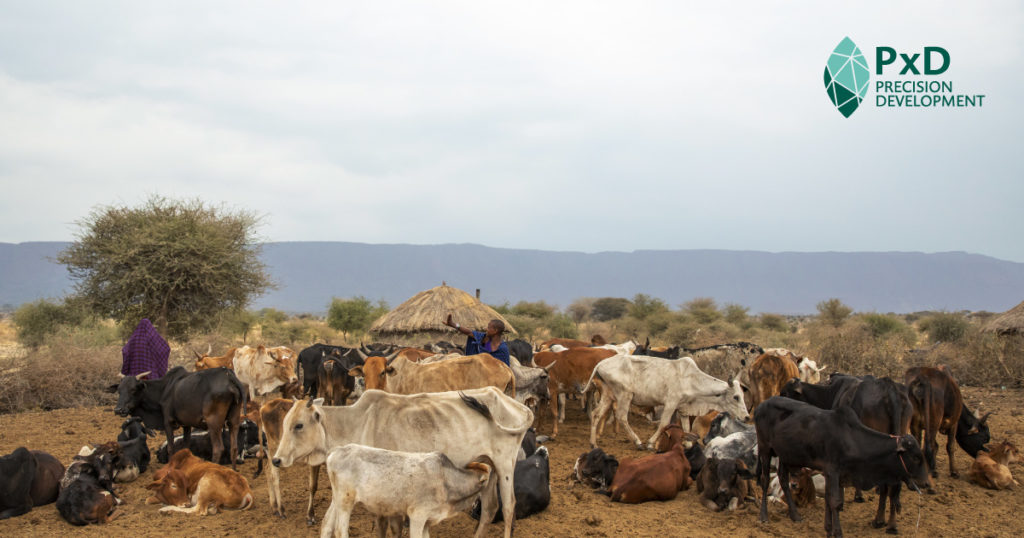
In many smallholder households, labor relating to the tending of livestock – particularly dairy animal husbandry and dairy production – is derived disproportionately from women. This culturally entrenched division of labor has direct implications for PxD as we expand into supporting dairy farming activities and seek to target our digital advisory services appropriately.
There is a plethora of evidence – much of it detailed in the excellent book, Invisible Women, by Caroline Criado Pérez – of service providers who failed to understand women’s specific needs and preferences and thus designed inferior products. Providers of digital advisory services are no exception to this disappointing phenomenon.
As PxD prepares to roll out a dairy advisory initiative in Kenya, we considered it a top priority to conduct a gender survey to better understand the roles played by each household member with a focus on tasks performed, decision-making, and financial agency. The results of this survey will be used to inform the dairy content we are developing as part of an upcoming randomized controlled trial (RCT) we are implementing in partnership with several dairy cooperatives across different regions in Kenya. We will use the results of the survey to inform the type of content we write, as well as how and to whom we deliver it.
As detailed in a previous blog post about the survey, the PxD Kenya team used a novel and rich dataset to inform survey design. In addition to gaining insights into the roles played by different members of the household, we also sought to better understand the technical and analytical abilities of each respondent, as well as perceived technical knowledge for each household member. Finally, we used methods from behavioral economics to empirically evaluate trust within the household.
Survey Structure
We started with a total sample of 600 households randomly selected from two dairy cooperatives, in the Rift Valley and Eastern regions. The sample was stratified by geography, milk sales to the dairy, and deductions for purchases from the dairy-affiliated agrovet (in which farmers are able to purchase animal medicines and farming inputs using income from milk).
We called 464 unique respondents, of whom 357 answered at least one call. Respondents who lived with or made decisions with their spouses were asked to provide contact information. Single respondents – many of whom were widows or widowers – were encouraged to complete the survey, but were not asked a series of subjective questions about the degree to which they made decisions or discussed activities with their spouses. Single respondents were also not asked to participate in the public goods game. In total, 114 spousal pairs completed the full survey. These spouses, and their respective households, will be the focus of this post. The demographics of the survey respondents and their households are shown in the table below.
Intra-household dairy roles. At the start of the survey, each respondent was asked to list the members of the household above the age of five, and state their age, gender, and education. The survey enumerators used tablets to record responses that allowed them to capture this information to be used later in the survey. Respondents were then asked to select from this list to indicate which member(s) of the household:
- Practiced crop farming, grazing, fetching water, wage employment [Respondents were specifically asked if they held “a job outside the home.”], schoolwork, childcare, and/or leisure in any given week. Respondents were also asked to indicate the number of hours each selected household member spent on each task in a typical day.
- Practiced various dairy tasks, selected from a list of tasks generated by our Staff Dairy Livestock Expert. For each task selected, respondents were asked to indicate which household member took primary responsibility, and how many minutes this individual typically spent on that task per day. This is the only household roster question for which the respondent was asked to select a single respondent rather than having the option to select multiple members.
- Were knowledgeable about nutrition, artificial insemination, hygiene, disease, and feed and fodder. The respondent was also asked to rank the selected household members in terms of their knowledge on that particular topic.
- Had taken various financial actions, including purchased a personal asset, purchased a productive asset, sold crops on behalf of the household, received payment for crops on behalf of the household, received payment for milk production, and made decisions about spending dairy income.
Analytical ability and dairy knowledge. Respondents were asked to answer a series of scenario-based analytical questions as well as questions to assess technical dairy knowledge on a broad range of topics. We then calculated the percentage of analytical and technical questions the respondent answered correctly.
Subjective assessment of financial agency and cooperation. Respondents were also asked to provide information on their personal knowledge and feelings of financial agency. To assess financial agency, respondents were asked to indicate using a Likert scale the degree to which they discussed finances with their spouse, trusted their spouse’s financial decisions, talked with their spouses about agricultural work, and talked with their spouse about their day generally.
Intra-household cooperation – the public goods game. Finally, all respondents who completed the survey were awarded 100 Ksh (approximately $1) in airtime, and – if their corresponding spouse had also completed the survey – they were invited to increase their earnings by contributing some portion of their earnings into a common account with their spouse. Since the amount contributed to this common account was doubled and then split evenly, the respondent’s contribution could be interpreted as an empirical measurement of cooperation with their spouse.
Information asymmetry. For the 115 households in which we collected information from both spouses, we were able to calculate the degree of coherence in their responses in terms of the intra-household (inter-spousal) correlation coefficient.
General Time Use & Dairy Tasks
Male and female respondents broadly agreed on the division of labor within the household by gender of household members. We focus our description of intra-household gender-specific roles on the share of time spent by males and females within the household and checked whether men and women respondents generally agree on this proportion. This is presented in Figure 1 below, which organizes respondents’ perceptions by the proportion of hours household members of different genders spend on pre-specified activities within the household (p-values reflect tests of the null that there is no difference in responses across spouses). While male and female respondents differed in their reports of the time spent by gender of the household member, these differences were not significant for any time-use category other than crop farming. In this instance, the difference in perceived hours on task from the perspective of male and female respondents was statistically significant at the 5% level (as demarcated by the p-values next to each bar). In general, respondents of both genders reported that crop farming, grazing, school, and leisure were split nearly evenly by gender. Female household members, however, were reported to spend more time fetching water and engaging in childcare relative to male household members, and male household members were more likely to have a job outside the home.
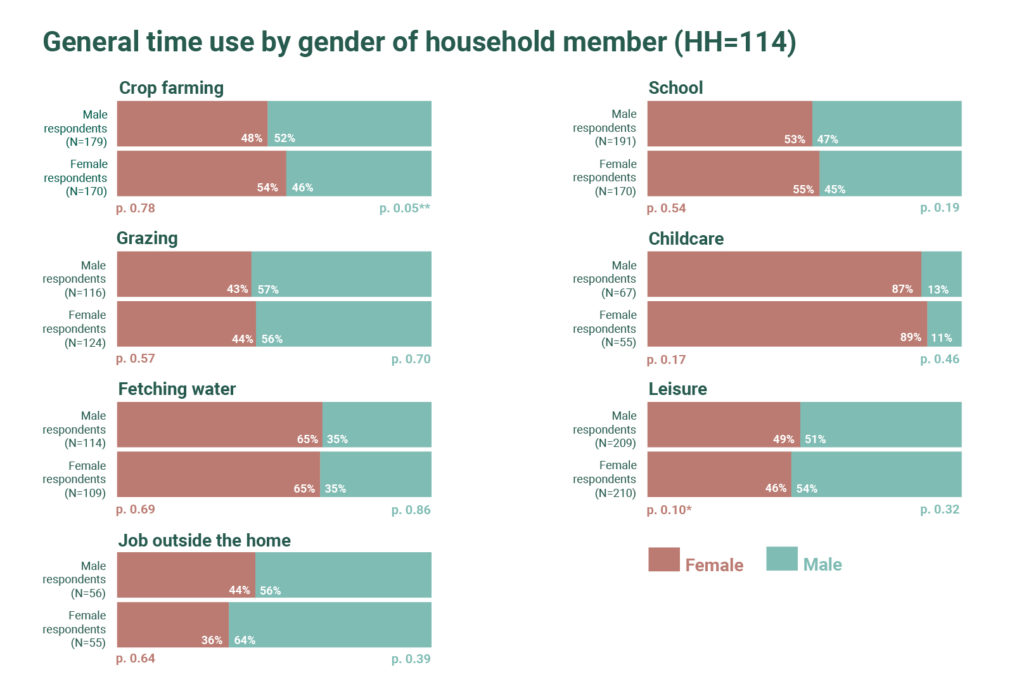
There was an overall alignment between male and female respondents on the reported activities of different age groups (Figure 2). The overwhelming majority of those in school were aged 5-20, while those aged 26-50 performed the bulk of income-generating labor, including crop farming, tending to grazing animals, and jobs outside the home, as well as tasks culturally associated with “women’s work” (fetching water and childcare). Leisure was fairly equally distributed across age groups.
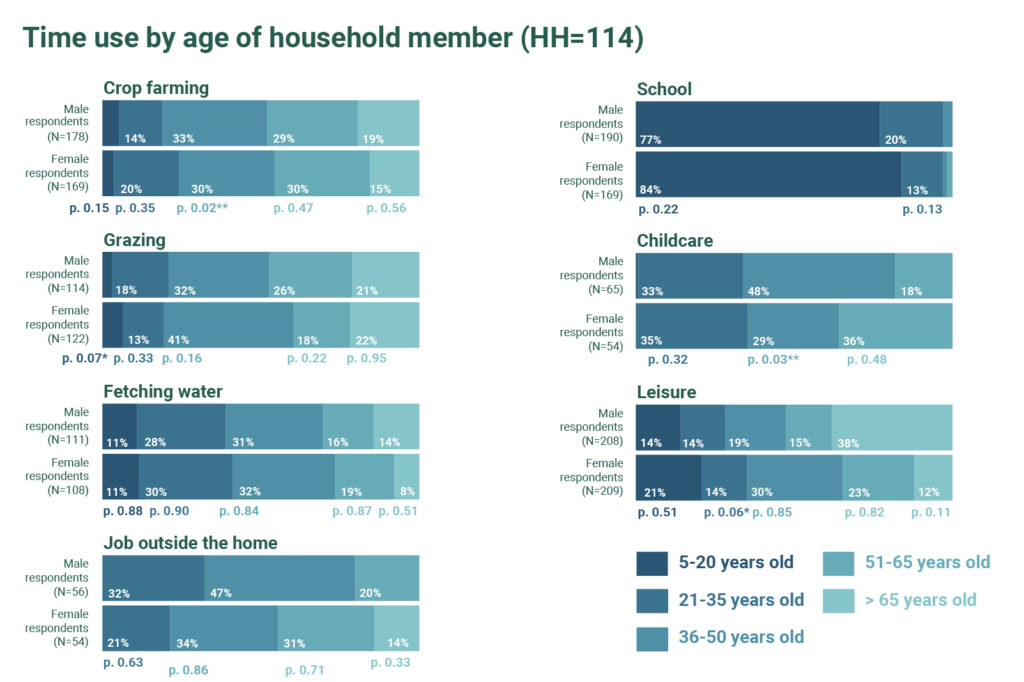
Of the 20 dairy tasks that each respondent was able to select from, nine were selected by respondents in our sample: cleaning the milking equipment, giving the cows water, feeding the cows, milking the cows, feeding the calves, transporting and selling milk, cleaning the housing unit, sourcing and threshing fodder, and sourcing feed and fodder. Figures 3 and 4 below applies the same analysis to these tasks as applied above to the responses on household time use: that is, Figure 3 analyzes the differences in male versus female respondents’ perceptions of household members’ dairy time-use by the gender of the household member, and Figure 4 analyzes this in terms of household member age group.
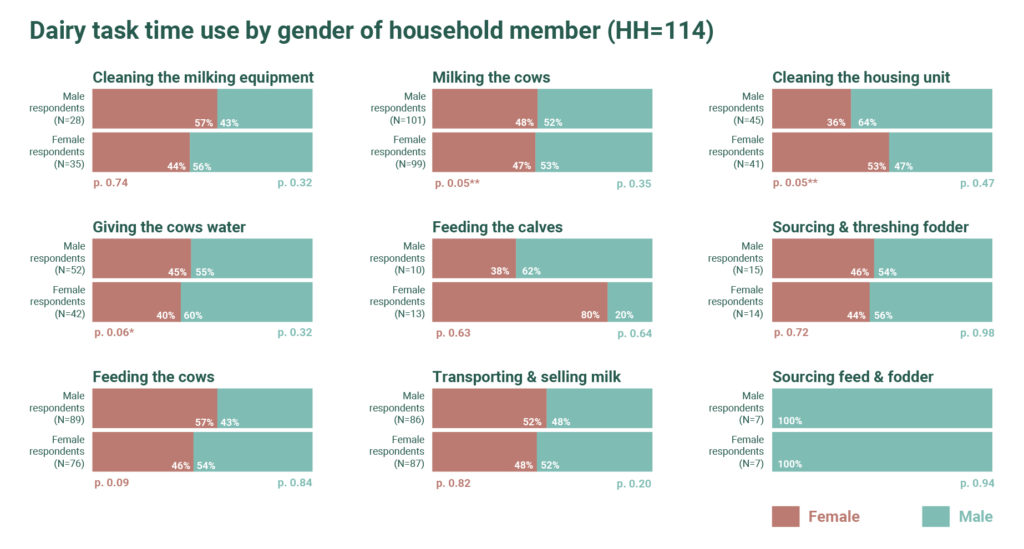
For most tasks, labor appears to be split fairly evenly by gender. A possible exception to this rule is feeding of calves, which female respondents assert is performed more by women than by men at a ratio of 4:1; men disagree on this, however, which is statistically significant at the 5% level, though the relatively low sample size makes it hard to put too much stock in this comparison. Further analysis could examine whether there is a difference based on a household’s production system. For example, in zero-grazing (or semi-zero-grazing) households, domestic tasks may account for a larger share of household labor, in turn skewing labor allocation toward the purview of women.
In addition to splitting labor by gender, dairy-related labor also appears to be distributed relatively evenly across age groups. The exceptions to this rule are “feeding the calves” and “cleaning the housing unit,” which according to female respondents – but not male respondents – is overwhelmingly performed by younger populations. Though difficult to say conclusively, a possible explanation for this difference in reporting is that female respondents may be more aware of how labor is divided on these tasks, which tend to be domestic in nature.
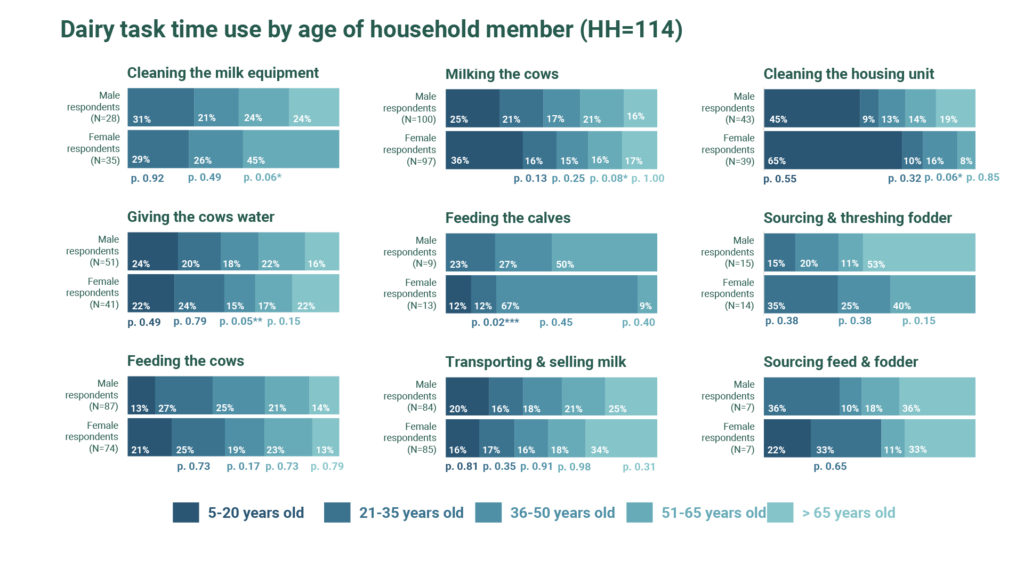
While on average there seems to be a great deal of agreement between spouses in our sample, this does not preclude the possibility of variation in the degree of agreement across households. Figure 5 below displays a measure of within household agreement by calculating the correlation coefficient in the vector of responses provided by women and men respondents in the same household. If, for example, on average, most husband and wife pairs agree on the time spent within the household on childcare, the correlation coefficient will be closer to 1. If they systematically disagree, the correlation coefficient will approach -1. If the correlation coefficient is close to zero, there is no clear agreement between husbands and wives within the same household on how tasks are distributed among household members. In our survey, there was a high degree of correlation between spousal responses for general time-use categories (i.e., crop farming, childcare, leisure, etc.).

Knowledge
Prior to measuring actual analytical skills and technical knowledge, we asked respondents to subjectively indicate which household members possessed knowledge in five categories: nutrition, artificial insemination, hygiene, disease, and feed. We then calculated the total percentage of individuals within a household perceived to have knowledge on a topic by gender (Figure 6) and age group (Figure 7).
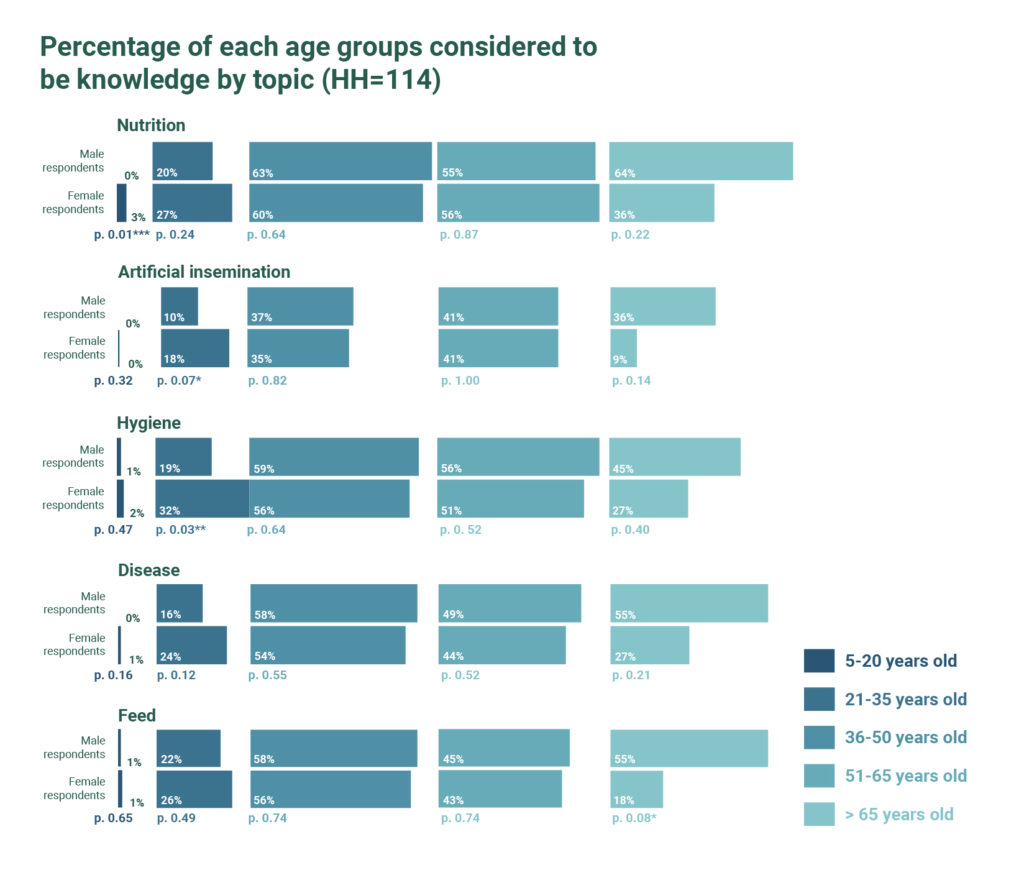

Across all categories, both male and female respondents perceived male household members to be more knowledgeable; there was broad intra-household agreement on knowledge perceptions as well (see Figure 8). Interestingly, male household members were judged to be especially knowledgeable in categories such as disease and artificial insemination; this was particularly true in the eyes of male respondents, who judged male household members to be at least twice as knowledgeable as women about these subjects. One hypothesis for this is that these subjects may carry a connotation of expertise due to their affiliation with actual professionals (i.e. veterinarians). By contrast, the perceived knowledge gap was a lot lower for other categories, such as nutrition and hygiene.
In fact, when tested, male respondents did perform significantly better than female respondents in terms of technical knowledge, with a mean score seven percentage points higher. That said, male respondents performed no better than female respondents on a test that used scenario-based questions to measure analytical thinking.
That said, two caveats must be considered in drawing conclusions from these results (shown in Figure 9): First, these results measure respondent knowledge rather than directly evaluating the knowledge of all household members. Second, the tests were brief and covered a broad array of subjects, making it impossible to evaluate whether the respondent may have deep knowledge on a particular topic. Both of these gaps suggest promising areas for future research in order to better understand the degree to which perceptions of knowledge match reality, rather than merely reflecting cultural biases; in reality, the answer may well be both, though additional empirical analysis is needed to make this claim.
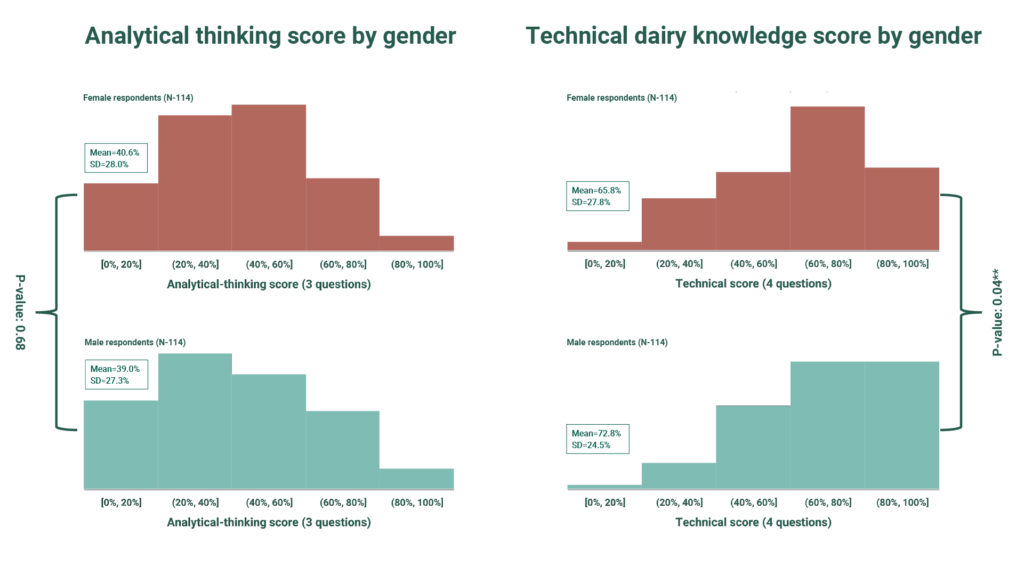
Financial Agency, Intra-Household Decision-Making, and Trust
Respondents were asked a series of questions regarding their perceptions about who controlled money within the household: who in the household purchased productive assets, purchased personal assets, purchased inputs, sold household crops, received payments for crops, received payments for milk money, made decisions about spending milk money, and owned a financial account. Figures 10 and 11, respectively, analyze these results by gender and age of the household members.
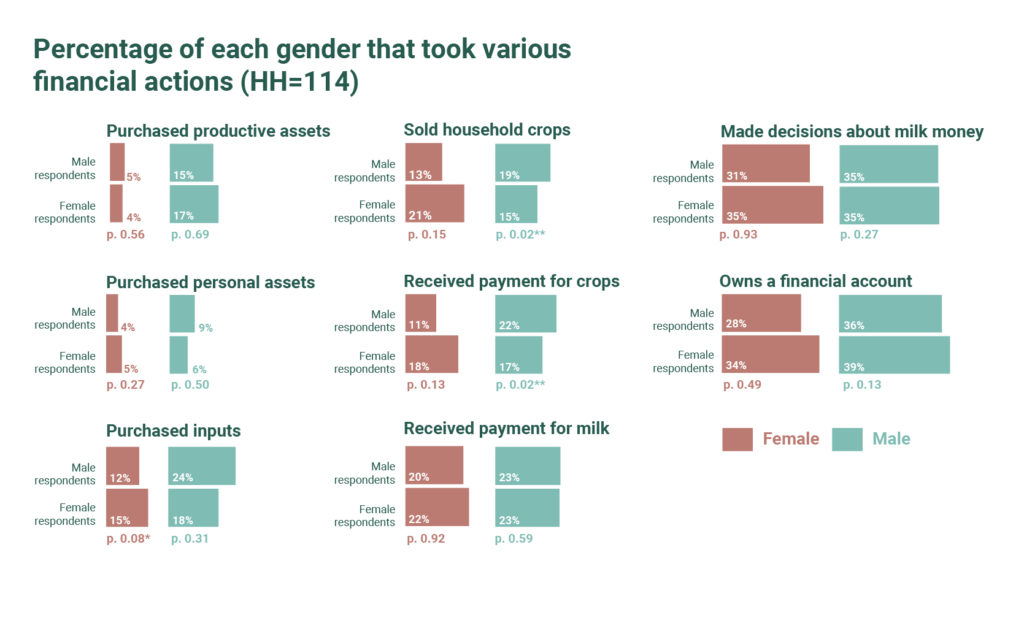
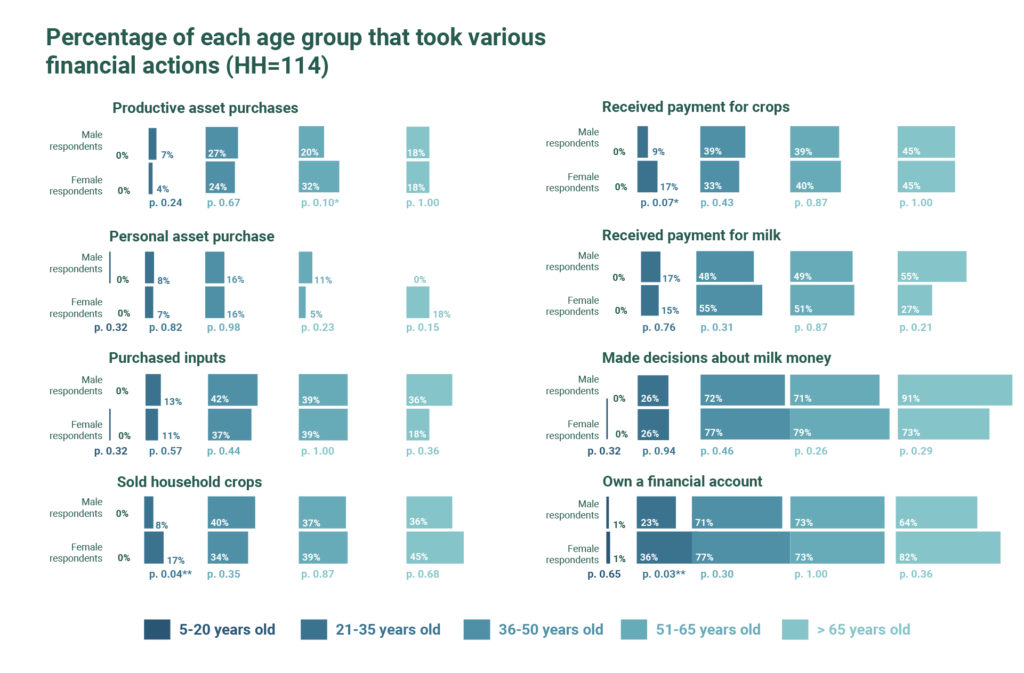
Very few household members were reported to have purchased personal assets; more – overwhelmingly men – purchased productive assets, according to both male and female respondents. Male and female respondents also agreed that payment for milk money and decisions about milk money were generally split evenly within the household. Both male and female respondents also reported that household members of both genders owned financial accounts (though men did so to a slightly higher degree).
There was less agreement by respondent gender about crop farming. Male respondents reported that male household members played a larger role in selling crops, whereas female respondents reported the opposite. This same pattern was true regarding respondent perceptions of who received payment for crops. In both cases, the difference in the perception of different genders was statistically significant at the 5% level. Additionally, while respondents of both genders agreed that more male household members purchase inputs than female household members, male respondents reported the ratio to be 2:1, while female respondents reported this difference to be marginal; this disagreement was weakly statistically significant (at the 10% level). Within households, there was also comparatively more disagreement on the measures related to crop farming and associated income, as shown in Figure 12.

There are several potential explanations for the disagreement on this measure. One potential reason is there may be an internal lack of clarity within the household about who performed which category of tasks. This does not necessarily mean that individual tasks do not have a “clear” owner; alternatively, the divisions we at PxD made for the purposes of this survey may not correspond to household constructs around the division of finances. This suggests a possible area for future research: an open-ended survey consisting of structured interviews on this topic may yield interesting insights regarding financial accountability and power within the household.
Moreover, the disagreement may reflect the fact that some tasks may be performed jointly (or in an alternating fashion) with other household members; this possibility need not be mutually exclusive with alternative divisions of labor within the household. The results in Figure 13 suggest this possibility. When asked who makes financial decisions about the farm, the majority of women (62%) and men (82%) said they made this decision together with their spouse; an additional 25% of women said they did so jointly with the household head. Even who the “primary” decision-maker was could be muddled, with 72% of women and 50% of men claiming to occupy this role jointly with either a spouse or household head.
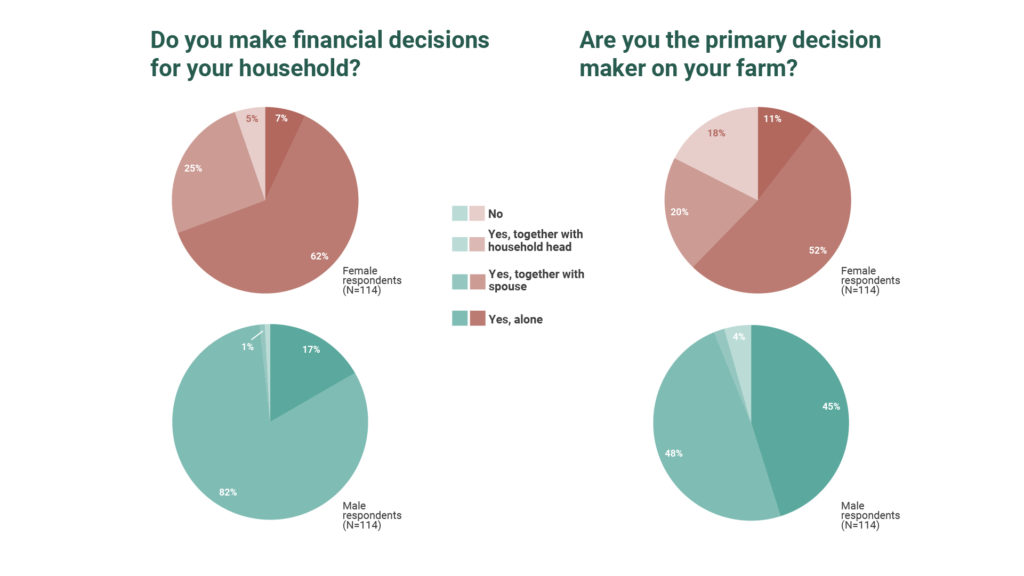
These results are ambiguous regarding whether each decision is made jointly or whether men and women have different spheres of influence within the household (and financial discretion within those spheres). However, the Likert scale questions, in which respondents were asked to agree or disagree with a number of statements about intra-household decision-making suggest that many decisions are made jointly – or at least with a substantial discussion between household members. (Figure 14)
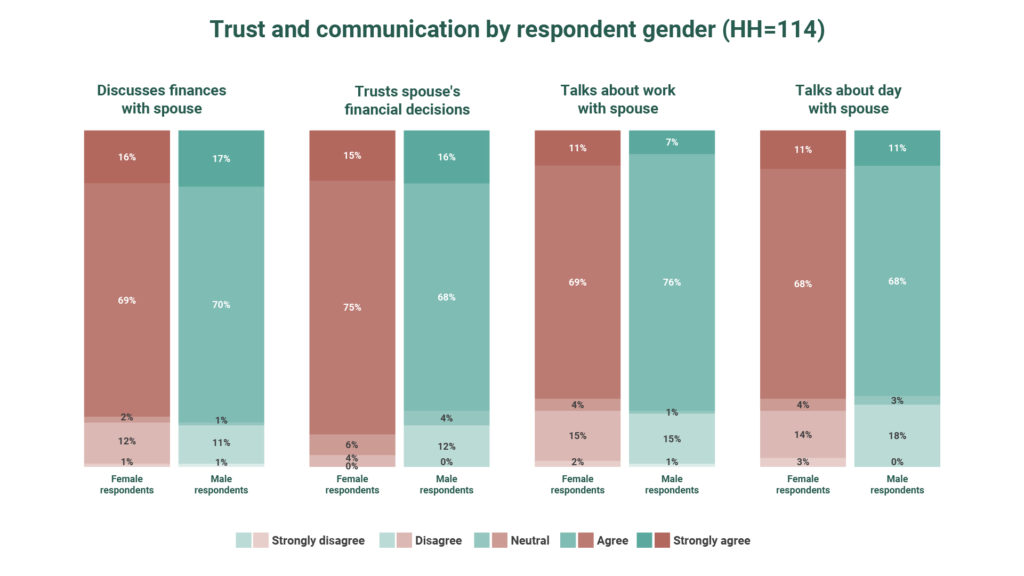
Eighty-five percent of female respondents and 87% of male respondents reported that they discussed finances with their spouse; moreover, 90% of female respondents and 84% of male respondents reported that they trusted their spouse’s financial decisions.
In order to empirically test these subjective responses, we also asked respondents to participate in a “public goods game,” in which they could choose to augment a portion of the financial incentive they earned for completing the survey (100 Ksh, or about 1USD) to a common account. Contributing a greater amount theoretically indicates a greater degree of cooperation with one’s spouse since the amount in the common account was split evenly between spouses after both completed the exercise, regardless of how much each spouse contributed individually. The results of this game suggest a moderate amount of trust, with contributions for both women and men clustering around the midpoint of the range between zero and the total possible contribution. Figure 15 displays the distribution of these respondents’ contributions. While male respondents contributed more on average (statistically significant at the 5% level), the plurality of respondents of both gender contributed a medium amount (i.e., 40-80 Ksh)
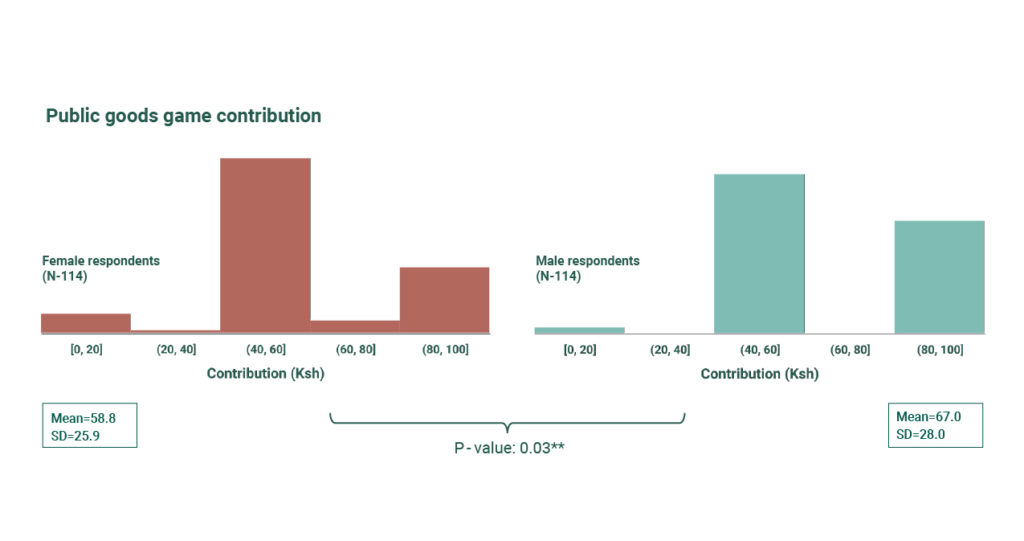
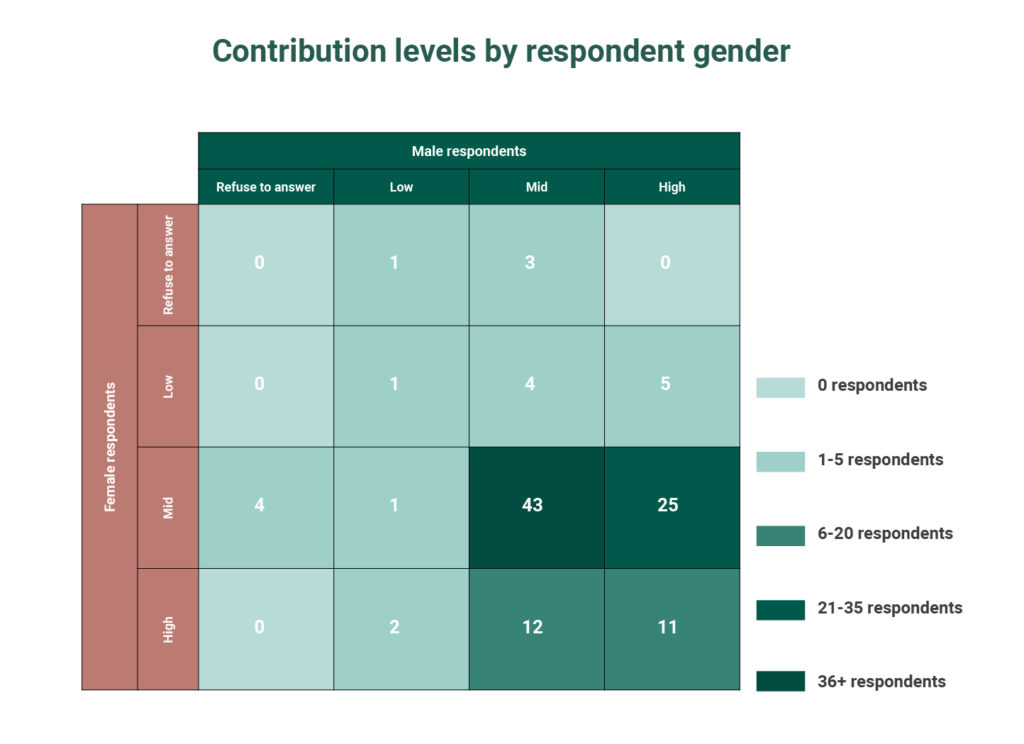
One way to empirically evaluate whether the public goods game in practice aligns with subjective cooperation in the household is to directly compare these results. First, we regressed the correlation coefficient between the spouse’s individual Likert responses – that is, the degree to which husband and wife agreed about their level of trust or communication – on the various contribution categories (limited the covariates to the bottom quadrant of Figure 16, to make sure each category reflects a sufficient sample of people to draw meaningful conclusions). The results of this regression are shown in Table 2. There was not a high correlation between these metrics, with none of the contribution categories predicting agreement between the spouses regarding the degree of cooperation.
The next stage of analysis was to compare directly the responses to the Likert scale questions on intra-household communication and trust to the public goods game contributions. To do so, we first split the sample by respondent gender and then ran ordered logit regressions separately for each sample (Table 3). In these regressions, a positive coefficient signifies that a member of a household in that specific contribution category is more likely to “strongly agree” with the statement. To make this concrete, the variable “female mid, male high” in the female sample is equal to one for a member of that population who contributed a medium amount (40-80 Ksh) and whose husband contributed a high amount (80-100 Ksh), and is equal to zero otherwise. A positive coefficient on this variable means that a respondent in this category is more likely to “strongly agree” with an affirmative statement on the Likert response; e.g. for the first regression in the table, she is more likely to say she often discusses finances with her spouse. While all the coefficients for the regressions on the male sample and about half of the coefficient for the regressions on the female sample are positive, none of the results in either sample are statistically significant.
Since the public goods game contributions do not align with subjective measures of intrahousehold cooperation, it is unclear whether respondents are less trusting in practice than they aspirationally report to be on the subjective questions, or whether the public goods game does not accurately measure intrahousehold trust. The answer may be a combination of the two or may vary by Likert category. This suggests an area for future research.
Next Steps
This information is valuable for informing the design and operation of a dairy service that empowers rather than further marginalizes female farmers. It bears mentioning that we will continue to monitor engagement by gender to validate the insights of this survey on an ongoing basis and to make sure that we continue to reach women farmers.
That said, there are a few points we can take away from this dataset –
and we can use it to identify areas for additional research:
- In general, women and men reported that they split labor related to crop farming and grazing, and both females and males reported going to school and pursuing leisure activities. Unsurprisingly, women reported spending more time fetching water and engaging in childcare relative to men, and men were more likely to have a job outside the home. Perhaps more surprisingly, most dairy tasks were split relatively evenly by gender. Further research could investigate the ways different production systems influence household division of labor: for example, since women generally take charge of more domestic tasks, in zero-grazing households is dairy-related labor more commonly performed by women?
- Both men and women perceived men to be more knowledgeable on all topics asked about (nutrition, hygiene, artificial insemination, and feed). One positive of digital advisory compared to traditional in-person systems is that both women and men are able to read the advice on their own, and thus may be less subjected to the influence (and doubts) of peers and other household members. However, this knowledge gap may have implications for marketing: if women are systematically viewed as less knowledgeable, men may find a service that aims to disrupt that balance in the household to be threatening. Additionally, the perceived knowledge gap may pose a barrier to adoption of recommendations by women if proposed without male buy-in and perceived to not know what they are talking about.
- The allocation of financial power in the household was far from clear-cut. A similar proportion of both genders received payment for and made decisions regarding milk money, and respondents of each gender disagreed as a group about which gender sold and received payment for crops. Additionally, the majority of respondents of both genders reported making financial decisions and being a “primary decision-maker” – either individually or jointly with a spouse or household head. Finally, both male and female respondents reported discussing finances with their spouse and trusting their spouse’s financial decisions. While this has positive implications for adoption of advice by both genders, it also suggests that many decisions are made jointly and buy-in from both spouses is necessary for implementation.
- The responses of respondents of both genders to the Likert scale questions suggest a high level of intra-household communication, trust, and cooperation, at least in the subjective opinions of respondents. Similarly, the vast majority of respondents of both genders contributed at least a medium amount (40 out of a possible 100 Ksh) to the common account in the public goods game. This has positive implications for adopting recommendations, which in many cases will require collective household buy-in. That said, there remains opportunity for a more granular understanding of intra-household cooperation. For example, how does it differ in households with more defined household and/or farming roles, or in households where one spouse is clearly knowledgeable? (While this dataset contains questions to this effect, the sample size is too small to draw meaningful conclusions about precise subsets of respondents.) Outside of this data, what impact do production systems (i.e. zero-grazing) and use of particular technologies (e.g. machinery such as chaff cutters or other equipment, such as durable water tanks) have on the level of intra-household cooperation?
While the effort to better understand our service users is ongoing and our efforts to improve content and delivery are constantly evolving, this data collection yielded meaningful insights and constituted a significant step towards inclusive product and service design that can be put to use in PxD’s Kenyan dairy service – and more broadly in programming across the region.
Tomoko Harigaya, PxD’s Chief Economist and Director of Research, reflects on the work of the 2021 Nobel Prize winners in Economic Sciences, and how their contributions to the field have informed PxD’s research practice.
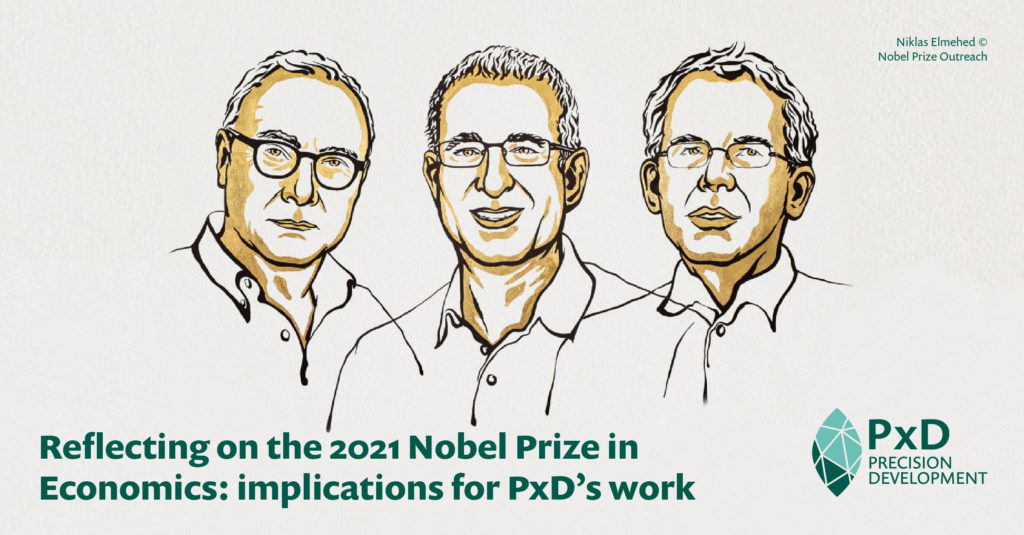
Last week, Jonathan Faull, our Director of Communications, sent me a WhatsApp message: “I had a dream that Owen [PxD’s CEO] woke me up with a phone call to tell me Michael [Kremer] won the Nobel again…”. I laughed and responded saying that he was working too much.
Jonathan’s dream didn’t become a reality, but it wasn’t too far off in spirit. I woke up on Monday, thrilled to learn that the three empirical economists, David Card, Josh Angrist, and Guido Imbens, had won the [deep breath] 2021 Sveriges Riksbank Prize in Economic Sciences in Memory of Alfred Nobel. As per the Royal Swedish Academy of Science’s press statement, Card won the prize “for his empirical contributions to labour economics”; Angrist and Imbens won “for their methodological contributions to the analysis of causal relationships”.
The laureates’ work on natural experiments and empirical methodologies for causal analysis has shifted the field of economics’ focus towards empirical rigor. Continuous, incremental advances in causal inference methodologies, following Card, and Angrist and Imbens’ groundbreaking work in the early 1990s, expanded the economists’ toolbox, improving our ability to generate credible answers to important policy questions through both experiments and quasi-experiments.
Here is how one specific contribution of the laureates, acknowledged by the Swedish Academy of Sciences, improves our ability to understand program impact in the context of PxD’s service:
Randomized experiments are considered a “gold standard” because of the counterfactual that researchers can establish through random assignment of an intervention. However, in real-world experiments, whether implemented through a government or a non-government partner, enforcing random assignment is often not an option. Angrist and Imbens introduced an application of a statistical method to estimate a relevant average treatment effect in these cases.
Suppose that the average proportion of farmers who listen to PxD’s advisory messages fluctuates around 60% in India. When we evaluate the impact of our service by randomizing the offer to access the service, we expect that approximately 40% of the farmers in the treatment group would not listen to advisory messages. Our benchmark analysis typically compares all farmers assigned to the treatment group to all farmers assigned to the control group, regardless of whether they actually “take up” the service and listen to advisory messages or not. But this comparison only tells us the average effect of the offer to access the advisory service, not the average effect of the advisory service itself. It is a fairly common practice to scale the estimated impact from this benchmark comparison (the “intent-to-treat” or ITT effect) by the difference in the take-up rate between the treatment and control groups to obtain the average impact of the service for an engaged farmer (the “treatment-on-the-treated” or TOT effect). A policymaker may be interested in the cost-effectiveness implications from the ITT estimates, but the TOT estimates are useful for implementers trying to iterate product design and improve the impact per farmer.
The ITT is a weighted average of the treatment effect among those who can be induced to listen to advisory messages under the intervention and the treatment effect among those who would not listen to the messages regardless of the intervention. Since the latter effect is likely to be zero – if a farmer doesn’t listen to messages when offered the service, the advisory service is unlikely to change their behavior – we could scale the ITT by the take-up rate of the advisory service to get the average impact among those who choose to listen to messages when offered the service.
Angrist and Imbens brought clarity to when – and for whom – this TOT estimate could capture a valid average treatment effect. When uncertain, they showed that if simple conditions are met, the instrumental variable (IV) approach can be applied to recover the average treatment effect but only for a specific subgroup of the study population – often called “compliers” – who are induced to receive the treatment under the intervention but otherwise wouldn’t. In the example of PxD’s service cited above, this means that using the average treatment effect of PxD’s advisory service, we can estimate the average impact among those who choose to listen to messages when offered the service.
This may seem like a minor refinement in the interpretation of impact estimates from experiments. But these details make a meaningful difference in how we understand what we know and what we don’t and how we apply that understanding to the next phase of testing and scaling.
As Angrist and Jörn-Steffen Pischke put it crisply in a 2010 review of the “credibility revolution” in economics:
This year’s Nobel prize is a recognition that the process of building credible empirical knowledge holds the rigor of research design and empirical methods at its core.
Vaishnavi Surendra, Post-Doctoral Researcher, and Revati Vaidya, Process and Product Innovation Associate, mark the International Day of Rural Women
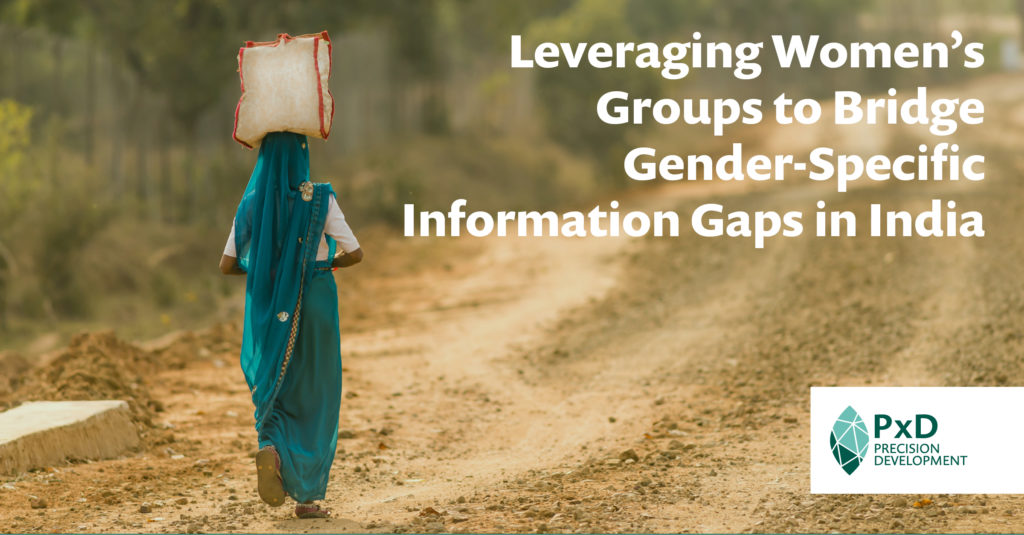
At PxD, we aim to generate research and design products and services that bridge information gaps for people living in poverty. On this International Day of Rural Women, we reflect on our efforts to understand the unique challenges confronting rural women, and how PxD’s digital services can complement the work of women’s groups to empower and serve the needs of rural women.
Gendered constraints and PxD’s existing services
How does one design products and services for women that meet their unique information needs in a scalable manner?
Cultural norms and socio-economic structures often restrict women’s autonomy, mobility, and economic opportunities. When women seek financial service, healthcare, entitlements, or other livelihood-enhancing products and services, they are likely to confront a number of constraints. In addition to the barriers associated with lower levels of literacy, digital literacy, education, autonomy, or mobility that inhibit demand and restrict women’s opportunities, many rural contexts offer a limited or nonexistent supply of products and services designed to meet women’s needs.
Unsurprisingly, women’s access to and engagement with our mobile phone-based services lags that of their male peers. We estimate that 23% of our 4.4 million current users are women. To make our existing services more accessible and relevant to women, we are iterating both the content of our advisory services and ways in which users can access them. For instance, in Odisha, we recently conducted a gender-scoping survey to more effectively understand how access, time use, and division of labor vary by gender. We found that women farmer-users, inter alia, are more likely to be engaged in livestock rearing, the cultivation of horticultural crops, and the tending of kitchen gardens. As a consequence, we now provide advisory tailored to these activities to increase women’s engagement with our services.
A more complex challenge is that women often don’t have access to mobile phones. PxD’s services generally rely on users having direct access to a mobile phone to scale the dissemination of information. Gender gaps in mobile handset ownership, and cultural norms that constrain women’s access to and use of mobile phones, complicate our ability to meet the needs of women using digital information dispensed via mobile phones. In India, for example, only 38% of women own mobile phones, compared to 71% of men (Barboni et al., 2018). This gap is likely to be even larger in rural areas. We are currently exploring whether nudging male users registered on our Ama Krushi service in Odisha to switch on their mobile phone’s speaker when they receive advisory calls to facilitate greater women’s engagement. An additional line of inquiry – about which we are particularly excited – is to interact with women users via women’s groups rather than attempting to serve individual women directly.
Women’s groups in India
In many contexts, women’s groups are a popular approach to empowering women and addressing gender gaps. While the specific structure, membership, and goals of these groups vary across contexts, they generally share the following features: (i) voluntary membership; (ii) members’ contribution of time, money, or other assets; and (iii) regular face-to-face interaction among members (Biscaye et al., 2014; Dìaz-Martin et al., 2021). Women’s groups typically aim to provide members with knowledge, training, access to financial products, or access to agricultural input and output markets to facilitate improved livelihoods, financial inclusion, better literacy, and numeracy. In all instances, greater access to information has the potential to complement and enrich these offerings.
In India in particular, policymakers and practitioners increasingly view women’s groups as effective platforms capable of scaling the delivery of a range of interventions at a relatively low cost per person (Gugerty et al., 2019). Moreover, women’s groups are perceived to effectively leverage social interactions among group members to improve the impact of each intervention. In India, women come together in women’s cooperatives, farmer producer organizations, entrepreneurial marketing organizations, women’s labor collectives, microfinance groups, and most commonly in self-help groups (SHGs). Currently, there are over 7.2 million SHGs registered with the NRLM, the largest such program in the country. Areas in which women’s groups are active in expanding access and use of services and resources include access to financial services (e.g., the National Rural Livelihoods Mission (NRLM)), community health and access (e.g., the Swayam Shikshan Prayog program), and livelihood training (e.g., the National Bank for Agricultural and Rural Development’s (NABARD) Microcredit Innovation program).
Existing evidence indicates that women’s groups have been successful in facilitating greater financial inclusion (for instance, in Hoffmann et al., 2021; Banerjee et al., 2015), and some evidence suggests that their activities have had moderate effects on small business investments and profits (such as in Banerjee et al., 2015). Certain women’s groups have also successfully improved women’s political (Prillaman, 2021), economic and social empowerment (Brody et al., 2015) while others have demonstrated no such impacts (for instance, in Joshi, Palaniswamy, and Rao, 2015; Hoffmann et al., 2021). Most relevant to our use-case, in a study of 1,000 women across five states in India, Raghunathan et al. (2019) find that the provision of agricultural extension services through self-help groups improved women’s access to information and their participation in some agricultural decision-making, but that this had limited impact on agricultural practices or outcomes.1
We are confident that women’s groups in India can be effectively leveraged in ways that enable more women to access mobile phones within their groups, and engage with mobile-based services more meaningfully, than what might be possible utilizing strategies targeting individual women users. Moreover, we believe that such groups might help women access relevant information in a friendly and supportive environment since they tend to be spaces that foster and rely on camaraderie and trust. A demonstrated strength of women’s groups in India (SHGs and otherwise) is their ability to scale and bring the benefits of scale to members at the grassroots level. This is demonstrated, for example, by efforts to federate SHGs by consolidating them across villages, blocks2, and districts under the NRLM; and through the structures of SEWA, a national federation of ‘organizations of women working in the informal economy’.
Moving forward
We see women’s groups as an opportunity for PxD to reach more women with information that has the potential to improve their lives and empower them as community leaders. Examples of initiatives we are exploring are:
- Using our existing IVR-service to connect to one phone in each group during group meetings to provide technical assistance relating to agricultural practices; to facilitate training for improved access to and meaningful use of digital services (e.g., digital finance); and/or deliver nudges and encouragement to assist women with planning and management of things like individual or household finance, educational investment, or entrepreneurship. In addition to encouraging group members to share the phone, and therefore increase the reach of PxD’s digital information delivery, we also anticipate that disseminating information in groups may facilitate “social learning” among group members; for example, early adopters of PxD’s recommended agricultural practices may encourage their peers to adopt similar approaches by demonstrating positive results.
- We also see women’s groups as being effective vehicles for facilitating the aggregation of information from markets or communities through crowdsourcing, and the potential to set up a directory or repository of agglomerated information that can be accessed across user-groups. For instance, in contexts where women have limited access to information on market conditions (such as input availability, the price of inputs and of outputs, what services are available and useful, job opportunities close to their homes, etc.), a PxD service may be effective in facilitating the sharing of leads or information within and between groups during meetings. By implication, a service or platform like this is more likely to have information relevant to the needs and interests of women.
- Finally, we also see being able to complement the existing goals of many such groups and collectives by affirming women as community leaders. Part of this may entail delivering specific digital training to women’s groups or helping women become resource persons for their local communities. This might be useful in areas such as pest identification and management, or for information about community natural resources and their management. The group structure may also assist more women to access relevant information and training than if it was limited only to women with access to phones. The perception of additional leadership credentials, or the facilitation of greater leadership agency, may accrue as a consequence of women acting as “agents” who can connect with PxD’s services and deliver information to community members who lack mobile phone access.
We are excited by the potential of these channels for improving women’s economic outcomes, increasing their bargaining power, and affirming women leaders — and facilitating leadership roles — within their communities. We are actively looking for partner organizations to work with us to iterate our ideas and bring them to fruition. We look forward to keeping you posted as we proceed!
References:
- Banerjee, Abhijit, Esther Duflo, Rachel Glennerster, and Cynthia Kinnan. 2015. “The Miracle of Microfinance? Evidence from a Randomized Evaluation.” American Economic Journal: Applied Economics. 7(1): 22–53.
- Barboni, Giorgia, Erica Field, Rohini Pande, Natalia Rigol, Simone Schaner, and Charity Troyer Moore. 2018. “A Tough Call: Understanding barriers to and impacts of women’s mobile phone adoption in India.” Evidence for Policy Design: Harvard Kennedy School.
- Biscaye, Pierre, Zoe True, Christopher Clark, Katie Panhorst Harris, Leigh Anderson, and Mary Kay Gugerty. 2014. “Self-Help Groups in Development: A Review of Evidence from South Asia AndSub-Saharan Africa.” EPAR Brief 283.
- Brody, Carinne M, Thomas De Hoop, Martina Vojtkova, Martina, Ruby Warnock, Megan Dunbar, Padmini Murthy, and Shari Dworkin. 2015. “Economic Self-Help Group Programs for Improving Women’s Empowerment: A Systematic Review.” Campbell Systematic Reviews 19.
- Dìaz-Martin, Lucia, Akshara Gopalan, Eleonora Guarnieri, and Seema Jayachandran. 2021. “Greater than the Sum of the Parts? Evidence on Mechanisms Operating in Women’s Groups.” Working Paper.
- Gugerty, Mary Kay, Pierre Biscaye, and C Leigh Anderson. 2019. “Delivering development? Evidence on self-help groups as development intermediaries in South Asia and Africa.” Development Policy Review, 37(1): 129–151.
- Hoffmann, Vivian, Vijayendra Rao, Vaishnavi Surendra, and Upamanyu Datta. “Relief from Usury: Impact of a Self-Help Group Lending Program.” Journal of Development Economics, 148: 102567.
- Joshi, Shareen, Nethra Palaniswamy, and Vijayendra Rao. 2015. “Impact Evaluation Framework and Results: Odisha Rural Livelihoods Project.” The World Bank.
- Prillaman, Soledad Artiz. 2021. “Strength in Numbers: How Women’s Groups Close India’s Political Gender Gap.” American Journal of Political Science, forthcoming.
- Raghunathan, Kalyani, Samyuktha Kannan, and Agnes R. Quisumbing. 2019. “Can women’s self-help groups improve access to information, decision-making, and agricultural practices? The Indian case.” Agricultural Economics, 50: 567–580.
1 Diaz-Martin et al., 2021 provides a comprehensive overview of the evidence.
2 In India, a block is a subsidiary administrative unit below a district.
Tomoko Harigaya, PxD’s Chief Economist and Director of Research, and Caitlin McKee, Global Research Support Manager (with input from across the Research Team) detail lines of new inquiry intended to build our research base and increase the impact of our advice and services.
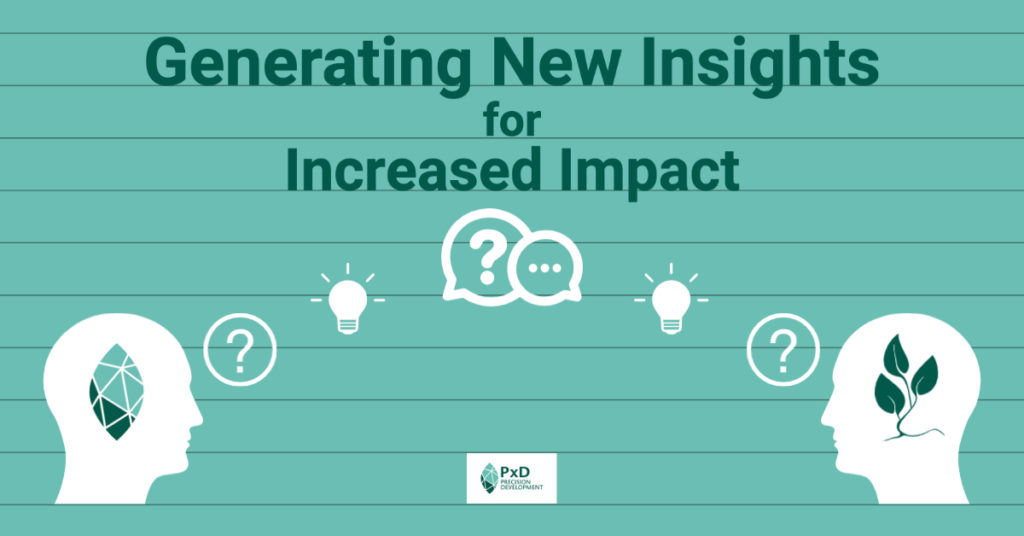
In 2020, PxD’s research team received dedicated funding to build out our evidence base. We are deploying these funds to support a portfolio of complementary and reinforcing projects in multiple geographic settings. This blog post describes how these new initiatives – many of which deploy innovative research methods – fit together and generate insights to advance PxD’s learning and the impact of our services.
Through the course of 2021, we commenced various innovative research initiatives with the intention of generating insights about how customized agronomic advice – facilitated and delivered by digital tools – affects farmer behavior and outcomes. A concurrent objective is to demonstrate the potential of digital agricultural extension to increase impacts over time – and at scale – through rigorous, evidence-based iteration and experimentation.
These new research activities consist of a mix of rigorous impact evaluations of PxD’s advisory services and smaller-scale testing of deep customization utilizing local or dynamic information with each project has been designed to develop insights on a combination of the following:
- Rigorous impact evidence on farmer outcomes;
- Theory of change supported by existing evidence, local data, and behavioral theories;
- Proof of concept, operational feasibility, or scalability in customizing and delivering advice; and
- Quantitative evidence to show improvements in intermediate outcomes like adoption of recommended inputs or practices.
Here are some of the ways in which these research projects will generate insights:
1. Rigorous evidence from impact evaluation on farmer outcomes:
Three impact evaluations will generate evidence on outcomes of farmer welfare:
- An impact evaluation of our Ama Krushi service for rice farmers in Odisha, for example, will measure rice yields. This impact evaluation also includes an assessment of the feasibility and accuracy of satellite-based approaches to rice yield measurement.
- An impact evaluation of Dairy Advisory Services in Kenya will make use of partner dairy cooperatives’ administrative data on output and sales to evaluate the impact of dairy advisory on farmers’ welfare, measured by milk production and profits.
- A third impact evaluation of the Coffee Agronomy Training in Uganda (UCAT) service will generate evidence on the impact of PxD’s stand-alone mobile phone-based advisory service on coffee yields, and the impact of PxD’s advisory messages as a complementary service to an in-person agronomy training on management practices.
2. Theory of change supported by existing evidence, local data, and behavioral theories:
In its second year of implementation, the treatment arm of the Ama Krushi impact evaluation will incorporate A/B tests to generate evidence against hypothesized causal mechanisms about how digital advisory can encourage farmers to adopt recommended practices, further building out PxD’s theory of change. The Dairy Advisory Service in Kenya will run content development workshops to source local insights to build out our theory of change and refine our understanding about how digital advice can address barriers to improved livestock management and achieve desired welfare gains.
3. Proof of concept, operational feasibility, or scalability of customization and the delivery of advice:
Agro-dealer engagement activities in Kenya will include mechanisms to identify a low-touch and scalable model for building a network of agro-dealers we can tap into to complement and reinforce MoA-INFO messaging with, and improve market linkages for, farmers. Our intention is to design and create services that agro-dealers will find valuable and engage with, and then generate insights about how these services can affect farmer’s input search behavior and access to inputs. We are piloting various strategies via our Krishi Tarang service in Gujarat to recruit and collect information from agents who live and work in communities where PxD’s farmer users live. This project will assess the feasibility of different approaches for crowdsourcing information from agents and farmers to improve the relevance and timeliness of advisory content. Crowdsourcing techniques can potentially inform approaches for collecting other time-dependent and/or locally relevant information such as GPS location data, the prices that farmers pay for inputs, the prices that farmers receive for produce, and weather-related information.
4. Quantitative evidence to show improvements in intermediate outcomes:
The Digital Tools for Extension Agents project in Rwanda aims to understand the motivations of volunteer community extension agents known as Farmer Promoters (FPs), and test the impact of motivational messages, customized to individual agent’s personality traits, on the performance and outcomes of the farmers they advise. We will generate quantitative evidence on FP performance to assess the marginal impact of better-targeted advice for FPs on farmer learning and outcomes, the impact of nudges on different activities, and how FPs allocate their effort when they’re being incentivized to work on a particular task. The Peer Group Learning project in Kenya aims to demonstrate the potential value of organizing users of PxD’s digital agricultural advisory service into peer groups. This project will generate quantitative evidence on improved knowledge and adoption of recommended practices through peer learning promoted via farmers’ organizations. In order to better understand this learning pathway, we will measure engagement with the MoA-INFO platform, the volume of communication within a peer group, and user trust in the information that is shared.
Summary of projects with categories and insight types to be generated
| Project | Location | Insight types |
| 1. Impact evaluation of Ama Krushi service for rice farmers | Odisha, India | i, ii, iii, iv |
| 2. Impact evaluation of Dairy Advisory Services | Kenya | i, ii, iii, iv |
| 3. Impact evaluation of Coffee Agronomy Training | Uganda | i, iii, iv |
| 4. Digital Tools for Extension Agents | Rwanda | iii, iv |
| 5. Peer Group Learning | Kenya | iii, iv |
| 6. Crowdsourcing Pest Information | Gujarat, India | iii |
| 7. Agro-dealer Engagement | Kenya | iii |
We have intentionally designed these initiatives so that they reinforce and complement one another. While these activities remain nascent, we are very excited by their potential to generate insights and increase the impact of our work across geographies and contexts.
Sam Carter, Revati Vaidya, Simon Rubangakene, Georges Poquillon and Habtamu Yesiget recount how we improved our content and services by learning about our end-users response to messages recorded with men’s voices and women’s voices.
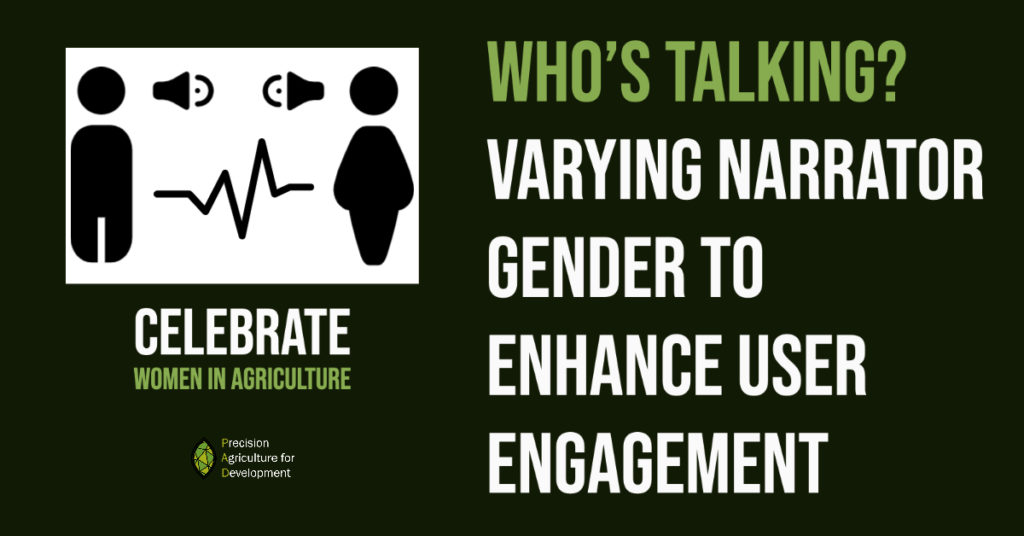
Do farmers act differently when they hear a woman’s voice giving them agricultural advice? How much does this matter in the nine different countries where we operate? These are questions we often ask ourselves since interactive Voice Response (IVR) and push calls are the bread and butter of our outreach to smallholder farmers.
Rigorous research is in our DNA, since PAD was born out of a study proving that mobile-phones can cheaply deliver actionable agricultural advice to farmers. We routinely test and evaluate different versions of our service to identify the best way to engage farmers with our services and, ultimately, turn our advice into action. We’ve tested the length of voice calls, the order in which menu options are presented, and use of urgent language in our messages among many others.
In Uganda, Ethiopia, and India, PAD has conducted A/B tests to understand whether the gender of the person narrating the advisory content has an impact on farmers’ pick-up and listening rates. In Uganda, we found that switching from a male to female narrator increased farmers’ engagement with PAD content, and as a result, we will use a female narrator for all new content developed for that program. In Ethiopia, on the other hand, we found that both pick-up and listening rates were higher when content was voiced by a male narrator than a female narrator. Meanwhile, in the Indian state of Gujarat, we found no statistically significant difference in engagement rates based on the gender of the narrator. Taken together, these results suggest the need for a nuanced, contextually-grounded approach to understanding the role that the narrator’s voice plays in determining farmers’ engagement with our service.
This blog post presents a summary of each experiment design and its results, and teases out the implications of these results in time and place:
Uganda
Simon Rubangakene, Project Associate and Georges Poquillon, Senior Research and Operations Manager
PAD’s service in Uganda
In Uganda PAD delivers digital training to smallholder farmers as part of an initiative run by Uganda Coffee Agronomy Training (UCAT) – a program implemented by the non-profit organizations Hanns R. Neumann Stiftung and TechnoServe – which delivers training to approximately 60,000 farmers in western Uganda via Farmer Field Schools. UCAT aims to train farmers to implement Good Agronomy Practices (GAPs) to increase yields and – by association – livelihoods.
PAD provides digital training to 4,000 UCAT farmers who are participating in a randomized evaluation in which farmers receive standalone and reinforcement training. The evaluation intends to understand the impact of varied approaches to agronomy training and/or extension services.
PAD’s digital advisory is pushed to farmers’ mobile phones in four different languages (English, Luganda, Runyankole and Rutooro). Standalone farmers who are not part of the UCAT program are also able to call in and record questions, which are answered by an agronomist within 48 hours. Standalone farmers and those attending training run by Hanns R. Neumann Stiftung receive IVR calls on a weekly basis, whereas farmers attending training run by TechnoServe receive advisory messages once a month.
How the A/B test varied the gender of the narrator, and why we decided to test this question
Prior to this A/B test, PAD’s advisory service in Uganda included content delivered by both male and female narrators. Due to the way in which language-use was distributed, few farmers receiving advisory from PAD were receiving advice voiced by a female narrator which made it difficult to identify listening patterns linked to voice. The Uganda team decided to implement an A/B test to better understand how farmers’ listening rates varied based on the voice of the narrator.
The study ran for eight weeks, from October 14, 2020 to December 9, 2020, a time coinciding with the runup to, and active period of the coffee harvest in Uganda. For this A/B test, we randomly assigned the 4,009 UCAT farmers receiving advisory from PAD to one of two groups. Group 1 (2,004 farmers) received content voiced by a narrator whose gender did not match their own. Group 2 (2,005 farmers) received content voiced by a narrator of the same gender. We stratified the sample to ensure that both groups were balanced in terms of language and the organization implementing the in-person training.
Results of this A/B test
Switching the message content from being voiced by a man to being voiced by a woman positively and sustainably increased the probability that female farmers picked up IVR calls, while there was no effect on the likelihood of a male farmer taking a call. With regard to the propensity to listen to most of the IVR call content, switching from a female to a male narrator reduced the listening rate of male farmers, while the opposite held true when switching from a male to a female narrator. However, the effect on the male completion rate was found to be lower over time. In the case of female farmers, switching from a male to a female narrator increased the likelihood that they listened to most of the message, with more long-lasting effects.
The findings suggest that both male and female UCAT farmers are more sensitive to messages voiced by a female narrator. However, the short-term nature of some effects may prevent such a change from generating long-run changes in farmers’ engagement. Moreover, only two narrators of each gender were involved in the recording, so we cannot rule out the possibility that we are capturing a “narrator” effect rather than a gender effect.
Implications for programming and future research
A direct consequence of the findings of this study is that the new UCAT content will be entirely voiced by female narrators. Farmer engagement following the introduction of this new content will be monitored to assess whether any change arises, leading to improved listening and completion rates.
Ethiopia
Habtamu Yesigat, Director of Programs, Ethiopia
PAD’s service in Ethiopia
PAD has collaborated with the Ethiopian Agricultural Transformation Agency (ATA) since 2017 to measure and improve the effectiveness of ATA’s 8028 farmers’ hotline service. The 8028 farmers’ hotline, introduced in 2014, is an IVR service available in five languages which has reached more than 5.4 million farmers. A farmer can call into 8028 – free of charge – and navigate through different menus to reach advisory content on 21 crops and four livestock commodities.
How the A/B test varied the gender of the narrator, and why we decided to test this question
Historically, the 8028 farmers’ hotline content has been narrated by a female journalist. In an international benchmarking study that PAD carried out in 2018, we realized that inbound systems in other settings had tested a variety of techniques to attract more farmers to call in and to encourage users to listen longer. Varying the narrator of the agricultural content (for example, varying the gender of the narrator, varying whether the narrator is a journalist or a subject matter expert, or using the voices of celebrities, agriculture leads, and scientists) is among these strategies.
The evaluation covered 462,000 farmers enrolled on the 8028 farmers’ hotline service and ran during Ethiopia’s primary rainy season in 2019 (June through August). Farmers who participated in the study were growing a variety of crops including wheat, maize, malt barley, sesame, and teff. At the beginning of the study, each farmer was randomly allocated to one of the three treatment arms, and received a series of push calls throughout the season to provide relevant to the farmer’s crop and location.
The three treatment arms were: female journalist narrator, male journalist narrator, and a male agronomist narrator. The study assessed whether there was a difference in the average time a caller spent listening to the service when we changed the gender and profile of the narrator. However, because there was no treatment arm with a female agronomist narrator, we were not able to fully understand the interactions between the perceived gender and expertise of the narrator.
Results of this A/B test
Both the pick-up rate (proportion of farmers who picked up the phone) and listening rate (proportion of the call duration to the total length of the content) were higher for the male journalist narrator and the male agronomist. We saw no significant difference in pick-up or listening rates when comparing between the male journalist and the male agronomist.
| Female journalist | Male journalist | Male agronomist | |
| Pick up % | 33.9% | 34.3% | 34.5% |
| Listening % | 87.4% | 92.3% | 92.2% |
With this evidence, and acknowledging the fact that we didn’t have a female agronomist voice as a treatment arm, we can only speculate as to the mechanisms driving the higher engagement rates for male voices. There is a socio-cultural association between agriculture and men which may contribute to the difference. In addition, we did not include a treatment arm featuring a female agronomist; it may be the case that farmers were more interested in listening to an agricultural expert rather than a female journalist, but that they would have been equally receptive to a female agronomist.
Implications for programming and future research
This evaluation has helped us to think about the multiple factors that must be considered when evaluating a change to the narrator’s voice. When we next implement an outbound call service in Ethiopia (which we will likely do in the next few months), we plan to repeat this experiment with the additional confounding factors in mind.
Gujarat, India
Revati Vaidya, Process and Product Innovation Associate
PAD’s service in Gujarat, India
The Indian state of Gujarat is home to PAD’s oldest program, which began operating in 2016. The service, called Krishi Tarang ( “agriculture wave” or “vibe” in Gujarati and Hindi) currently serves over 36,000 farmers. Krishi Tarang provides farmers with free, customized information in two ways: i) weekly voice messages are pushed to enrolled farmer’s mobile phones (“outbound” service), and ii) farmers have the ability to call into an IVR hotline to record a question and access other information (the “inbound” service). Messages recorded by farmers via the hotline are answered by agronomists via push call within 48 hours. Traditionally, calls from Krishi Tarang have been narrated by a male voice.
How the A/B test varied the gender of the narrator, and why we decided to test this question
At the beginning of the 2016 Kharif season, PAD implemented an evaluation to test four different narrator voices to see how they impacted farmers’ listening rates. Approximately 3,000 farmers, who were registered as Krishi Tarang users at the time, were each assigned to receive calls from one of four different narrators: a male agronomist (who identified himself as an agronomist during the recording), a farmer (generally male, who identified himself as a farmer during the recording), male voice (no occupational emphasis), or a female voice (no occupational emphasis).
This A/B test took place over four weeks during Kharif, from the end of May to the 21st of June, 2016.
Results of this A/B test
No statistically significant differences were observed among the listening rates across the four groups (i.e four voices). No one voice emerged as the best choice.
Implications for programming and future research
Given that there were no statistically significant differences in listening rates observable across the four voices, no changes were made to the service.
Quo Vadis?
To recap: in Uganda, switching from a male narrator to a female narrator led to higher engagement, while in Ethiopia, the opposite was true. In Gujarat, there were no significant differences based on either the gender or the stated expertise of the narrator.
From a social science perspective, these results underline the extent to which gender is a social construct bound by time and place. Gender dynamics are highly context-specific, and findings cannot easily be generalized from one setting to another. The association between a narrator’s gender and their perceived expertise is just one of many important questions that we, as researchers, must try to understand before drawing firm conclusions about the role of the narrator’s gender on listening rates within a given population. At a more general level, these diverging results reinforce the importance of local learning and local knowledge, and the importance of customizing our services and information in situationally-appropriate ways (see for example our recent blog post on more intentionally understanding the needs of female farmers in the Kenyan dairy sector).
From an implementation perspective, these results demonstrate the value of collecting data on the gender of PAD users to improve both individual customization and overall program design. However, collecting detailed information on user characteristics involves important tradeoffs: We need to ask more questions of farmers to deliver personally-tailored services, yet asking too many questions will lead some farmers to drop off. Other farmers may balk at perceived privacy implications. Moreover – as detailed in another recent blog post – in smallholder households, mobile handsets are often shared among adults, so we are not always sure whether the person answering the phone is the person whom we have profiled.
As PAD continues to emphasize gender in our research and program implementation, we anticipate wrestling with difficult questions. For example, what if we find that behavior change is more likely to occur when our content is delivered in a way that reinforces patriarchy or other existing social prejudices (e.g., a narrator whose accent is associated with a particular social class or privileged group)? On the other hand, we have also begun to consider whether our service might be able to specifically target social biases based on gender and other characteristics. For instance, we might test two versions of a message delivered by a female narrator: one that includes an introduction highlighting the narrator’s technical skills, and one that doesn’t, to understand whether emphasizing the narrator’s qualifications might generate additional behavior change.
Research Associate Sam Strimling argues that one must understand the specific needs of women to inform effective service delivery and presents an upcoming effort to gather these insights prior to launching a PAD advisory service aimed at Kenyan dairy farmers this summer. This post is the first of a two-part series, in which the subsequent installment will provide an analysis of the results for the survey described in this post. This is also the third in a series of blog posts on gender and digital development to mark International Women’s Day and Women’s History Month.
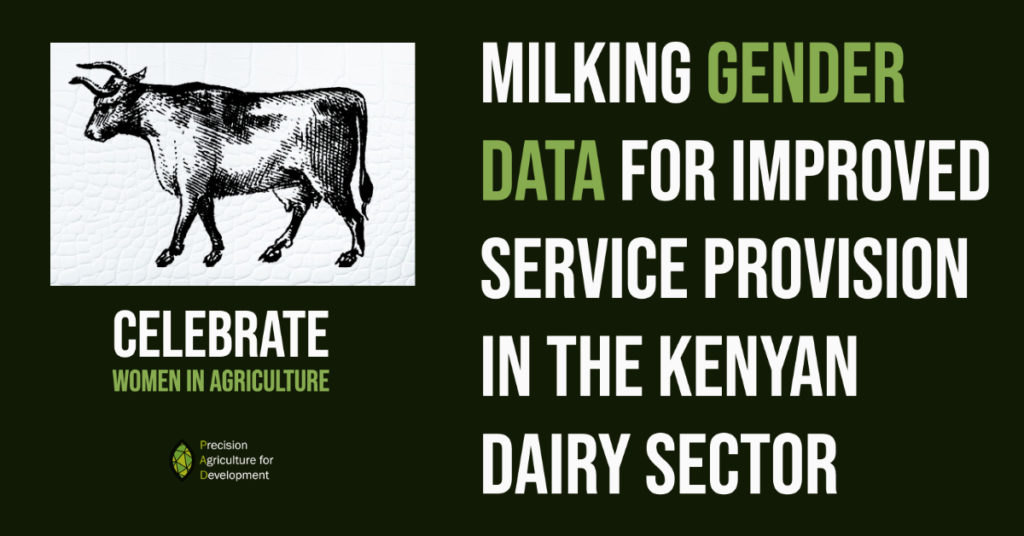
PAD empowers smallholder farmers across the developing world with actionable information to improve their wellbeing. However, there is evidence that digital advisory services like ours are underused by women. This summer we are expanding our agricultural advisory service in Kenya to the dairy sector, an arena in which women play a central role. As we prepare to launch, we are looking beyond one-size-fits-all solutions to more effectively address the unique needs, preferences, responsibilities, and constraints of female farmers.
This post is the first of two about a survey we are conducting in April 2021 to better understand gender roles and power dynamics in Kenyan dairy production and to better target our new service to the underserved needs of women in this sector. Here we describe the motivation and design of this survey. In a follow-up post, we will share insights from the results.
Invisible Women Farmers
In her spectacular book Invisible Women, Caroline Criado Perez details case after case in which service providers failed to deliver because they neglected to collect data about female users’ specific needs, preferences, and priorities.
The book cites the example of an organization seeking to provide “improved” seeds for staple crops: Male farmers cared more about increasing outputs. Women farmers, on the other hand, were more concerned with their input of time and labor in the field and in cooking the staple for household consumption. Since, adopting this new technology would require those doing the planting — women — to increase their time and effort, the seeds were not adopted.
Women often have less agency in agricultural and household financial decision-making. This is illustrated by Criado Perez who cites two failed attempts to introduce clean cookstoves capable of significantly reducing women’s exposure to toxic smoke. A model promoted in India required regular maintenance, which was considered men’s work. Since the new stoves improved women’s health, but didn’t directly affect men, stoves often fell into disrepair for want of maintenance. In Bangladesh, the fact that the clean cookstoves did not directly improve men’s outcomes, meant that they were not purchased at all, as men controlled household finances.
Understanding Context and Culture
Dairy is a sector of agricultural production in which tradition and gendered labor run deep. As we prepare to roll out our new advisory service, we commenced by focusing on a series of questions we need to answer to understand labor and decision-making dynamics in the sector, and within smallholder households more generally. These include:
- Who performs which tasks in the household, and within dairy farming specifically?
- Who holds the authority to make decisions?
- How systematically do users think about farming and what level of knowledge do they have about dairy farming? Does this differ by gender?
- Who controls household finances and for what types of purchases, and which accounts do they use?
- To what degree do women and men communicate about decisions and trust each other to make decisions in the interests of the household, even if one is the final arbiter of a particular decision?
The phone survey we designed to collect this information is due to be deployed in the field in early July, and will be asked to pairs of spouses. The goal is to obtain information to enable us to better target our services to both genders. By asking both men and women within the same household the same set of questions, we will be able to learn about typical responses for each gender, and we will also be able to note whether there are some questions for which we receive vastly different responses from a husband and wife within the same household.
Our survey will consist of six sections:
- Household Tasks and Time Use: This section will collect information about the gender(s) and age(s) of those performing various household tasks, including crop farming, livestock grazing, and water fetching. This section also attempts to account for household members’ time spent on other tasks, such as jobs outside the home and schoolwork. Information arising from this section will allow us to measure, for each time-use category, whether an activity is primarily performed by men, women, girls, or boys, or a combination thereof.
- Dairy Tasks: This section is similar to the Household Tasks and Time Use section, but focuses specifically on dairy farming, since the research team is most interested in using the results of this gender survey for informing the design and distribution of dairy advisory messages. This section will allow us to measure whether the following dairy tasks are primarily performed by men, women, girls, or boys: cleaning milking equipment, observing animals, giving cows water, feeding cows/calves, milking, milk transportation/sale, cleaning the housing unit (if zero-grazing or semi zero-grazing), sourcing/threshing fodder, spraying/dipping (for tick prevention), deworming, seeking veterinary treatment / artificial insemination (AI) services, identification (ear tagging), debudding/dehorning, hoof trimming, and grooming.
- Scenario-Based Questions: These are questions for which answers seek to understand respondents’ critical thinking abilities. An example of such a question would be: “Mrs Choge realized that to boost milk production beyond 7 litres a day, she needed to give her cow sufficient concentrates. For every 1.5 litres of milk above 7 litres, she gave 1 kg concentrate. How much concentrate should she give a cow producing 10 litres of milk per day?” We will disaggregate the results by gender to determine whether, on average, men or women think more systematically about dairy farming. This type of question tests the respondent’s causal reasoning, logical deduction, and systematic planning.
- Knowledge-Based Questions: This section is similar to the scenario-based section, but instead tests respondents on their technical dairy knowledge. As in that section, these questions have correct answers, and we will disaggregate the results by gender to determine whether, on average, men or women have more technical knowledge about dairy farming.
- Financial Decisions: This section will allow us to draw conclusions about who within the household holds financial power, with regards to purchases of productive assets, personal assets, and consumption goods. We will measure this empirically by collecting information, disaggregated by gender, on transaction amount as well as account type (digital/cash, joint/solo).
- Public Goods Game: In this section, respondents will be asked whether they want to augment the amount earned for participating in the survey by allocating a portion to a common account with their partner. A random amount will also be added to the survey by the research team, such that it is not possible for the respondent to lose money by completing this exercise, only to increase their earnings by a variable amount depending on the contribution made by both members of the spousal pair.1 This section allows us to collect data on trust within each spousal pair, which we assume to be correlated with the total amount contributed into the common account.
We plan to publish our findings to inform our own platform development and to make them available to other service providers and policy makers concerned with smart service design. In doing so, we plan to add to the existing body of research on gender and international development — a more complete review of which was published by my colleague Theresa Solenski in an earlier blog post.
Surveying the Evidence
Specifically, our research will add to the empirical evidence base on asymmetric information within the household. One study in Ghana found that on average, both men and women commonly underestimate or overestimate their spouse’s expenditures by more than 75%. Concerningly, this research found implications for profitability: the more imperfect the husband’s information about his wife’s expenditure, the lower the wife’s output/profit, and vice versa (Chen & Collins, 2014).
Another study from Uttar Pradesh provided an example in which women were less likely to adopt productivity-enhancing technology (in this case, laser land-leveling because they were less aware of its impact (Magnan et al. 2015)). Similarly, a study from Uganda in which agricultural videos were shown either jointly to a spousal pair, or separately to one member, found that information was not shared within the household when just one member was engaged (Lecoutere et al. 2019). These examples are particularly relevant to our work at PAD, as they highlight a way in which our service has the potential to fail: if our messages primarily reach men but women are charged with implementing the recommendations we provide (or vice versa), the suggested practices may not be adopted because we failed to get the information into the hands of women who can make it actionable.
Our survey will contribute to the literature on within-household asymmetric information in two ways. First, the sections on household tasks / time-use, dairy tasks, and finances will — in addition to providing information about gender roles — enable us to compare directly the wife’s knowledge of household affairs to that of her husband (and vice versa). Second, the sections quizzing respondents on dairy knowledge and testing of systematic thinking through scenario-based questions will measure within-household information asymmetries with respect to dairy farming.
Imperfect communication and limited trust also have implications for message adoption: Qualitative evidence from a focus group discussion with 113 male farmers and 141 female farmers in Malawi suggests that men often do not trust agricultural information received from their wives, and female farmers may be hesitant to suggest new agricultural practices for fear of retribution (Ragasa et. al., 2019). Another group of researchers partnered with Kakira Sugar Ltd., a large sugar company in Uganda that sources sugarcane through contracts with smallholder farmers, the vast majority of whom are men. This study implemented an intervention in which men were encouraged to transfer uncontracted blocks of sugarcane to their wives. Since both spouses needed to agree to the proposed intervention, whether the men were willing to do so provided in and of itself a measurement of trust. The researchers found a man was less willing to transfer the contract — i.e. was less trusting of his wife’s capabilities in this respect — if the household had fewer assets and/or expenditures, if his wife was not already involved in sugarcane farming, or if he had previously expressed a preference for managing the household’s finances himself (Ambler et al., 2021).
In our survey, we plan to collect novel data on trust within the household using the public goods game. Ambler et. al. applied a similar approach in their baseline survey, and collected time use data. They found that cooperation in the public goods game significantly predicted a husband’s willingness to transfer the contract to his wife, but time-use data collected did not have the same predictive power.
Finally, by collecting information on respondent demographics and knowledge alongside information about financial decision-making and intra-household communication and trust, our survey will add to existing literature about factors that influence bargaining power within the household. For example, a descriptive analysis of a Tanzania spousal dataset shows that a woman’s age, health, labor hours, and education were positively correlated with her authority to make decisions in the household; however, the number of children she had and her husband’s community standing were negatively correlated with this authority (Anderson et. al., 2017). In our survey, we plan to collect information on each respondent’s age, education level, and number of children, which we can use to disaggregate responses about financial decision-making and the amount contributed to the collective account in the public goods game. This will allow us to investigate whether factors similar to those observed in Tanzania hold weight in the Kenyan context.
Next Steps
We plan to begin the survey in early April and will interview approximately 600 dairy farmers via phone, over two rounds.2 We will first survey 300 respondents from dairy cooperatives, during which we will ask about contact information for their spouses. We will then complete a second round with the spouses of the first round participants.
The sample for the gender survey was constructed to select a representative sample for the two cooperatives interested in partnering with us for this survey, Sirikwa Dairies and General Limited and Katheri Dairy Farmers Cooperative Society. We chose these two cooperatives because they represent the two primary dairy producing regions in Kenya, and because they were able and willing to provide demographic information for their membership sufficient for us to stratify the sample by gender, total production, and total deductions on member accounts for expenses such as agrovet purchases, artificial insemination, veterinary services, and cash advances. This information will enable us to research intra-household gender dynamics for farmers of different levels of farming sophistication.
We expect this research will yield important insights, and we plan to publish the results in a subsequent blog post. The most important outcome, however, will be to improve our content and message delivery for the dairy farmers we serve.
_______________________________________
1. This approach has the added benefit of preventing the respondent from obtaining exact information about his/her partner’s contribution. We recognize that particularly female respondents may fear retribution if her partner were to discover her contribution and deem it insufficient. Our contribution is intended to prevent this outcome.
2. This number was arrived at using Cochrane’s (1977) formula with a margin of error 7.5% and confidence interval of 95% (both commonly accepted levels) to come to the following sample size of households for each dairy: 148 in Sirikwa and 145 from Katheri. Multiplying both numbers by two, we arrive at a minimum sample size of 586, which we round up to 600 for simplicity..
Theresa Solenski, PAD Global Research and Program Associate, reflects on the growing body of gender-focused evidence – generated by the field at large, and by colleagues at PAD – we can exercise to inform evidence-based interventions to improve the lives of women.
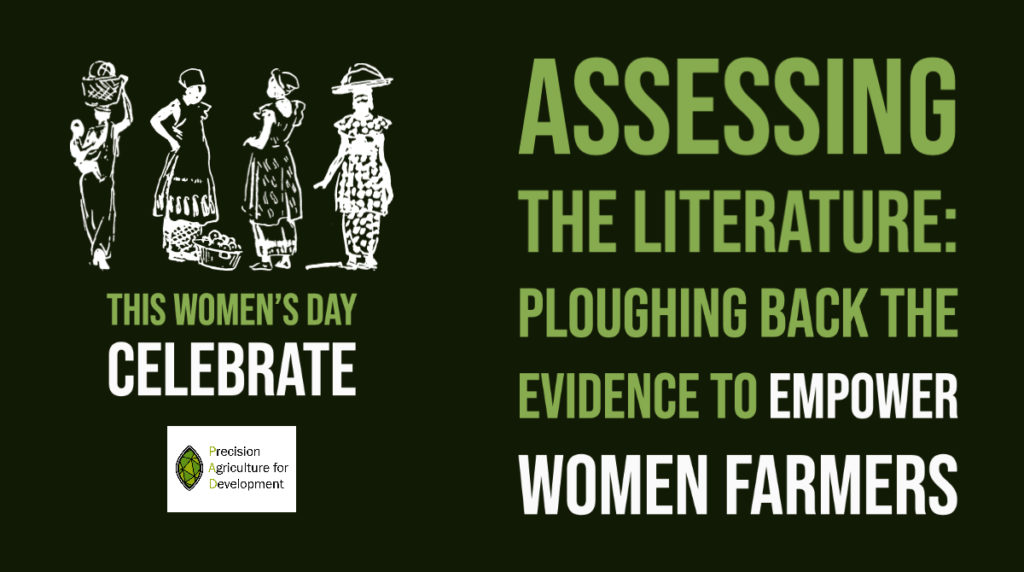
As we mark International Women’s Day, this blog post will reflect upon and celebrate the growing evidence-base of gender-focused research that is intended to inform evidence-based policies and laws to improve the lives of women. Experimental interventions and gender-focused surveys help to illuminate the unique barriers women face as women and reveal which solutions are most impactful for empowering women and reducing poverty. These interventions and their learnings provide a foundation for future policy work wherein positive impacts are replicated and iterated to benefit women in other contexts.
Much research has already been done at the intersection of gender and agriculture in developing countries, some by my colleagues and collaborators at Precision Agriculture for Development. Researchers know that women farmers confront various constraints (for example, constrained access to land, inputs,and finances) that are significantly different and usually more onerous than those faced by their male counterparts. Addressing these constraints can unleash significant agricultural productivity, to the benefit of households and communities more generally. For example, researchers know that women under-invest in plots when their land rights are not secure. In a study of a land tenure regularization program in Rwanda, investments in soil and water conservation (which are critical given the intensive use of land in Rwanda) increased by approximately 10 percentage points for male-headed households, but for female-headed households, these investments increased by almost twice as much (Ali et. al., 2014). One policy implication we can draw from this research is that strengthening women’s land rights can lead to larger per plot investments.
We also know that there is significant evidence that women face labor constraints when it comes to their agricultural productivity. Contributing factors include cultural norms which dictate that women should tend to children and the home, and constraints on women’s access to finances to hire labor or access labor-saving technologies (such as machines or animals). These types of gendered labor constraints can impact policy to the extent that some well-intentioned gender-sensitive interventions have had the negative effect of increasing women’s time poverty (Quisumbing & Pandolfelli, 2010). Taking these considerations into account, female-targeted interventions will be most productive when they focus on high impact behaviors and practices – those that produce significant gains in productivity with little or no increase in labor intensity.
Other research has focused on complicated intra-household dynamics that play a role in the empowerment and wellbeing of females in male-headed households. In particular, while women play a significant and active role in agricultural production, data reveals that they exercise decision-making authority on fewer activities than male-heads of household. An example is that husbands often make financial decisions without consulting their wives. Due to cultural norms, men are also often the ones who go to the market to both buy agricultural inputs and sell crop yields. This household dynamic frames an environment in which women are both unable to exercise decisions that impact their standard of living, and are unable to capture many of the gains associated with their labor despite their significant – often disproportionate – contribution to household production.
Interventions that target women with agricultural extension services can increase their agricultural decision-making ability in the household. A study of maize farmers in Uganda found that women who received agricultural information (either alone or jointly with their spouse) reported large, statistically significant increases in their decision-making ability (Lecoutere et. al., 2020). The same study found that in households where women were involved in receiving agricultural extension advisory, adoption and input use indices were statistically larger than those in the control group.
Moreover, research demonstrates that increasing women’s decision-making ability in agricultural tasks can lead to improved wellbeing. A study of dairy farmers in Uganda found that greater decision-making input on the part of women farmers into dairy production reduces women’s time poverty. The researchers’ model shows that women’s input in dairy production was likely to reduce women’s time poverty by approximately 97 per cent when they had some input (Bain et. al., 2018). This evidence is encouraging, and suggests that not only can agricultural information empower women farmers by increasing their decision-making abilities, but that this empowerment can improve productivity and wellbeing.
PAD functions both as a research generator and as an implementer of gender-focused learning. For example, PAD has developed a gender survey which measures time-use, financial decision-making, and gendered task-allocation among dairy farmers in Kenya. The survey deploys an innovative public goods game which is played by spouses as means for measuring trust and communication, and to reveal intra-household dynamics. The findings from this survey – which is currently being implemented – will be used to inform our Kenya dairy program, other programs like it, and will contribute to the literature on the influence of gender in dairy farming.
In its role as implementer, PAD has developed content to specifically address the needs of female farmers and we mass-disseminate this content via mobile phones. For example, in Odisha, India, we send messages focussed on the cultivation of kitchen garden to approximately 60,000 women. These messages cover content on crops in a domain that is typically under a woman’s decision-making purview. Messages were field-tested with women focus-groups and the advisory highlights the benefits of maintaining a kitchen garden, compost preparation, cultivation of crops, pest and disease management, and the nutritional value of kitchen garden crops. Our kitchen garden messages have received higher ratings than our regular Ama Krushi messages (4.2/5 vs 4/5) and women have indicated a strong preference for the kitchen garden content (87 percent of women reported a preference for the kitchen garden content over the traditional Ama Krushi messages).
Much work remains to be done. One challenge we face is to effectively target and communicate with female farmers through mobile phones. Globally, women are less likely to have access to the internet, to own their own phone, and to be literate (OECD, 2018; Baroni et. al., 2018). In order to effectively reach women, mobile interventions must be sensitive to these constraints, providing resources in mediums that women understand (for example, voice services rather than SMS and using local dialects where applicable). A further complicating factor is that many smallholder households only have one cell phone with all adults in the household sharing one device. As a consequence, the gender of the person on the receiving end of our service is often unclear. This can result in gender misclassification wherein the person who registered with our service is not necessarily the same person who engages with the platform. Moreover, PAD currently collects gender-related data in only half of its programs. However, we are committed to collecting gender data from all programs where feasible and to conduct quality checks when gender misclassification is suspected.
Experimentation and heterogeneity analysis inform our gender programming in contexts where we have gender data, and this allows us to iterate evidence-based programming to make it progressively more impactful in women’s lives. For example, in Uganda, PAD’s team has used A/B testing to more effectively understand whether matching the gender of the narrator’s voice [in an automated IVR call] with the gender of the recipient increases engagement with the platform. Results indicated that women listeners who switched from receiving calls with a male narrator to a female one, were almost 2 percent more likely to complete a call. Based on this evidence, future content in Uganda will be narrated by women.
We plan to continue on this path forward: leaning into the literature for guidance while generating and iterating the evidence-base through the use of A/B tests; focusing on developing and delivering high-impact content; improving intra-household coordination; and more effectively identifying and leveraging high-opportunity channels to communicate with women.
Maya Woser, Senior Research and Operations Associate, Stefania Pozzi, Global Senior Research Associate, and Yifan Powers, Global Senior Research Associate, pull on strands of evidence to assess the effects of patriarchal practices and cultures in the workplace and the effects of empowering women as role models and leaders, and concurrent effects for organizational development. The piece also integrates reflections from PAD colleagues Maureen Kuboka, Caitlin McKee, Claudia Carbajal Morelos, Sam Carter, Wafa Tahir, Maham Bokhari and Owen Barder.

Whether you live in the United States or India, the past 12 months have been a difficult time for women. The COVID-19 pandemic laid bare and exacerbated many structural inequalities and barriers that continue to make it difficult for women to fully participate in the workforce. It also highlighted the indelible value of women’s reproductive labor, which, in many respects, is the often invisible and unpaid work that allows our global economy to function. This is especially true for traditionally marginalized groups, as evidenced by the outsize impact of the pandemic on women of color in Western societies, and highlights the importance of intersectionality when thinking about how each society can best support women and families. Yet while the pandemic has shown how tenuous our progress in gender equality can be, it can also provide the momentum for profound change. As Arundhati Roy wrote, “the pandemic is a portal, a gateway between one world and the next” and we can take this opportunity, when everything seems broken, to move toward a new reality. In that spirit, and in honor of International Women’s Day, here are some reflections from staff at PAD on what factors, especially in the international development field, are important to consider when building a more gender equitable future.
Role Models
In a now seminal paper, Lori Beaman, Nobel Prize in Economics winner, Esther Duflo, Rohini Pande, and Petia Topalova found that while increasing the number of women in leadership positions in India did not impact structural labor market opportunities for young women, there was a strong, positive role model effect on young women’s perceptions of self-worth and the types of roles they could inhabit. The co-authors also found that increasing women representation in visible leadership positions changed the perception of others’- in this case parents – with regard to what girls can accomplish.
Beaman et al’s paper describes through rigorous experimental data an experience many women are personally familiar with – the profound impact of seeing women in positions of power and in positions they may not have been able to imagine themselves in before. In the workplace, particularly in traditionally male-dominated STEM professions such as economics, this means increasing the visibility of women through hiring, promotion, and keeping them in the workforce – not just in a few token leadership positions but systematically throughout an organization – can be crucial to closing the gender gap. Advancing gender equity is always going to be a work in progress and in the spirit of transparency, PAD can report that 40% of our current staff overall are women and about half of our management roles are occupied by women.
Reflections from PAD Staff
Maureen Kuboka, Agronomy Associate, PAD – Kenya
Why do you think having women as role models is important in the agronomy field?
It is important to have female role models in agronomy because they help you know that you can succeed in this male-dominated field. A role model or mentor can hold your hand and help you know how to make it. In my experience, they have challenged me and shown me that it can be done.
Have you ever had a woman as a role model or mentor, whether formal or informal, who impacted you in your career?
At my former workplace, I was inspired by the success of several senior female agronomists. I took that opportunity to observe and follow in their footsteps through “observational learning”. I am also still in touch with two senior lecturers who are women from my postgraduate degree and several of my former college classmates. We encourage one another in our respective fields of work and I am particularly challenged by college classmates who have been able to scale the ladder as well as those pursuing further education while they work. I am also keen to develop a formal relationship with a female mentor through the African Women In Agricultural Research and Development (AWARD) Fellowship.
How does having more women in the workplace make you feel about that workplace and does it change how you approach your work?
Having more women in the workplace makes me feel that women are being recognized and highlights how inclusivity is a powerful tool. It boosts my morale and feeling of having opportunities at work, as well as improves collaboration and teamwork. For example, I can comfortably share a personal issue with a female colleague and we can find a solution through discussing how they overcame a similar issue. I was elated by the recent appointment of Dr. Ngozi Okonjo- Iweala as the Directory-General of the World Trade Organization. She inspires me to picture myself as the next Director-General of the Food and Agriculture Organization of the United Nations (FAO).
Caitlin McKee, Global Research Support Manager
Why do you think having women as role models is important in academia/the development economics field?
As a woman, having a female role model in the workplace is important for your development, especially in navigating tricky decision points in your career trajectory like furthering your studies, switching jobs, or handling maternity leave. It’s also critical for shaping the lens through which you see your professional work. The perspectives of women, along with other minority perspectives, are critical to understanding the development economics field and identifying what kind of research questions to ask in the first place.
Have you ever had a woman as a role model or mentor, whether formal or informal, who impacted you in your career?
In graduate school at the University of Washington I worked for a research team led by Leigh Anderson and Mary Kay Gugerty. Despite incredibly busy schedules, these professors encouraged my learning, helped me develop critical skills, and pushed the bar of excellence for our work. There was also a gender-angle to much of the analysis that we did, not only on agricultural outcomes, but also on outcomes such as intra-household decision-making and time use, and they always emphasized the importance of gender-disaggregated data in any context. Their approach to crafting relevant research questions for women living in poverty reinvigorated me wanting to continue in the development field, using data as a tool to shed light on policy relevant questions.
How does having more women in the workplace make you feel about that workplace and does it change how you approach your work?
Workplaces are better with diversity of all kinds to bring different perspectives and experiences to doing the work itself and in setting organizational norms. Having more women in the workplace, especially in leadership and management positions, is an important part of that. At PAD I’m very pleased to get to report to our female Chief Economist and Director of Research, Tomoko Harigaya. Of the many reasons why I wanted to work for PAD, a solid group of women in leadership and management positions to work with closely was a very compelling reason.
Leadership
Despite progress in recent years in the number of women represented in leadership positions and in advances toward the achievement of equal opportunity, there are still strongly embedded gendered stereotypes about who a leader is. A study by Martin Abel found that both women and men react more negatively to criticism if it comes from a woman, and work by Gallup found that even women are more likely to report a preference for having a male boss compared to a female boss.
One explanation for these stereotypes may be actual differences in men’s and women’s leadership, but there is ongoing debate as to whether such differences exist. In a 2003 meta-analysis of 45 studies, Alice Eagly and Mary Johannesen-Schmidt found that women tend to use a more interactive style of management called transformational leadership, which emphasizes open communication, intellectual stimulation, and support for staff’s personal growth. The authors also found that women were more likely than men to deliver rewards to subordinates for appropriate performance. On the other hand, authors like Cliff, Langton, Aldrich and Andersen and Hansson claim that there are no significant gender differences in leadership styles. Another possible explanation is that these stereotypes originate from underlying beliefs, attitudes and mindsets about appropriate gender roles and behaviors: our expectations and gender biases might change the way we observe reality.
Either way, the presence of these stereotypes highlight the depth of challenges to women in leadership positions, especially those in traditionally male-dominated fields where the few women who make it to the top are often confronted with questions on their ability to lead. However, organizations can do a great deal of work that levels the field for women, principally by creating an environment that is free of discrimination and one in which talent can be evaluated on an individual basis and not according to latent gender stereotypes. This will not only grow the talent pool of potential leaders, but will also ensure that different perspectives are brought together to contribute to the multiple challenges society faces.
Reflections from PAD Staff
Claudia Carbajal Morelos, Regional Director for Latin America
What do you think are the most significant challenges that women leaders face in the development field?
Unfortunately and unsurprisingly, the challenges faced by women in the development field mirror those abroad in society. Here are three that are salient for me:
1. Credibility – I think when working with new people, women start out with a credibility deficit compared to their male peers. Women are placed with a greater burden of “proving” their credibility and need to exert more effort and be better prepared to earn an equal seat at the table.
2. Believing in yourself – Because society has conditioned women to doubt themselves more, or to exert less authority, women are more likely to caveat their perspectives or opinions. This can reduce the strength and effectiveness of their interventions. Women are also likely to question their qualifications when thinking of taking on new responsibilities. For example, men are more likely to apply to a position for which they don’t meet the criteria. Women are also more likely to volunteer for thankless or low-promotability tasks.
3. Speaking up – In my experience, women are less likely to speak up in meetings. This limits our influence and ability to recruit people to our ideas or initiatives.
Which piece of advice would you give to women who are trying to become leaders in the development field?
1. Find a mentor – Or find a few. Find people that share your vision and can help you advance your professional or personal goals. Recruit people that fully embrace your identity as a leader.
2. Be aware of internalized gender biases and how those affect your actions – It can be easy to fall into stereotypical attitudes or roles and it can be hard to identify those situations or actions. Find good resources that could help you understand what you are doing and how to change those behaviors. Be intentional with your actions and reflect on them frequently.
3. Trust yourself – Believing in yourself and your strengths is fundamental to applying your full self to your work. Identifying your weaknesses and working on them can be helpful, but don’t let that become your entire self-identity. Pay equal or greater attention to your strengths and leverage them widely.
4. Promote dialogue and diversity training in your workplace – Unfortunately, you don’t have control over how others’ biases affect you and you, alone, can’t change their net effect on your work. Actions on an individual level help, but action at an organizational-level is important to reduce the negative effects of bias.
Who inspired you and why?
I find Michelle Obama inspiring. She is a self-confident woman who stands up for what she believes in. She has fantastic communication skills that empower her to deliver complex messages to broad audiences. She is charismatic and has a strong character. She is perseverant and stubborn, while also compassionate. She is both privileged and well-grounded. She is relatable and accessible. I wished the world had more Michelle Obamas.
I was also inspired by Patricia Bellinger, a professor I had during graduate school. She teaches “The Art of Leading in a Diverse World” and included a lot of sessions on gender. She helped reshape my understanding of identity and gender and taught me how to move from micro-inequities to micro-affirmations.
Sam Carter, Global Research and Operations Manager
As a development practitioner we may often be working in contexts where the conversation on gender equity is just starting to gain traction. How do you balance incorporating a gender equity focus in your projects and advancing your project’s specific outcomes, which may be complicated by a gender lens, in those contexts?
To design a program that achieves a specific set of outcomes in any given context, we first need to understand the impediments preventing people from achieving those outcomes in the first place, and recognize that different groups face different sets of impediments. Conducting qualitative research to understand the barriers facing each group, and doing so in collaboration with local practitioners and researchers, should be a key part of designing any new project. Of course, gender is never the only source of inequity, so developing an understanding of the ways that other issues (caste, race, socioeconomic status, etc.) intersect with gender-related issues is a crucial piece of incorporating a gender lens.
For practitioners and researchers who would like to incorporate a gender lens in future work, this resource from my former colleagues at J-PAL offers practical guidance on measuring women’s empowerment and agency.
What leadership qualities do you think are important in your field and why?
I think empathy, humility, and compassion are crucial for effectively working across contexts and for being able to learn from others. Most of us who work on issues related to poverty reduction got started in the field because of a desire to improve the world and address inequality at some level. Leaders who embody that mission are able to inspire their colleagues, recognize their blind spots, and make space for all voices to be heard. It’s also important to be a clear and proactive communicator about both project-specific things like deadlines and deliverables, as well as big-picture strategy and vision.
Have you ever struggled as a woman to be seen as a leader? How did you work through those situations?
I’ve worked in a handful of environments where men’s voices were elevated and trusted at the expense of women’s voices, and where structural problems were ignored by defining the primary issue as being one of women lacking confidence. In those situations, I focused on noticing and writing down specific examples of how these biases were detrimental to the goals of the organization or project. I’ve also learned that leadership is more likely to take action on an issue when it is presented alongside a set of potential solutions. I worked with colleagues whom I trusted to come up with options that would be both impactful and feasible for the organization.
Overall, however, I’ve been privileged to spend most of my career working in organizations where women are given plenty of leadership opportunities, and to benefit from the mentorship and friendship of many incredible women (including the authors of this blog)!
Organizational Robustness
In both the private and public sectors organizations are increasingly turning to a “business case” for gender diversity. However gender diversity isn’t something to pursue for the sake of impressive statistics in annual reports, it is an organizational value that can strengthen teams and organizations. For example, research has shown that diversity, including gender diversity, at the leadership level is correlated with better financial performance. This may be because heterogeneous groups challenge each other and are more innovative, hence why “diverse teams are smarter.”
Within the field of development economics, there is suggestive evidence that women ask different research questions. Seema Jayachandran, inspired by a blog post by Rachel Glennerster who explored the critique of randomized controlled trials as dealing with “small” or less “macho” topics, looked at the percentage of women authors by topic in three relevant economics journals. She found there was some segregation in topics, including that women – unsurprisingly – tend to write more about gender and health. Women bring different perspectives to the research table, but the strength of these insights will reach their potential only if they’re given due consideration. This echoes research by Letian Zhang at the Harvard Business School: that the positive impact of gender diversity is only present in contexts where gender diversity is accepted and considered important.
To make diversity meaningful and continue to attract and retain diverse employees, organizations need to make structural changes to support that diversity. This is more salient than ever within the current COVID-19 pandemic, a time when shifts in work structures have led to an increase in working women’s, often unpaid, domestic and care work. This can, and has had, significant impacts on working women, especially mothers, across the world. For example, in the United States, an estimated one in four women is considering downshifting or leaving her job due to COVID-19, with a disproportionately negative impact on women of color. In many developing countries, women are primarily employed in informal sectors which have fewer social security nets and have been disproportionately hit by COVID-19. The pandemic and the associated increase in unpaid domestic and care work threatens to undo decades of progress in terms of women’s workforce participation.
Reflections from PAD Staff
Wafa Tahir, Research Associate, PAD – Pakistan
How has gender diversity affected your team or organization’s performance?
According to my past experience, working as the only woman on a team can be daunting and lead to multiple misunderstandings between team members. Being very new to PAD Pakistan, I experienced early on that gender diversity in the PAD Pakistan team has led to strong communication between the team members who support each other come what may, which in turn highly impact the team’s performance in a positive way.
Maham Bokhari, Research Associate, PAD – Pakistan
What does an inclusive workplace look like to you?
To me, the definition of an inclusive workplace is essentially about “cerebral equality.” This means that each person working for an organization is equal in all regards and subsequently will be offered equal opportunities, regardless of gender, age, race and religion. The only difference in each worker should be based upon the skills and cerebral knowledge that they bring to the table. I believe that inclusiveness for me shall rest on cerebral opportunities irrespective of any other parameters.
Wafa Tahir, Research Associate, PAD – Pakistan and Maham Bokhari, Research Associate, PAD – Pakistan
What factors from your experience make you feel supported and included as a woman in the workplace?
WT: The continuous help from my team members and their faith in my abilities make me feel included and supported. Moreover, at PAD, the support of our Management team, by acknowledging my work and giving me individual importance, has made me feel that my voice is heard and my opinions are important.
MB: Having worked in the public sector, I realized that being the only woman in large meeting rooms can often be unnerving. In such settings, women have historically been considered less “influential”. However, working as a young, aspiring woman at PAD, I have been offered immense support and guidance from fellow men and women in my team. Furthermore, my ideas, words, opinions and input has been valued at an equal weightage in meetings, as well as during routine working sessions.
Owen Barder, CEO
How has gender diversity played a part in your organization or team’s “performance”?
I’m passionate about gender diversity because I think creating an inclusive workplace is the right thing to do. It is also very good for the organisation, in at least four ways:
- Widens our talent pool: By recruiting and retaining women, we benefit from the skills and expertise of half the population.
- Broadens our perspectives. We benefit from the different points of view and it helps to understand the people we aim to serve. By making PAD more inclusive internally, we can do a better job of increasing inclusiveness and equity in the communities we serve.
- Builds better teams and improves organizational culture. In my experience, gender diverse teams collaborate better, are less macho, more supportive, and less competitive. Diverse teams tend to be more emotionally intelligent and draw the best out of all staff.
- A more inclusive workplace enables us to retain talent. Many organisations underestimate the costs of staff turnover in terms of lost expertise, the pressure caused by vacancies, and the cost, effort and risk of recruitment. By paying attention to inclusivity, we are more likely to keep more of our excellent staff.
What policies make a difference?
We need to listen carefully to staff members about what they think is important for creating an inclusive workplace. Some themes I have learned are important are:
- Fair and equal compensation – we are still in a world in which women are often paid less than men. We need to address this head on, by ensuring that salaries and benefits are set in a fair and transparent way.
- A culture of flexibility – recognising that different people have different commitments. We can offer flexibility in terms of working hours, location, working style and we can accomodate people who have to rearrange their work to deal with unexpected pressures (e.g. a school is closed). And we need to be disciplined about ensuring that discrimination does not creep in against those who exercise these flexibilities.
- An inclusive working culture – we must make sure that women are listened to and recognised in the workplace. Organisational culture can and does change, if people with power are self-aware and model good behaviour themselves.
- Tackling multi-dimensional discrimination – it is important to recognise that discrimination and privilege take multiple forms. Not just gender, but race, class, nationality, disability, sexuality, religion, physical appearance, and educational background can all affect a person’s opportunities. When we think about being more inclusive, we should be particularly thoughtful about the many different forms of discrimination that some people face and how these interact with each other.
- Role models, sponsors and mentors – by increasing the visibility of women in leadership roles, and supporting others to advance, we can ensure that women have more access to opportunities to advance their careers.
- Inclusive talent management – good leadership depends in part on spotting talent in the organisation and providing pathways for people to grow and succeed. Addressing biases in the way that talented colleagues are identified and supported can create a much more inclusive workplace.
How can we incorporate global values of gender diversity and equality while working within local contexts?
Precision Agriculture for Development is an increasingly global organisation that works in places with different cultural norms. I don’t regard these differences as a reason for us to equivocate on gender diversity – our sense of injustice about discrimination is the same for everyone everywhere; and our ambition to be fully inclusive is universal. Our commitment to being honest, humble and self critical should make us sensitive to differences across social contexts, but need not make us accept injustice.
As we create a more inclusive organisation, these differences may mean that we need to adopt different approaches to change in different places. For example, I recently took part in training on unconscious bias, intended to help me challenge my own perspective on inclusivity, which was organised here in the UK. The trainer had developed material which was particularly relevant for leaders in the UK. For example, class plays a much more prominent role in Britain than it might in other contexts, and that featured a lot in the training; while there was relatively little in the training about religion, which might have been given more weight in course for a different context. So while our ambitions are universal, differences between places might well lead us to conclude that particular problems are a higher priority in one team than another, or that we need to tackle problems in different ways from place to place.
In writing this post, a lot of what we learned reinforced what we already know: there is much work to be done. Just a few weeks ago, a New York Times piece reported on an upcoming research paper led by Pascaline Dupas and Alicia Sasser Modestino which studied the types of questions posed to economists at research seminars. They found significant evidence of gender discrimination and bias. Reading the comment section of the article, which was filled with similar stories of bias from women both within and outside economics, it’s clear this research affirmed an experience many women are all too familiar with. As development practitioners, we know that data is a powerful tool that can catalyze action, yet the data we need doesn’t always exist, as evidenced by the difficulty Dupas et al faced in further studying the experience of women of color in economics. It is therefore up to us all, using the strength of our diversity, to recognize what is missing and address it in our effort to build a more equitable future.
Make an Impact Today

